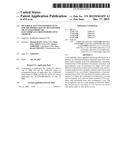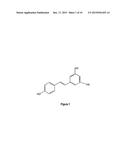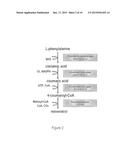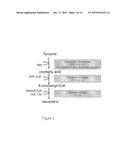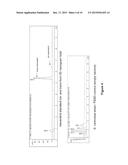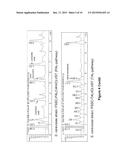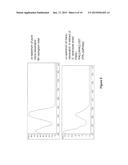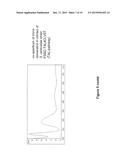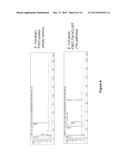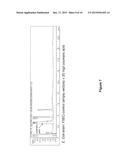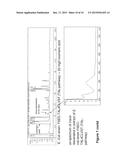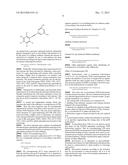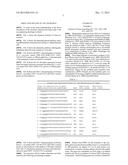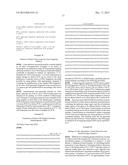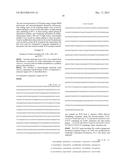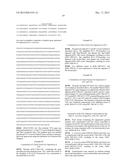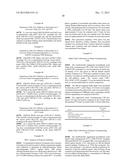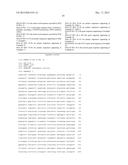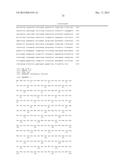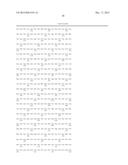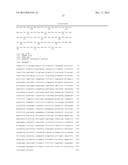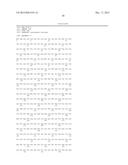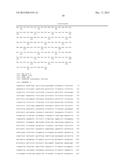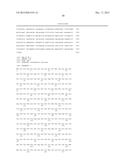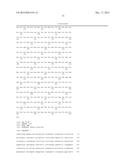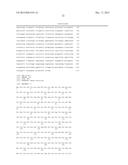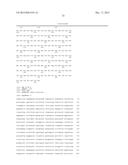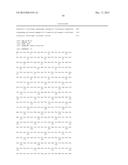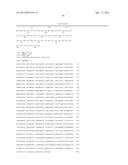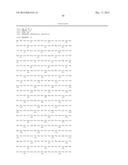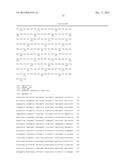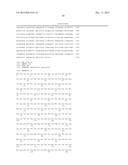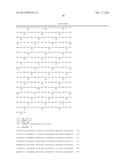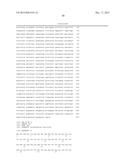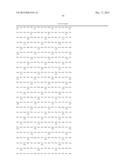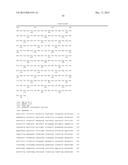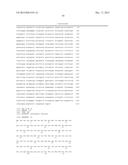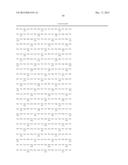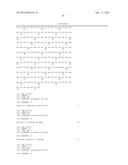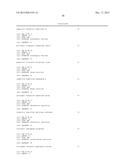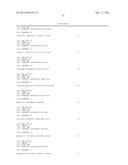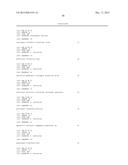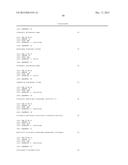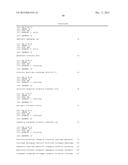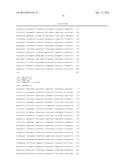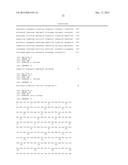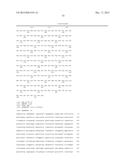Patent application title: METABOLICALLY ENGINEERED CELLS FOR THE PRODUCTION OF RESVERATROL OR AN OLIGOMERIC OR GLYCOSIDICALLY-BOUND DERIVATIVE THEREOF
Inventors:
Michael Katz (Malmo, SE)
Michael Katz (Malmo, SE)
Hans Peter Smits (Holte, DK)
Hans Peter Smits (Holte, DK)
Jochen Forster (Copenhagen, DK)
Jens Bredel Nielsen (Charlottenlund, DK)
IPC8 Class: AC12P722FI
USPC Class:
435156
Class name: Preparing oxygen-containing organic compound containing hydroxy group aromatic
Publication date: 2015-12-17
Patent application number: 20150361455
Abstract:
A recombinant micro-organism producing resveratrol by a pathway in which
phenylalanine ammonia lyase (PAL) produces trans-cinnamic acid from
phenylalanine, cinnamate 4-hydroxylase (C4H) produces 4-coumaric acid
from said trans-cinnamic acid, 4-coumarate-CoA ligase (4CL) produces
4-coumaroyl CoA from said 4-coumaric acid, and resveratrol synthase (VST)
produces said resveratrol from said 4-coumaroyl CoA, or in which
L-phenylalanine- or tyrosine-ammonia lyase (PAL/TAL) produces 4-coumaric
acid, 4-coumarate-CoA ligase (4CL) produces 4-coumaroyl CoA from said
4-coumaric acid, and resveratrol synthase (VST) produces said resveratrol
from said 4-coumaroyl CoA. The micro-organism may be a yeast, fungus or
bacterium including Saccharomyces cerevisiae, E. coli, Lactococcus
lactis, Aspergillus niger, or Aspergillus oryzae.Claims:
1. A genetically engineered micro-organism comprising an engineered
operative metabolic pathway producing resveratrol, or an oligomeric or
glycosidically-bound derivative thereof, wherein the engineered operative
metabolic pathway produces: a) 4-coumaric acid from L-phenylalanine
catalysed by a phenylalanine ammonia lyase and a cinnamate 4-hydroxylase
expressed in the micro-organism or from tyrosine catalysed by a
phenylalanine ammonia lyase or a tyrosine ammonia lyase expressed in said
micro-organism; and b) 4-coumaroyl-CoA from 4-coumaric acid catalysed by
a 4-coumarate-CoA ligase expressed in the micro-organism; wherein the
micro-organism further comprises a more than a native expression level of
an acetyl coenzymeA carboxylase (ACC1) enzyme.
2. The micro-organism of claim 1, wherein the resveratrol is produced in the micro-organism that is cultured in a media with a carbon substrate and does not require an external source of phenylalanine, tyrosine, cinnamic acid or coumaric acid, and resveratrol is produced from the 4-coumaroyl-CoA by a resveratrol synthase expressed in the micro-organism.
3. The micro-organism of claim 1, wherein the more than native expression level of the ACC1 enzyme has been provided by replacing a native promoter of a gene expressing the ACC1 enzyme with a promoter providing a higher level of expression.
4. The micro-organism of claim 3, wherein the native promoter is replaced with a strong constitutive yeast promoter.
5. The micro-organism of claim 4, wherein the strong constitutive promoter is a yeast promoter selected from the promoters for yeast genes: triosephoshosphate dehydrogenase 3 (TDH3), alcohol dehydrogenase 1 (ADH1), triose phosphate isomerase 1 (TPI1) 1 actin (ACTT), glyceraldehyde-3-phosphate dehydrogenase (GPD) and phosphoglucose isomerase (PGI).
6. The micro-organism of claim 1, wherein the more than native expression level of the ACC1 enzyme has been provided by recombinantly introducing into the micro-organism at least one copy of an exogenous genetic sequence encoding the ACC1 enzyme.
7. The micro-organism of claim 1, wherein the ACC1 enzyme is from Saccharomyces cerevisiae.
8. The micro-organism of claim 1, further comprising a more than a native expression level of a NADPH:cytochrome P450 reductase (CPR) enzyme.
9. The micro-organism of claim 8, wherein the more than native expression level of the CPR enzyme has been provided by replacing a native promoter of a gene expressing the CPR enzyme with a promoter providing a higher level of expression.
10. The micro-organism of claim 9, wherein the native promoter is replaced with a strong constitutive yeast promoter.
11. The micro-organism of claim 10, wherein the strong constitutive promoter is a yeast promoter selected from the promoters for yeast genes: triosephoshosphate dehydrogenase 3 (TDH3), alcohol dehydrogenase 1 (ADH1), triose phosphate isomerase 1 (TPI1) 1 actin (ACTT), glyceraldehyde-3-phosphate dehydrogenase (GPD) and phosphoglucose isomerase (PGI).
12. The micro-organism of claim 8, wherein the more than native expression level of the CPR enzyme has been provided by recombinantly introducing into the micro-organism at least one copy of an exogenous genetic sequence encoding the CPR enzyme.
13. The micro-organism of claim 8, wherein the CPR enzyme is from Saccharomyces cerevisiae.
14. The micro-organism of claim 1, wherein the micro-organism is a bacterium belonging to a genus selected from: Bacillus, Escherichia, Lactobacillus, Lactococcus, Corynebacterium, Acetobacter, Acinetobacter, and Pseudomonas.
15. The micro-organism of claim 14, wherein the micro-organism is Escherichia coli.
16. The micro-organism of claim 1, wherein the micro-organism is a yeast belonging to a genus selected from: Saccharomyces, Kluyveromyces, Pichia, Debaromyces, Hansenula, Pichia, Zygosaccharomyces and Schizosaccharomyces.
17. The micro-organism of claim 16, wherein the micro-organism is Saccharomyces cerevisiae.
18. The micro-organism of claim 1, wherein the micro-organism is a filamentous fungus belonging to a genus selected from: Rhizopus, Fusidium, Gibberella and Trichoderma.
19. The micro-organism of claim 1, wherein the operative metabolic pathway produces at least 0.25 milligrams resveratrol per gram on a dry weight basis of the genetically engineered micro-organism.
20. A method for producing resveratrol or an oligomeric or glycosidically-bound derivative thereof, comprising: a) cultivating the genetically engineered micro-organism of claim 1; and b) recovering the resveratrol, or the oligomeric or glycosidically-bound derivative thereof, from the culture media.
Description:
[0001] This application is a continuation in part of application Ser. No.
11/816,847 filed Aug. 22, 2007 as the national stage of
PCT/EP2006/060154, filed Feb. 21, 2006.
FIELD OF THE INVENTION
[0002] This invention relates generally to the production of the polyphenol resveratrol or an oligomeric or glycosidically bound derivative thereof such as its β-glucoside piceid using microbial cells. Furthermore, it relates to the use of naturally occurring or recombinant micro-organisms that produce resveratrol or such a derivative for production of food, feed and beverages.
BACKGROUND OF THE INVENTION
[0003] Production of chemicals from micro-organisms has been an important application of biotechnology. Typically, the steps in developing such a bio-production method may include 1) selection of a proper micro-organism host, 2) elimination of metabolic pathways leading to by-products, 3) deregulation of desired pathways at both enzyme activity level and the transcriptional level, and 4) overexpression of appropriate enzymes in the desired pathways. In preferred aspect, the present invention has employed combinations of the steps above to redirect carbon flow from phenylalanine or tyrosine through enzymes of the plant phenylpropanoid pathway which supplies the necessary precursor for the desired biosynthesis of resveratrol.
[0004] Resveratrol (or 3,4,5-trihydroxystilbene) is a phytophenol belonging to the group of stilbene phytoalexins, which are low-molecular-mass secondary metabolites that constitute the active defense mechanism in plants in response to infections or other stress-related events. Stilbene phytoalexins contain the stilbene skeleton (trans-1,2-diphenylethylene) as their common basic structure: that may be supplemented by addition of other groups as well (Hart and Shrimpton, 1979, Hart, 1981). Stilbenes have been found in certain trees (angio-sperms, gymnosperms), but also in some herbaceous plants (in species of the Myrtaceae, Vitaceae and Leguminosae families). Said compounds are toxic to pests, especially to fungi, bacteria and insects. Only few plants have the ability to synthesize stilbenes, or to produce them in an amount that provides them sufficient resistance to pests.
[0005] The synthesis of the basic stilbene skeleton is pursued by stilbene synthases. So far, two enzymes have been designated as a stilbene synthase; pinosylvine synthase and resveratrol synthase. To date, the groundnut (Arachis hypogaea) resveratrol synthase has been characterised in most detail, such that most of the properties are known (Schoppner and Kindl, 1984). Substrates that are used by stilbene synthases are malonyl-CoA, cinnamoyl-CoA or coumaroyl-CoA. These substances occur in every plant because they are used in the biosynthesis of other important plant constituents as well such as flavonoids, flower pigments and lipids. Resveratrol (FIG. 1 trans-form) consists of two closely connected phenol rings and belongs therefore to the polyphenols. While present in other plants, such as eucalyptus, spruce, and lily, and in other foods such as mulberries and peanuts, resveratrol's most abundant natural sources are Vitis vinifera, -labrusca, and -muscadine (rotundifolia) grapes, which are used to make wines. The compound occurs in the vines, roots, seeds, and stalks, but its highest concentration is in the skin (Celotti et al., 1996), which contains 50-100 μg/g. (Jang et al. 1997). During red wine vinification the grape skins are included in the must, in contrast to white wine vinification, and therefore resveratrol is found in small quantities in red wine only. Resveratrol has, besides its antifungal properties, been recognized for its cardioprotective- and cancer chemopreventive activities; it acts as a phytoestrogen, an inhibitor of platelet aggregation (Kopp et al, 1998; Gehm et al 1997; Lobo et al 1995), and an antioxidant (Jang et al., 1997; Huang 1997). These properties explain the so-called French Paradox, i.e. the wine-drinking French have a low incidence of coronary heart disease despite a low-exercise, high-fat diet. Recently it has been shown that resveratrol can also activate the SIR2 gene in yeast and the analogous human gene SIRT1, which both play a key role in extending life span. Ever since, attention is very much focused on the life-span extending properties of resveratrol (Hall, 2003, Couzin, 2004).
[0006] American health associations, such as the Life Extension Foundation, are promoting the vast beneficial effects of this drug, and thereby propelling the ideal conditions for a successful commercialisation. Present production processes rely mostly upon extraction of resveratrol, either from the skin of grape berries, or from Knot weed. This is a labour intensive process and generates low yield which, therefore, prompts an incentive for the development of novel, more efficient and high-yielding production processes.
[0007] In plants, the phenylpropanoid pathway is responsible for the synthesis of a wide variety of secondary metabolic compounds, including lignins, salicylates, coumarins, hydroxycinnamic amides, pigments, flavonoids and phytoalexins. Indeed formation of resveratrol in plants proceeds through the phenylpropanoid pathway. The amino acid L-phenylalanine is converted into trans-cinnamic acid through the non-oxidative deamination by L-phenylalanine ammonia lyase (PAL) (FIG. 2). Next, trans-cinnamic acid is hydroxylated at the para-position to 4-coumaric acid (4-hydroxycinnamic acid) by cinnamate-4-hydroxylase (C4H), a cytochrome P450 monooxygenase enzyme, in conjunction with NADPH:cytochrome P450 reductase (CPR). The 4-coumaric acid, is subsequently activated to 4-coumaroyl-CoA by the action of 4-coumarate-CoA ligase (4CL). Finally, resveratrol synthase (VST) catalyses the condensation of a phenylpropane unit of 4-coumaroyl-CoA with malonyl CoA, resulting in formation of resveratrol.
[0008] Recently, a yeast was disclosed that could produce resveratrol from 4-coumaric acid that is found in small quantities in grape must (Becker et al. 2003). The production of 4-coumaroyl-CoA, and concomitant resveratrol, in laboratory strains of S. cerevisiae, was achieved by co-expressing a heterologous coenzyme-A ligase gene, from hybrid poplar, together with the grapevine resveratrol synthase gene (vst1). The other substrate for resveratrol synthase, malonyl-CoA, is already endogenously produced in yeast and is involved in de novo fatty-acid biosynthesis. The study showed that cells of S. cerevisiae could produce minute amounts of resveratrol, either in the free form or in the glucoside-bound form, when cultured in synthetic media that was supplemented with 4-coumaric acid.
[0009] However, said yeast would not be suitable for a commercial application because it suffers from low resveratrol yield, and requires addition of 4-coumaric acid, which is only present in few industrial media. In order to facilitate and broaden the application of resveratrol as both a pharmaceutical and neutraceutical, it is therefore highly desirable to obtain a yeast that can produce resveratrol directly from glucose, without addition of 4-coumaric acid.
[0010] A recent study (Ro and Douglas, 2004) describes the reconstitution of the entry point of the phenylpropanoid pathway in S. cerevisiae by introducing PAL, C4H and CPR from Poplar. The purpose was to evaluate whether multienzyme complexes (MECs) containing PAL and C4H are functionally important at this entry point into phenylpropanoid metabolism. By feeding the recombinant yeast with [3H]-phenylalanine it was found that the majority of metabolized [3H]-phenylalanine was incorporated into 4-[3H]-coumaric acid, and that phenylalanine metabolism was highly reduced by inhibiting C4H activity. Moreover, PAL-alone expressers metabolized very little phenylalanine into cinnamic acid. When feeding [3H]-phenylalanine and [14C]-trans-cinnamic acid simultaneously to the triple expressers, no evidence was found for channeling of the endogenously synthesized [3H]-trans-cinnamic acid into 4-coumaric acid. Therefore, efficient carbon flux from phenylalanine to 4-coumaric acid via reactions catalyzed by PAL and C4H does not appear to require channeling through a MEC in yeast, and sheer biochemical coupling of PAL and C4H seems to be sufficient to drive carbon flux into the phenylpropanoid pathway. In yet another study (Hwang et al., 2003) production of plant-specific flavanones by Escherichia coli was achieved through expression of an artificial gene cluster that contained three genes of a phenyl propanoid pathway of various heterologous origins; PAL from the yeast Rhodotorula rubra, 4CL from the actinomycete Streptomyces coelicolor, and chalcone synthase (CHS) from the licorice plant Glycyrrhiza echinata. These pathways bypassed C4H, because the bacterial 4CL enzyme ligated coenzyme A to both trans-cinnamic acid and 4-coumaric acid. In addition, the PAL from Rhodotorula rubra uses both phenylalanine and tyrosine as the substrates. Therefore, E. coli cells containing the gene clusters and grown on glucose, produced small amounts of two flavanones, pinocembrin (0.29 g/l) from phenylalanine and naringenin (0.17 g/l) from tyrosine. In addition, large amounts of their precursors, 4-coumaric acid and trans-cinnamic acid (0.47 and 1.23 mg/liter respectively), were accumulated. Moreover, the yields of these compounds could be increased by addition of phenylalanine and tyrosine.
[0011] Whereas the enzyme from dicotylic plants utilizes only phenylalanine efficiently, several studies indicated that PAL from monocotylic plants, and some micro-organisms, utilizes tyrosine as well (Rosier et al., 1997). In such reactions the enzyme activity is designated tyrosine ammonia lyase (TAL, FIG. 3). Conversion of tyrosine by TAL results in the direct formation of 4-coumaric acid without the intermediacy of C4H and CPR. Mostly both activities reside on the same polypeptide and have very similar catalytic efficiencies, in spite of large differences in Km and turnover number. However, most PAL/TAL enzymes from plants prefer phenylalanine rather than tyrosine. The level of TAL activity is mostly lower than PAL activity, but the magnitude of this difference varies over a wide range. For example, the parsley enzyme has a Km for phenylalanine of 15-25 μM and for tyrosine 2.0-8.0 mM with turnover numbers 22 s-1 and 0.3 s-1 respectively. In contrast, the maize enzyme has a Km for phenylalanine only 15-fold higher than for tyrosine, and turnover numbers about 10-fold higher. Moreover, in the red yeasts, Rhodotorula glutinis (Rhodosporidium toruloides) and -rubra, the TAL catalytic activity is close to the PAL catalytic activity with a ratio of TAL/PAL of approximately 0.58. It is believed that the PAL enzyme in these yeasts degrades phenylalanine as a catabolic function and the trans-cinnamic acid formed is converted to benzoate and other cellular materials, whereas in plants it is thought to be merely a regulatory enzyme in the biosynthesis of lignin, isoflavonoids and other phenylpropanoids.
[0012] Recently, an open reading frame was found in the bacterium Rhodobacter capsulatus that encodes a hypothetical biosynthetic tyrosine ammonia lyase (TAL) that is involved in the biosynthesis of the chromophore of the photoactive yellow protein (Kyndt et al., 2002). This was the first time that a PAL-homologous gene was found in bacteria. The TAL gene was isolated and overproduced in Escherichia coli. The Km and kcat values for the conversion of tyrosine to 4-coumaric acid were 15.6 μM and 27.7 s-1 respectively, and for conversion of L-phenylalanine to trans-cinnamic acid were 1277 μM and 15.1 s-1 respectively. As a consequence of the smaller Km and a slightly larger kcat, the enzyme shows a strong preference for tyrosine over L-phenylalanine, with a catalytic efficiency (Km/kcat) for tyrosine of approximately 150-fold larger than for phenylalanine. The kinetic studies established that tyrosine, and not L-phenylalanine, is the natural substrate of the enzyme under physiological conditions. Very recently a study described the heterologous coexpression of phenylalanine ammonia lyase, cinnamate-4-hydroxylase, 4-coumarate-Coa-ligase and chalcone synthase, for the production of flavonoids in E. coli (Watts et al., 2004). The simultaneous expression of all four genes, however, was not successful because of a nonfunctional cinnamate-4-hydroxylase. The substitution of phenylalanine ammonia lyase and cinnamate-4-hydroxylase by a new tyrosine ammonia lyase that was cloned from Rhodobacter sphaeroides, could, however, solved the problem and led to high-level production of the flavonone naringenin. Furthermore, said tyrosine ammonia lyase from Rhodobacter sphaeroides is also used for heterologous production of 4-coumaric acid (i.e. para-hydroxycinnamic acid) in Escherichia coli (US-A-2004059103). Evenmore, further methods for development of a biocatalyst for conversion of glucose into 4-coumaric acid are described. US-A-2004023357 discloses a tyrosine ammonia lyase from the yeast Trichosporon cutaneum for the production of coumaric acid in Escherichia coli and Saccharomyces cerevisiae. US-A-2001053847 describes the incorporation of the wild type PAL from the yeast Rhodotorula glutinis into E. coli, underlining the ability of the wildtype PAL to convert tyrosine directly to 4-coumaric acid. Moreover, there is also exemplification of incorporation of the wildtype PAL from the yeast Rhodotorula glutinis, plus a plant C4H and CPR into E. coli and S. cerevisiae. Also described is the development of a biocatalyst through mutagenesis of the wild type yeast PAL Rhodotorula glutinis with enhanced TAL activity (US-A-6521748). Neither of the aforementioned patents claim the incorporation of 4CL and VST for the production of resveratrol.
[0013] Recently, evidence was shown that the filamentous fungi A. oryzae contained the enzyme chalcone synthase (CHS) that is normally involved in the biosynthesis of flavonoids, such as naringenin, in plants (Seshime et al., 2005). Indeed it was also shown that A. oryzae contained the major set of genes responsible for phenylpropanoid-flavonoid metabolism, i.e PAL, C4H and 4CL. However, there is no evidence that A. oryzae contained a stilbene synthase such as resveratrol synthase.
[0014] The present invention now provides a micro-organism having an operative metabolic pathway comprising at least one enzyme activity, said pathway producing 4-coumaric acid and producing resveratrol therefrom or an oligomeric or glycosidically-bound derivative thereof. Such a micro-organism may be naturally occurring and may be isolated by suitable screening procedures, but more preferably is genetically engineered.
[0015] Preferably, said resveratrol or derivative is produced in a reaction catalysed by an enzyme in which endogenous malonyl-CoA is a substrate, and preferably said resveratrol is produced from 4-coumaroyl-CoA.
[0016] Said resveratrol or derivative is preferably produced from 4-coumaroyl-CoA by a resveratrol synthase which is preferably expressed in said micro-organism from nucleic acid coding for said enzyme which is not native to the micro-organism.
[0017] Generally herein, unless the context implies otherwise, references to resveratrol include reference to oligomeric or glycosidically bound derivatives thereof, including particularly piceid.
[0018] Thus, in certain preferred embodiments, said resveratrol synthase is a resveratrol synthase (EC 2.3.1.95) from a plant belonging to the genus of Arachis, e.g. A. glabatra, A. hypogaea, a plant belonging to the genus of Rheum, e.g. R. tataricum, a plant belonging to the genus of Vitus, e.g. V. labrusca, V. riparaia, V. vinifera, or any one of the genera Pinus, Piceea, Lilium, Eucalyptus, Parthenocissus, Cissus, Calochortus, Polygonum, Gnetum, Artocarpus, Nothofagus, Phoenix, Festuca, Carex, Veratrum, Bauhinia or Pterolobium.
[0019] Preferably, said 4-coumaric acid is produced from trans-cinnamic acid, suitably by an enzyme in a reaction catalysed by said enzyme in which oxygen is a substrate, NADH or NADPH is a cofactor and NAD+ or NADP+ is a product.
[0020] Thus, said 4-coumaric acid may be produced from trans-cinnamic acid by a cinnamate 4-hydroxylase, which preferably is expressed in said micro-organism from nucleic acid coding for said enzyme which is not native to the micro-organism.
[0021] In certain preferred embodiments, including those referred to in the paragraphs above, said cinnamate-4-hydroxylase is a cinnamate-4-hydroxylase (EC 1.14.13.11) from a plant or a micro-organism. The plant may belong to the genus of Arabidopsis, e.g. A. thaliana, a plant belonging to the genus of Citrus, e.g. C. sinensis, C. x paradisi, a plant belonging to the genus of Phaseolus, e.g. P. vulgaris, a plant belonging to the genus of Pinus, e.g. P. taeda, a plant belonging to the genus of Populus, e.g. P. deltoides, P. tremuloides, P. trichocarpa, a plant belonging to the genus of Solanum, e.g. S. tuberosum, a plant belonging to the genus of Vitus, e.g. Vitus vinifera, a plant belonging to the genus of Zea, e.g. Z. mays, or other plant genera e.g. Ammi, Avicennia, Camellia, Camptotheca, Catharanthus, Glycine, Helianthus, Lotus, Mesembryanthemum, Physcomitrella, Ruta, Saccharum, Vigna. The micro-organism might be a fungus belonging to the genus Aspergillus, e.g. A. oryzae.
[0022] Preferably, said 4-coumaric acid is produced from tyrosine in a reaction catalysed by an enzyme in which ammonia is produced and suitably, said 4-coumaric acid is produced from tyrosine by a L-phenylalanine ammonia lyase or a tyrosine ammonia lyase, e.g. tyrosine ammonia lyase (EC 4.3.1.5) from yeast or bacteria. Suitably, the tyrosine ammonia lyase is from the yeast Rhodotorula rubra or from the bacterium Rhodobacter capsulatus.
[0023] Optionally, said tyrosine ammonia lyase is expressed in said micro-organism from nucleic acid coding for said enzyme which is not native to the micro-organism.
[0024] Alternatively, said trans-cinnamic acid may be produced from L-phenylalanine in a reaction catalysed by an enzyme in which ammonia is produced and suitably said trans-cinnamic acid is formed from L-phenylalanine by a phenylalanine ammonia lyase.
[0025] In certain preferred embodiments, said L-phenylalanine ammonia lyase is a L-phenylalanine ammonia lyase (EC 4.3.1.5) from a plant or a micro-organism. The plant may belong to the genus of Arabidopsis, e.g. A. thaliana, a plant belonging to the genus of Brassica, e.g. B. napus, B. rapa, a plant belonging to the genus of Citrus, e.g. C. reticulata, C. clementinus, C. limon, a plant belonging to the genus of Phaseolus, e.g. P. coccineus, P. vulgaris, a plant belonging to the genus of Pinus, e.g. P. banksiana, P. monticola, P. pinaster, P. sylvestris, P. taeda, a plant belonging to the genus of Populus, e.g. P. balsamifera, P. deltoides, P. Canadensis, P. kitakamiensis, P. tremuloides, a plant belonging to the genus of Solanum, e.g. S. tuberosum, a plant belonging to the genus of Prunus, e.g. P. avium, P. persica, a plant belonging to the genus of Vitus, e.g. Vitus vinifera, a plant belonging to the genus of Zea, e.g. Z. mays or other plant genera e.g. Agastache, Ananas, Asparagus, Bromheadia, Bambusa, Beta, Betula, Cucumis, Camellia, Capsicum, Cassia, Catharanthus, Cicer, Citrullus, Coffea, Cucurbita, Cynodon, Daucus, Dendrobium, Dianthus, Digitalis, Dioscorea, Eucalyptus, Gallus, Ginkgo, Glycine, Hordeum, Helianthus, Ipomoea, Lactuca, Lithospermum, Lotus, Lycopersicon, Medicago, Malus, Manihot, Medicago, Mesembryanthemum, Nicotiana, Olea, Oryza, Pisum, Persea, Petroselinum, Phalaenopsis, Phyllostachys, Physcomitrella, Picea, Pyrus, Quercus, Raphanus, Rehmannia, Rubus, Sorghum, Sphenostylis, Stellaria, Stylosanthes, Triticum, Trifolium, Triticum, Vaccinium, Vigna, Zinnia. The micro-organism might be a fungus belonging to the genus Agaricus, e.g. A. bisporus, a fungus belonging to the genus Aspergillus, e.g. A. oryzae, A. nidulans, A. fumigatus, a fungus belonging to the genus Ustilago, e.g. U. maydis, a bacterium belonging to the genus Rhodobacter, e.g. R. capsulatus, a yeast belonging to the genus Rhodotorula, e.g. R. rubra.
[0026] Suitably, said L-phenylalanine ammonia lyase is expressed in said micro-organism from nucleic acid coding for said enzyme which is not native to the micro-organism.
[0027] Preferably, 4-coumaroyl-CoA is formed in a reaction catalysed by an enzyme in which ATP and CoA are substrates and ADP is a product and suitably 4-coumaroyl-CoA is formed in a reaction catalysed by a 4-coumarate-CoA ligase.
[0028] Said 4-coumarate-CoA ligase may be a 4-coumarate-CoA ligase (EC 6.2.1.12) from a plant, a micro-organism or a nematode. The plant may belong to the genus of Abies, e.g. A. beshanzuensis, B. firma, B. holophylla, a plant belonging to the genus of Arabidopsis, e.g. A. thaliana, a plant belonging to the genus of Brassica, e.g. B. napus, B. rapa, B. oleracea, a plant belonging to the genus of Citrus, e.g. C. sinensis, a plant belonging to the genus of Larix, e.g. L. decidua, L. gmelinii, L. griffithiana, L. himalaica, L. kaempferi, L. laricina, L. mastersiana, L. occidentalis, L. potaninii, L. sibirica, L. speciosa, a plant belonging to the genus of Phaseolus, e.g. P. acutifolius, P. coccineus, a plant belonging to the genus of Pinus, e.g. P. armandii P. banksiana, P. pinaster, a plant belonging to the genus of Populus, e.g. P. balsamifera, P. tomentosa, P. tremuloides, a plant belonging to the genus of Solanum, e.g. S. tuberosum, a plant belonging to the genus of Vitus, e.g. Vitus vinifera, a plant belonging to the genus of Zea, e.g. Z. mays, or other plant genera e.g. Agastache, Amorpha, Cathaya, Cedrus, Crocus, Pestuca, Glycine, Juglans, Keteleeria, Lithospermum, Lolium, Lotus, Lycopersicon, Malus, Medicago, Mesembryanthemum, Nicotiana, Nothotsuga, Oryza, Pelargonium, Petroselinum, Rhyscomitrella, Picea, Prunus, Pseudolarix, Pseudotsuga, Rosa, Rubus, Ryza, Saccharum, Suaeda, Thellungiella, Triticum, Tsuga. The micro-organism might be a filamentous fungi belonging to the genus Aspergillus, e.g. A. flavus, A. nidulans, A. oryzae, A. fumigatus, a filamentous fungus belonging to the genus Neurospora, e.g. N. crassa, a fungus belonging to the genus Yarrowia, e.g. Y. lipolytica, a fungus belonging to the genus of Mycosphaerella, e.g. M. graminicola, a bacterium belonging to the genus of Mycobacterium, e.g. M. bovis, M. leprae, M. tuberculosis, a bacterium belonging to the genus of Neisseria, e.g. N. meningitidis, a bacterium belonging to the genus of Streptomyces, e.g. S. coelicolor, a bacterium belonging to the genus of Rhodobacter, e.g. R. capsulatus, a nematode belonging to the genus Ancylostoma, e.g. A. ceylanicum, a nematode belonging to the genus Caenorhabditis, e.g. C. elegans, a nematode belonging to the genus Haemonchus, e.g. H. contortus, a nematode belonging to the genus Lumbricus, e.g. L. rubellus, a nematode belonging to the genus Meloidogyne, e.g. M. hapla, a nematode belonging to the genus Strongyloidus, e.g. S. rattii, S. stercoralis, a nematode belonging to the genus Pristionchus, e.g. P. pacificus.
[0029] Optionally, a NADPH:cytochrome P450 reductase (CPR) has been recombinantly introduced into said micro-organism. This may be a plant CPR introduced into a non-plant micro-organism. Alternatively, a native NADPH:cytochrome P450 reductase (CPR) has been overexpressed in said micro-organism.
[0030] In certain preferred embodiments, including those referred to in the paragraphs above, said NADPH:cytochrome P450 reductase is a NADPH:cytochrome P450 reductase (EC 1.6.2.4) from a plant belonging to the genus of Arabidopsis, e.g. A. thaliana, a plant belonging to the genus of Citrus, e.g. C. sinensis, C. x paradisi, a plant belonging to the genus of Phaseolus, e.g. P. vulgaris, a plant belonging to the genus of Pinus, e.g. P. taeda, a plant belonging to the genus of Populus, e.g. P. deltoides, P. tremuloides, P. trichocarpa, a plant belonging to the genus of Solanum, e.g. S. tuberosum, a plant belonging to the genus of Vitus, e.g. Vitus vinifera, a plant belonging to the genus of Zea, e.g. Z. mays, or other plant genera e.g. Ammi, Avicennia, Camellia, Camptotheca, Catharanthus, Glycine, Helianthus, Lotus, Mesembryanthemum, Physcomitrella, Ruta, Saccharum, Vigna.
[0031] Whilst the micro-organism may be naturally occurring, preferably at least one copy of at least one genetic sequence encoding a respective enzyme in said metabolic pathway has been recombinantly introduced into said micro-organism.
[0032] Additionally or alternatively to introducing coding sequences coding for a said enzyme, one may provide one or more expression signals, such as promoter sequences, not natively associated with said coding sequence in said organism. Thus, optionally, at least one copy of a genetic sequence encoding a tyrosine ammonia lyase is operatively linked to an expression signal not natively associated with said genetic sequence in said organism, and/or at least one copy of a genetic sequence encoding a L-phenylalanine ammonia lyase is operatively linked to an expression signal not natively associated with said genetic sequence in said organism.
[0033] Optionally, at least one copy of a genetic sequence encoding cinnamate 4-hydroxylase, whether native or not, is operatively linked to an expression signal not natively associated with said genetic sequence in said organism.
[0034] Optionally, at least one copy of a genetic sequence encoding a 4-coumarate-CoA ligase, whether native or not, is operatively linked to an expression signal not natively associated with said genetic sequence in said organism.
[0035] Optionally, at least one copy of a genetic sequence encoding a resveratrol synthase, whether native or not, is operatively linked to an expression signal not natively associated with said genetic sequence in said organism.
[0036] Expression signals include nucleotide sequences located upstream (5' non-coding sequences), within, or downstream (3' non-coding sequences) of a coding sequence, and which influence the transcription, RNA processing or stability, or translation of the associated coding sequence. Such sequences may include promoters, translation leader sequences, introns, and polyadenylation recognition sequences.
[0037] In certain aspects the invention provides a metabolically engineered micro-organism having an operative metabolic pathway in which a first metabolite is transformed into a second metabolite in a reaction catalysed by a first enzyme, said reaction step producing ammonia, and in which said second metabolite is transformed into a third metabolite in a reaction catalysed by a second enzyme, in which oxygen is a substrate, NADPH or NADH is a cofactor and NADP+ or NAD+ is a product, and in which said third metabolite is transformed into a fourth metabolite in a reaction catalysed by a third enzyme in which ATP and CoA is a substrate, and ADP is a product, and in which said fourth metabolite is transformed into a fifth metabolite in a reaction catalysed by a fourth enzyme in which endogenous malonyl-CoA is a substrate.
[0038] The present invention also provides a metabolically engineered micro-organism having an operative metabolic pathway in which a first metabolite is transformed into a said third metabolite catalysed by a first enzyme, said reaction step producing ammonia, without the involvement of said second enzyme, and in which said third metabolite is transformed into a said fourth metabolite in a reaction catalysed by a said third enzyme in which ATP and CoA is a substrate, and ADP is a product, and in which said fourth metabolite is transformed into a said fifth metabolite in a reaction catalysed by a said fourth enzyme in which endogenous malonyl-CoA is a substrate.
[0039] The micro-organisms described above include ones containing one or more copies of an heterologous DNA sequence encoding phenylalanine ammonia lyase operatively associated with an expression signal, and containing one or more copies of an heterologous DNA sequence encoding cinnamate-4-hydroxylase operatively associated with an expression signal, and containing one or more copies of an heterologous DNA sequence encoding 4-coumarate-CoA-ligase operatively associated with an expression signal, and containing one or more copies of an heterologous DNA sequence encoding resveratrol synthase operatively associated with an expression signal.
[0040] They include also ones lacking cinnamate-4-hydroxylase activity, and containing one or more copies of a heterologous DNA sequence encoding tyrosine ammonia lyase operatively associated with an expression signal, and containing one or more copies of an heterologous DNA sequence encoding 4-coumarate-CoA-ligase operatively associated with an expression signal, and containing one or more copies of an heterologous DNA sequence encoding resveratrol synthase operatively associated with an expression signal.
[0041] In the present context the term "micro-organism" relates to microscopic organisms, including bacteria, microscopic fungi, including yeast.
[0042] More specifically, the micro-organism may be a fungus, and more specifically a filamentous fungus belonging to the genus of Aspergillus, e.g. A. niger, A. awamori, A. oryzae, A. nidulans, a yeast belonging to the genus of Saccharomyces, e.g. S. cerevisiae, S. kluyveri, S. bayanus, S. exiguus, S. sevazzi, S. uvarum, a yeast belonging to the genus Kluyveromyces, e.g. K. lactis K. marxianus var. marxianus, K. thermotolerans, a yeast belonging to the genus Candida, e.g. C. utilis C. tropicalis, C. albicans, C. lipolytica, C. versatilis, a yeast belonging to the genus Pichia, e.g. P. stipidis, P. pastoris, P. sorbitophila, or other yeast genera, e.g. Cryptococcus, Debaromyces, Hansenula, Pichia, Yarrowia, Zygosaccharomyces or Schizosaccharomyces. Concerning other micro-organisms a non-exhaustive list of suitable filamentous fungi is supplied: a species belonging to the genus Penicillium, Rhizopus, Fusarium, Fusidium, Gibberella, Mucor, Mortierella, Trichoderma.
[0043] Concerning bacteria a non-exhaustive list of suitable bacteria is given as follows: a species belonging to the genus Bacillus, a species belonging to the genus Escherichia, a species belonging to the genus Lactobacillus, a species belonging to the genus Lactococcus, a species belonging to the genus Corynebacterium, a species belonging to the genus Acetobacter, a species belonging to the genus Acinetobacter, a species belonging to the genus Pseudomonas, etc.
[0044] The preferred micro-organisms of the invention may be S. cerevisiae, A. niger, A. oryzae, E. coli, L. lactis or B. subtilis.
[0045] The constructed and engineered micro-organism can be cultivated using commonly known processes, including chemostat, batch, fed-batch cultivations, etc.
[0046] Thus, the invention includes a method for producing resveratrol or an oligomeric or glycosidically-bound derivative thereof comprising contacting a non-plant cell with a carbon substrate in the substantial absence of an external source of 4-coumaric acid, said cell having the capacity to produce resveratrol or an oligomeric or glycosidically-bound derivative thereof under the conditions, in which the micro-organism may be selected from the group consisting of fungi and bacteria, especially yeast.
[0047] Said carbon substrate is optionally selected from the group of fermentable carbon substrates consisting of monosaccharides, oligosaccharides and polysaccharides, e.g. glucose, fructose, galactose, xylose, arabinose, mannose, sucrose, lactose, erythrose, threose, and/or ribose. Said carbon substrate may additionally or alternatively be selected from the group of non-fermentable carbon substrates including ethanol, acetate, glycerol, and/or lactate. Said non-fermentable carbon substrate may additionally or alternatively be selected from the group of amino acids and may be phenylalanine and/or tyrosine.
[0048] In an alternative aspect, the invention includes a method for producing resveratrol or an oligomeric or glycosidically-bound derivative thereof through heterologous expression of nucleotide sequences encoding phenylalanine ammonia lyase, cinnamate 4-hydroxylase, 4-coumarate-CoA ligase and resveratrol synthase and also a method for producing resveratrol through heterologous expression of nucleotide sequences encoding tyrosine ammonia lyase, 4-coumarate-CoA ligase and resveratrol synthase.
[0049] The invention as described above has allowed the production of yeast cells producing high levels of resveratrol. Accordingly, the invention includes a micro-organism composition comprising micro-organism cells and at least 0.4 μg/g resveratrol on a dry weight basis produced in said micro-organism cells, preferably comprising at least 0.5 μg/g of said resveratrol, more preferably at least 200 μg/g. The stated level of resveratrol can be found in the yeast cells themselves. The composition may essentially consist of said yeast cells.
[0050] The resveratrol producing microorganisms described above and the pinosylvin producing organisms described in WO2008/009728 could desirably be improved to produce higher yields by redirecting the flux through the metabolism of the microorganism.
[0051] One option is to increase the amount malonyl-CoA available for further conversion into pinosylvin and resveratrol or other stilbenoids. Increasing the amount of malonoyl-CoA will have a positive effect on the production of all stilbenes of the type given in formula I
##STR00001##
[0052] R1, R2, R3, R4, and R5 independently are either --H or --OH because malonyl-CoA is responsible for the upper ring. The stilbene that is produced depends on the other organic acid component involved, where cinnamic acid gives pinosylvin and coumaric acid gives resveratrol. Caffeic acid will give piceatannol.
[0053] By increasing the amount of available malonyl-CoA the yield of stilbenoid can be increased. A first method involves overexpression of ACC1 to create the increased supply.
[0054] Thus, the invention further includes a recombinant micro-organism having an operative metabolic pathway in which one or more stilbenes according to the general formula I:
##STR00002##
are formed from a precursor optionally hydroxy-substituted phenyl-2-propenoic acid or ester thereof and malonyl-CoA by the action of a stilbene synthase, wherein the amount of malonyl-CoA available for use in said pathway has been increased by providing more than a native expression level of an enzyme catalysing the reaction
ATP+acetyl-CoA+HCO3-=ADP+phosphate-+malonyl-CoA.
[0055] Preferably, said more than native expression level of said enzyme has been provided by replacing a native promoter of a gene expressing said enzyme with a promoter providing a higher level of expression. For instance, said native promoter is replaced with a strong constitutive yeast promoter. The strong constitutive promoter may be the promoter of one of the yeast genes TDH3, ADH1, TPI1, ACT1, GPD, TEF1, TEF2, and PGI. The promoter may optionally be native to the yeast in which stilbenoid production is to be produced.
[0056] Alternatively or additionally, said more than native expression level of said enzyme has been provided by recombinantly introducing into said micro-organism at least one exogenous genetic sequence encoding a said enzyme. This may be an acetyl coenzymeA carboxylase (ACC1--EC No. 6.4.1.2).
[0057] A second and independent strategy which also increases the yield of the stilbenes is overexpression of CPR.
[0058] Thus, the micro-organism may be recombinantly engineered to produce more than a native amount of a cytochrome P450 reductase (CPR). This may be by replacing a native promoter of a gene expressing said CPR with a promoter providing a higher level of expression, for instance with a strong constitutive yeast promoter such as the promoter of one of the yeast genes TDH3, ADH1, TPI1, ACT1 GPD, TEF1, TEF2, and PGI, which optionally may be native to the yeast itself.
[0059] The micro-organism may comprise recombinantly introduced genes expressing a phenylalanine ammonia lyase, a cinnamate 4-hydroxylase and/or a coumarate-CoA ligase or appropriate enzymes for other stilbenes.
[0060] Effect of Overexpressing ACC1
[0061] Acetyl CoenzymeA carboxylase (ACC1 EC-Number 6.4.1.2) generates malonyl-CoA according to the below reaction:
(ACC1 Reaction)
ATP+acetyl-CoA+HCO3-=ADP+phosphate-+malonyl-CoA
[0062] By overexpressing ACC1 more malonyl-CoA is built up and this extra pool of malonyl-CoA is expected to generate more stilbenoids since the stilbene synthase reaction requires malonyl-CoA as building block for stilbene synthesis according to the reactions below:
[Resveratrol Synthase Reaction EC-Number 2.3.1.95]
[0063] 3 malonyl-CoA+4-coumaroyl-CoA=4 CoA+3,4',5-trihydroxystilbene+4 CO2
[Stilbene Synthase Reaction]
[0064] 3 malonyl-CoA+cinnamoyl-CoA=4 CoA+3,5-dihydroxystilbene+4 CO2
[General for any Hydroxyl Stilbene Synthase]
[0065] 3 malonyl-CoA+hydroxycinnamoyl-CoA=4 CoA+hydroxystilbene+4 CO2
[0066] Other appropriate organic acids substituting for 4-coumaroyl-CoA produce other stilbenoids.
Effect of Overexpressing CPR
[0067] Hydroxylases, such as cinnamate 4-hyroxylase (1.14.13.11), are cytochrome P450 monooxygenases that catalyse the insertion of one atom of oxygen into an organic substrate while the other oxygen atom is reduced to water. This reaction requires NADPH according to the below reaction for the hydroxylation of cinnamic acid:
trans-cinnamic acid+NADPH+H++O2=4-hydroxycinnamic acid+NADP++H2O
[0068] The active site of cytochrome P450 hydroxylases contains a heme iron center. The iron is tethered to the protein via a thiolate ligand derived from a cysteine residue. In general the mechanism is as follows:
1. The resting state of the protein is as oxidized Fe3+. 2. Binding of the substrate, cinnamic acid, initiates electron transport and oxygen binding. 3. Electrons are supplied to the p450 hydroxylase by another protein, either cytochrome P450 reductase (CPR), ferredoxins, or cytochrome b5 to reduce the heme iron. 4. Molecular oxygen is bound and split by the now reduced iron. 5. An iron-bound oxidant, oxidizes the substrate to an alcohol or an epoxide, regenerating the resting state of the p450 hydroxylase.
[0069] As described above CPR act as an electron carrier and donor for the NADPH dependent cytochrome P450 hydroxylase reaction. Thus by overexpressing CPR more electrons (NADPH) are generated for the NADPH dependent hydroxylation leading to more coumaric acid, and as a consequence more coumaric acid leads to more resveratrol by the resveratrol pathway. Similar considerations apply in the production of other stilbenoids.
[0070] Resveratrol or an oligomeric or glycosidically-bound derivative thereof or other stilbenoids so produced may be used as a nutraceutical in a dairy product or a beverage such as beer.
[0071] Resveratrol produced according to the invention may be cis-resveratrol or trans-resveratrol, but it is to be expected that the trans- form will normally predominate, as with other stilbenoids.
BRIEF DESCRIPTION OF THE DRAWINGS
[0072] To assist in the ready understanding of the above description of the invention reference has been made to the accompanying drawings in which:
[0073] FIG. 1 shows the chemical structure of trans-resveratrol;
[0074] FIG. 2 shows the phenylpropanoid pathway utilising phenylalanine ammonia lyase acting on L-phenylalanine; and
[0075] FIG. 3 shows the alternative pathway utilising phenylalanine ammonia lyase acting on L-tyrosine.
[0076] FIG. 4 shows the HPLC-chromatograms of extracts of S. cerevisiae strains FSSC-PALC4H4CLVST, FSSC-TAL4CLVST, grown on 100 g/l galactose. A chromatogram of 60 nanogram of pure resveratrol is included.
[0077] FIG. 5 shows the UV absorption spectrum for pure trans-resveratrol and trans-resveratrol produced by S. cerevisiae strain FSSC-PALC4H4CLVST, grown on 100 g/l galactose.
[0078] FIG. 6 shows the HPLC-chromatograms of extracts from E. coli strains FSEC-TAL4CLVST and FSEC-control, grown on 50 g/l glucose.
[0079] FIG. 7 shows the HPLC-chromatograms of extracts from E. coli strains FSEC-TAL4CLVST and FSEC-control, grown on 50 g/l glucose with addition of 20 mg/l coumaric acid. The UV absorption spectrum for trans-resveratrol produced in strain FSEC-TAL4CLVST is included.
[0080] The invention will be further described and illustrated by the following non-limiting examples.
EXAMPLES
Example 1
Isolation of Genes Encoding PAL, TAL, C4H, CPR, 4CL, and VST
[0081] Phenylalanine ammonia lyase (PAL2) (Cochrane et al., 2004; SEQ ID NO: 1, 2), cinnamate 4-hydroxylase (C4H) (Mizutani et al., 1997; SEQ ID NO: 3, 4) and 4-coumarate:CoenzymeA ligase (4CL1) (Hamberger and Hahlbrock 2004; Ehlting et al., 1999; SEQ ID NO: 5, 6) were isolated via PCR from A. thaliana cDNA (BioCat, Heidelberg, Germany) using the primers in table 1. PAL2 and 4CL1 were chosen amongst several A. thaliana homologues due to favourable kinetic parameters towards cinnamic acid and coumaroyl-CoA, respectively (Cochrane et al., 2004; Hamberger and Hahlbrock 2004; Ehlting et al., 1999).
[0082] The coding sequence of resveratrol synthase (VST) from Rheum tataricum (Samappito et al., 2003; SEQ ID NO: 7, 8) and tyrosine ammonia lyase (TAL) from Rhodobacter capsulatus (Kyndt et al., 2002; SEQ ID NO: 11, 12) were codon optimized for expression in S. cerevisiae using the online service backtranslation tool at www.entelechon.com, yielding sequence SEQ ID NO: 9, 10 and SEQ ID NO: 13, 14 respectively. Oligos for the synthetic gene assembly were constructed at MWG Biotech and the synthetic gene was assembled by PCR using a slightly modified method protocol of from Martin et al. (2003) described below.
TABLE-US-00001 TABLE 1 Primers and restriction sites for the amplification of genes Primer for amplification of gene* Restriction Restriction (Restriction sites are underlined) Gene site: primer site: vector 5'-CGGAATTCTCATGGATCAAATCGAAGCAATGTT PAL2 EcoRI EcoRI 5'-CGACTAGTTTAGCAAATCGGAATCGGAGC PAL2 SpeI SpeI 5'-CGCTCGAGAT ATGGACCTCCTCTTGCTGGA C4H XhoI XhoI 5'-CGGGTACCTTAACAGTTCCTTGGTTTCATAAC C4H KpnI KpnI 5'-GCTCTAGACCT ATGGCGCCACAAGAACAAGCAGTTT 4CL1 XbaI SpeI 5'-GCGGATCCCCT TCACAATCCATTTGCTAGTTT TGCC 4CL1 BamHI BglII 5'-CC GGATCCAAATGGCCCCAGAAGAGAGCAGG VST BamHI BamIII 5'-CG CTCGAGTTAAGTGATCAATGGAACCGAAGACAG VST XhoI XhoI 5'-CCGAATTCCCATGACCCTGCAATCTCAAACAGCTAAAG TAL EcoRI EcoRI 5'-CCACTAGTTTAAGCAGGTGGATCGGCAGCT TAL SpeI SpeI 5'-CCCTCGAGATCATGCCGTTTGGAATAGACAACACCGA CPR1 XhoI XhoI 5'-CCAAGCTTATCGGGCTGATTACCAGACATCTTCTTG CPR1 HindIII HindIII 5'-CCGGATCCCCATGTCCTCTTCTTCTTCTTCGTCAAC AR2 BamhI BamhI 5'-CCCTCGAGGTGAGTGTGTGGCTTCAATAGTTT CG AR2 XhoI XhoI *SEQ ID NOs 29-32
[0083] Primers from MWG for the assembly of the synthetic gene were dissolved in milliQ-water to a concentration of 100 pmole/μl. An aliquot of 5 μl of each primer was combined in a totalmix and then diluted 10-fold with milliQ water. The gene was assembled via PCR using 5 μl diluted totalmix per 50 μl as template for fusion DNA polymerase (Finnzymes). The PCR programme was as follows: Initial 98° C. for 30 s., and then 30 cycles with 98° C. for 10 s., 40° C. for 1 min. and 72° C. at 1 min./1000 basepairs, and a final 72° C. for 5 min. From the resulting PCR reaction, 20 μl was purified on 1% agarose gel. The result was a PCR smear and the regions around the wanted size were cut out from agarose gel and purified using the QiaQuick Gel Extraction Kit (Qiagen). A final PCR with the outer primers (for TAL and VST) in table 1 rendered the required TAL and VST genes. Point mutations were corrected using either the Quickchange site directed mutagenesis II kit (Stratagene, La Jolla, Calif.), or using PCR from overlapping error free DNA stretches from several different E. coli subclones.
[0084] NADPH:Cytochrome P450 reductase (CPR) from A. thaliana (AR2) (Mizutani and Ohta, 1998; SEQ ID NO: 17, 18) and from S. cerevisiae (CPR1) (Aoyama et al., 1978; SEQ ID NO: 15, 16), were isolated from A. thaliana cDNA (BioCat, Heidelberg, Germany) and S. cerevisae genomic DNA, respectively, using the primers in table 1.
Example 2
Construction of a Yeast Vector for Expression of PAL
[0085] The gene encoding PAL, isolated as described in example 1, was reamplified by PCR using forward- and reverse primers, with 5' overhangs containing EcoR1 and Spe1 restriction sites (table 1). The amplified PAL PCR product was digested with EcoR1/Spe1 and ligated into EcoR1/Spe1 digested pESC-URA vector (Stratagene), resulting in vector pESC-URA-PAL. The sequence of the gene was verified by sequencing of two different clones.
Example 3
Construction of a Yeast Vector for Expression of PAL and C4H
[0086] The gene encoding C4H, isolated as described in example 1, was amplified by PCR using the forward- and reverse primers, with 5' overhangs containing Xho1 and Kpn1 restriction sites. The amplified C4H PCR-product was digested with Xho1/Kpn1 and ligated into similarly digested pESC-URA-PAL vector. The resulting plasmid, pESC-URA-PAL-C4H, contained the genes encoding PAL and C4H under the control of the divergent GAL1/GAL10 promoter. The sequence of the gene encoding C4H was verified by sequencing of two different clones.
Example 4
Construction of a Yeast Vector for Expression of 4CL
[0087] The gene encoding 4CL was isolated as described in example 1. The amplified 4CL PCR-product was digested with Xba1/BamH1 and ligated into Spe1/BglII digested pESC-TRP vector (Stratagene), resulting in vector pESC-TRP-4CL. Two different clones of pESC-TRP-4CL were sequenced to verify the sequence of the cloned gene.
Example 5
Construction of a Yeast Vector for Expression of 4CL and VST
[0088] The gene encoding VST was isolated as described in example 1. The amplified synthetic VST gene was digested with BamH1/Xho1 and ligated into BamH1/Xho1 digested pESC-TRP-4CL (example 4). The resulting plasmid, pESC-TRP-4CL-VST, contained the genes encoding 4CL and VST under the control of the divergent GAL1/GAL10 promoter. The sequence of the gene encoding VST was verified by sequencing of two different clones of pESC-TRP-4CL-VST.
Example 6
Construction of a Yeast Vector for Expression of TAL
[0089] The gene encoding TAL was isolated as described in example 1. The amplified synthetic TAL gene was digested with EcoR1/Spe1 and ligated into EcoR1/Spe1-digested pESC-URA vector. The resulting plasmid, pESC-URA-TAL, contained the gene encoding for TAL under the control of the divergent GAL1/GAL10 promoter. The sequence was verified by sequencing of two different clones of pESC-URA-TAL.
Example 7
Construction of a Yeast Vector for Overexpression of S. cerevisiae Endogenous CPR
[0090] The gene encoding CPR from S. cerevisiae (CPR1) was isolated as described in example 1. The amplified CPR1 gene was digested with Xho1/HindIII and ligated into Xho1/HindIII-digested pESC-LEU vector (Stratagene), resulting in vector pESC-LEU-CPR1. The sequence was verified by sequencing of two different clones of pESC-LEU-CPR1.
Example 8
Construction of a Yeast Vector for Overexpression of A. thaliana CPR (AR2)
[0091] The gene encoding CPR from A. thaliana (AR2) was isolated as described in example 1. The amplified AR2 gene was digested with BamH1/Xho1 and ligated into BamH1/Xho1 digested pESC-LEU vector (Stratagene), resulting in vector pESC-LEU-AR2.
[0092] The sequence was verified by sequencing of two different clones of pESC-LEU-AR2.
Example 9
Expression of the Pathway to Resveratrol in the Yeast S. cerevisiae Using PAL, C4H, 4CL and VST
[0093] Yeast strains containing the appropriate genetic markers were transformed with the vectors described in examples 2, 3, 4, 5, 6, 7 and 8, separately or in combination. The transformation of the yeast cell was conducted in accordance with methods known in the art, for instance, by using competent cells or by electroporation (see, e.g., Sambrook et al., 1989). Transformants were selected on medium lacking uracil and/or tryptophan and streak purified on the same medium.
[0094] S. cerevisiae strain CEN.PK 113-5D (MATa ura3) was transformed separately with the vector pESC-URA-PAL (example 2), yielding the strain FSSC-PAL, and with pESC-URA-PAL-C4H (example 3), resulting in the strain FSSC-PALC4H. S. cerevisiae strain FS01267 (MATa trp1 ura3) was co-transformed with pESC-URA-PAL-C4H and pESC-TRP-4CL (example 4), and the transformed strain was named FSSC-PALC4H4CL. The same strain was also co-transformed with pESC-URA-PAL-C4H and pESC-TRP-4CL-VST (example 5), resulting in the strain FSSC-PALC4H4CLVST.
Example 10
Expression of the Pathway to Resveratrol in S. cerevisiae Using TAL, 4CL and VST
[0095] S. cerevisiae strain CEN.PK 113-5D (MATa ura3) was transformed separately with the vector pESC-URA-TAL (example 6), yielding the strain FSSC-TAL. S. cerevisiae strain FS01267 (MATa trp1 ura3) was co-transformed with pESC-URA-TAL (example 6) and pESC-TRP-4CL (example 4), and the transformed strain was named FSSC-TAL4CL. The same strain was also co-transformed with pESC-URA-TAL and pESC-TRP-4CL-VST (example 5), resulting in the strain FSSC-TAL4CLVST. Transformants were selected on medium lacking uracil and or tryptophan and streak purified on the same medium.
Example 11
Expression of the Pathway to Resveratrol in S. Cerevisiae with Overexpressed Endogenous CPR
[0096] S. cerevisiae strain FS01277 (MATa ura3 leu2 trp1) was co-transformed with vectors pESC-URA-PAL-C4H (example 3), pESC-TRP-4CL (example 4), and pESC-LEU-CPR1 (example 7). The transformed strain was named FSSC-PALC4H4CLVSTCPR. Transformants were selected on medium lacking uracil and/or tryptophan and streak purified on the same medium.
Example 12
Expression of the Pathway to Resveratrol in S. cerevisiae with Overexpressed A. thaliana CPR (AR2)
[0097] S. cerevisiae strain FS01277 (MATa ura3 leu2 trp1) was co-transformed with vectors pESC-URA-PAL-C4H (example 3), pESC-TRP-4CL (example 4), and pESC-LEU-AR2 (example 8). The transformed strain was named FSSC-PALC4H4CLVSTAR2. Transformants were selected on medium lacking uracil and or tryptophan and streak purified on the same medium.
Example 13
Fermentation with Recombinant Yeast Strains in Shake Flasks
[0098] The recombinant yeast strains were inoculated from agar plates with a sterile inoculation loop and grown in 200 ml defined mineral medium (Verduyn et al, 1992) that contained vitamins, trace elements, 5 g/l glucose and 40 g/l or 100 g/l galactose. The 500 ml stoppered shake flasks were incubated for three days at 30° C. and 160 rpm.
Example 14
Extraction of Resveratrol
[0099] Cells were harvested by centrifugation 5000 g for 5 minutes. An aliquot of 50 ml of supernatant was extracted once with 20 ml ethyl acetate. The ethyl acetate was freeze dried and the dry product redissolved in 0.7 ml methanol and filtered into HPLC vials.
[0100] The cell pellet from 200 ml medium was dissolved in 1 to 2 ml water and divided into 3 fastprep tubes and broken with glass beads. The crude extracts from the three tubes were pooled into 10 ml 100% methanol in a 50 ml sartorius tube and extracted on a rotary chamber for 48 hours in a dark cold room at 4° C. After 48 hours the cell debris was removed via centrifugation for 5 min. at 5000 g and the methanol was removed by freeze-drying overnight. The dried residue was redissolved in 1 ml phosphate-citrate buffer pH 5.4 and 10 units beta-glucosidase from almonds was added (Sigma) to release resveratrol from putatively glucoside-bound forms. The mixture was incubated for three hours at 37° C. and then extracted twice with 1 ml ethyl acetate. The combined ethyl acetate was freeze dried and the dry residue was redissolved in 0.7 ml methanol and filtered into HPLC vials.
Example 15
Analysis of Resveratrol
Thin Layer Chromatography
[0101] A method based upon thin layer chromatography that enabled the quick separation of cinnamic, coumaric and resveratrol on the same TLC-plate was developed for quick screening analysis. An aliquot of 1 ml culture containing both cells and supernatant were extracted with 500 microliter ethyl acetate and centrifuged for 30 s. at 13000 rpm with a microcentrifuge. The ethyl acetate was dried and redissolved in methanol. The extracts were analyzed on Silica G plates (0.2 mm Alugram SIL G/UV254, Macherey-Nagel) containing a fluorescent indicator. The mobile phase was a mixture of chloroform, ethyl acetate and formic acid (25:10:1).
HPLC
[0102] For quantitative analysis of cinnamic acid, coumaric acid, and resveratrol, samples were subjected to separation by high-performance liquid chromatography (HPLC) Agilent Series 1100 system (Hewlett Packard) prior to uv-diode-array detection at λ=306 nm. A Phenomenex (Torrance, Calif., USA) Luna 3 micrometer C18 (100×2.00 mm) column was used at 40° C. As mobile phase a gradient of acetonitrile and milliq water (both containing 50 ppm trifluoroacetic acid) was used at a flow of 0.4 ml/min. The gradient profile was linear from 15% acetonitrile to 100% acetonitrile over 20 min. The elution times were approximately 3.4 min. for coumaric acid, 5.5 min. for free trans-resveratrol and 6.8 min. for cinnamic acid.
[0103] Pure resveratrol standard was purchased from Cayman chemical company, whereas pure coumaric acid and cinnamic acid standards were purchased from and Sigma.
Results
[0104] Strains FSSC-PALC4H4CLVST and FSSC-TAL4CLVST, were cultivated on 100 g/l galactose as described in example 13, and analyzed for their content of intracellular resveratrol according to example 14 and 15. Additionally, a control strain FSSC-control was included that contained the empty vectors pESC-URA and pESC-TRP only. The HPLC-analysis showed that strains FSSC-PALC4H4CLVST and FSSC-TAL4CLVST contained a component with a retention time of 5.5 min. that was identical to trans-resveratrol (FIG. 4). Said result was confirmed by the UV absorption spectra that were similar to the absorption spectrum of pure trans-resveratrol (FIG. 5) as well, with a λmax of approximately 306 nm.
[0105] The results, therefore, demonstrated the presence of an active phenyl-propanoid pathway in S. cerevisiae that led to in vivo production of trans-resveratrol. The production of resveratrol can most likely be improved by cultivating the strains under well-defined growth conditions in batch- and continuous cultures, and/or optimizing the expression/activities of the individual enzymes.
Example 16
Construction of a Bacterial Vector for Expression of TAL in Escherichia coli
[0106] The gene encoding TAL, isolated as described in Example 1, was reamplified by PCR from the plasmid pESC-URA-TAL (example 6) using the forward primer 5'-CCG CTCGAG CGG ATG ACC CTG CAA TCT CAA ACA GCT AAA G-3' SEQ ID NO 33 and the reverse primer 5'-GC GGATCC TTA AGC AGG TGG ATC GGC AGC T-3' SEQ ID NO 34 with 5' overhangs containing the restriction sites XhoI and BamHI, respectively. The introduction of restriction sites at the 5' and 3' ends of the gene allowed ligation of the restricted PCR product into a pET16b vector (Novagen), digested with XhoI and BamHI to yield pET16b-TAL. The pET16b vector contained both the ampicillin resistance gene, and the T7 promoter. Hence, above procedure resulted in a vector with an antibiotic selection marker that contained the gene encoding for TAL under the control of the T7 promoter. The sequence of the gene encoding TAL was verified by sequencing of one clone of pET16b-TAL.
Example 17
Construction of a Bacterial Vector for Expression of 4CL and VST in Escherichia coli
[0107] The gene encoding VST, isolated as described in example 1, was cut out with the restriction enzymes BamHI and XhoI from the digested plasmid pESC-TRP-4CL-VST (example 5), which contains the genes encoding 4CL and VST. The VST gene was ligated into a pET26b vector (Novagen), containing the kanamycin resistance gene, digested with BamHI and SalI to yield pET26b-VST. The restriction enzymes XhoI and SalI have compatible ends, which enabled proper ligation. The pET26b vector contained both the kanamycin resistance gene, and the T7 promoter. Hence, above procedure resulted in a vector with an antibiotic selection marker that contained the gene encoding for VST under the control of the T7 promoter. The gene encoding for 4CL, isolated as described in example 1, was reamplified by PCR from the plasmid pESC-URA-4CL-VST (example 5) using the forward primer 5'-TG CCATGG CA ATGGCGCCAC AAGAACAAGC AGTTT-3' SEQ ID NO 35 and the reverse primer 5'-GC GGATCC CCT TCA CAA TCC ATT TGC TAG TTT TGCC-3' SEQ ID NO 36 with 5' overhangs containing the restriction sites NcoI and BamHI, respectively. The introduction of restriction sites at the 5' and 3' ends of the gene allowed ligation of the restricted PCR product into a pET16b vector (Novagen) digested with NcoI and BamHI. The resulting plasmid, pET16b-4CL, contained the gene encoding for 4CL under the control of the T7 promoter. Both the T7 promoter and the gene encoding for 4CL were reamplified as one fragment by PCR from the plasmid pET16b-4CL using the forward primer 5'-TT GCGGCCGC AAA TCT CGA TCC CGC GAA ATT AAT ACG-3' SEQ ID NO 37 and the reverse primer 5'-CG CTCGAG CCT TCA CAA TCC ATT TGC TAG TTT TGCC-3' SEQ ID NO 38 with 5' overhangs, containing the restriction sites NotI and XhoI, respectively. The introduction of restriction sites at the 5' and 3' ends of the DNA fragment allowed ligation of the restricted PCR product into the plasmid pET26b-VST that was digested with NotI and XhoI before ligation. The resulting plasmid, pET26b-VST-4CL, contained the two genes 4CL and VST that each were under control of an individual T7 promoter.
Example 18
Expression of the Pathway to Resveratrol in Escherichia Coli, Using TAL, 4CL and VST
[0108] The transformation of the bacterial cell was conducted in accordance with methods known in the art, for instance, by using competent cells or by electroporation (see, e.g., Sambrook et al., 1989). The E. coli strain BL21 (DE3) (Novagen) was co-transformed with the two vectors pET16b-TAL (example 16) and pET26b-VST-4CL (Example 17), resulting in strain FSEC-TAL4CLVST. In addition, E. coli strain BL21 (DE3) was co-transformed with the two empty vectors pET16b (Novagen) and pET26b (Novagen), resulting in strain FSEC-control, which was used as a control strain. Transformants were selected on Luria-Bertani (LB) medium with 100 μg/ml ampicillin and 60 μg/ml kanamycin.
Example 19
Fermentation with Recombinant Escherichia coli Strains in Shake Flasks
[0109] Pre-cultures of Escherichia coli BL21 (DE3) were grown in glass tubes at 160 rpm and 37° C. in 7 ml of LB medium containing 100 μg/ml ampicillin and 60 μg/ml kanamycin. Exponentially growing precultures were used for inoculation of 500 ml baffled shake flasks that contained 200 ml LB medium supplemented with 50 g/l glucose, 5 g/l K2HPO4, 80 μg/ml ampicilin and 50 μg/ml kanamycin, which were incubated at 160 rpm and 37° C. After 5 hours, isopropyl β-thiogalactopyranoside (IPTG) was added at a final concentration of 1 mM, as an inducer of the T7 promoter that was in front of each of the three genes TAL, 4CL and VST. After an incubation period of 48 hours at 37° C., the cells were harvested and subjected to extraction procedures and analysed for the presence of produced resveratrol.
Example 20
Extraction and Analysis of Resveratrol in Escherichia coli
[0110] Extraction and analysis was performed using the methods as described in example 14 and 15.
Results
[0111] Strain FSEC-TAL4CLVST and FSEC-control, were cultivated on 50 g/l glucose as described in example 19, and analyzed for their content of intracellular resveratrol according to example 14 and 15. The HPLC-analysis showed that strain FSEC-TAL4CLVST did contain considerable amounts of a component with a retention time of 3.4 min., which is identical to coumaric acid (FIG. 6). However, the extract did not contain a component that eluted at the same time as trans-resveratrol. Said result, therefore, indicated that the tyrosine ammonia lyase (TAL) was active indeed, but did not lead to production of detectable amounts of resveratrol. The lack of resveratrol formation, however, could be the result of; i) a non-functional coumarate-CoA ligase (4CL); ii) a non-functional resveratrol synthase (VST); iii) too low levels of coumaric acid, caused by either non-optimal cultivation conditions, or non-optimal expression/activity of TAL, or branching of coumaric acid into other products. To evaluate said hypotheses, the strains were grown on similar media as described in example 19 but now in the presence of 20 mg/l of coumaric acid. The subsequent HPLC-analysis of extracts of FSEC-TAL4CLVST indeed showed a cluster of peaks around the same retention time as trans-resveratrol, which was not observed in extracts of FS-control (FIG. 6). Indeed, the UV absorption spectrum of the peak with a retention time of 5.5 min. was similar to the spectrum of pure trans-resveratrol (FIG. 7), whereas no such spectrum could be obtained for peaks in the control strain. The results, therefore, strongly suggest the presence of an active phenylpropanoid pathway in Escherichia coli, which can lead to production of resveratrol. Most likely the production of resveratrol without addition of coumaric acid can be achieved by cultivating the strains under well-defined growth conditions in batch- and continuous cultures, and/or optimizing the expression/activities of the individual enzymes.
Example 21
Construction of a Bacterial Vector for Expression of PAL and C4H in Lactococcus lactis
[0112] The plasmid pSH71 and derivatives thereof, which is used in the following examples, is a bifunctional shuttle vector with multiple origins of replication from Escherichia coli and Lactococcus lactis. With that, the host range specificity traverses Escherichia coli and other species of lactic acid bacteria. Though transformations in Lactococcus lactis usually proceed without problems, putative difficult transformations in other species of lactic acid bacteria can, therefore, be overcome by using Escherichia coli as an intermediate host for the construction of recombinant plasmids. The plasmid contains one or more marker genes to allow the microorganism that harbour them to be selected from those which do not. The selection system that is used for Lactococcus lactis is based upon dominant markers, e.g. resistance against erythromycin and chloramphenicol, but systems based upon genes involved in carbohydrate metabolism, peptidases and food grade markers, have also been described. In addition, the plasmid contains promoter- and terminator sequences that allow the expression of the recombinant genes. Suitable promoters are taken from genes of Lactococcus lactis e.g. lacA. Furthermore, the plasmid contains suitable unique restriction sites to facilitate the cloning of DNA fragments and subsequent identification of recombinants.
[0113] In the examples below the plasmid contains either the erythromycine resistance gene, designated as pSH71-ERYr, or the chloramphenicol resistance gene, designated as pSH71-CMr
[0114] The gene encoding PAL, isolated as described in example 1, is reamplified by PCR from the plasmid pESC-URA-PAL-C4H (example 3), using forward- and reverse primers, with 5' overhangs containing suitable restriction sites. The introduction of said restriction sites at the 5' and 3' ends of the gene allows ligation of the restricted PCR product into a digested pSH71-ERYr vector that contains the lacA promoter from Lactococcus lactis. The resulting plasmid, pSH71-ERYr-PAL, contains the gene encoding PAL under the control of the lacA promoter from Lactococcus lactis. The gene encoding C4H, isolated as described in example 1, is reamplified by PCR from the plasmid pESC-URA-PAL-C4H (example 3) using forward- and reverse primers, with 5' overhangs containing suitable restriction sites. The introduction of said restriction sites at the 5' and 3' ends of the gene allows ligation of the restricted PCR product into a digested pSH71-CMr vector to yield pSH71-CMr-C4H. The lacA promoter and the gene encoding C4H are reamplified as one fragment by PCR from the plasmid pSH71-CMr-C4H using forward- and reverse primers, with 5' overhangs containing suitable restriction sites. The introduction of said restriction sites at the 5' and 3' ends of the DNA fragment allows ligation of the restricted PCR product into the digested plasmid pSH71-ERYr-PAL. The resulting plasmid, pSH71-ERYr-PAL-C4H, contains the genes encoding PAL and C4H that are each under the control of an individual lacA promoter. The sequence of the genes encoding PAL and C4H is verified by sequencing of two different clones of pSH71-ERYr-PAL-C4H.
Example 22
Construction of a Bacterial Vector for Expression of TAL in Lactococcus lactis
[0115] The gene encoding for TAL, isolated as described in example 1, is reamplified by PCR from the plasmid pESC-URA-TAL (example 6) using forward- and reverse primers, with 5' overhangs containing suitable restriction sites. The introduction of said restriction sites at the 5' and 3' ends of the gene allows ligation of the restricted PCR product into a digested pSH71-ERYr vector. The resulting plasmid, pSH71-ERYr-TAL, contains the gene encoding for TAL under the control of the lacA promoter from Lactococcus lactis. The sequence of the gene encoding for TAL is verified by sequencing of two different clones of pSH71-ERYr-TAL.
Example 23
Construction of a Bacterial Vector for Expression of 4CL and VST in Lactococcus lactis
[0116] The gene encoding 4CL, isolated as described in example 1, is reamplified by PCR from the plasmid pESC-TRP-4CL-VST (example 5), using forward- and reverse primers, with 5' overhangs containing suitable restriction sites. The introduction of said restriction sites at the 5' and 3' ends of the gene allows ligation of the restricted PCR product into a digested pSH71-CMr vector. The resulting plasmid, pSH71-CMr-4CL, contains the gene encoding for 4CL under the control of the lacA promoter from Lactobacillus lactis. The gene encoding VST, isolated as described in example 1, is reamplified by PCR from the plasmid pESC-TRP-4CL-VST (example 5) using forward- and reverse primers, with 5' overhangs containing suitable restriction sites. The introduction of said restriction sites at the 5' and 3' ends of the gene allows ligation of the restricted PCR product into a digested pSH71-ERYr vector. The resulting plasmid, pSH71-ERYr-VST, contains the gene encoding VST under the control of the lacA promoter from Lactococcus lactis. The lacA promoter and the gene encoding VST are reamplified as one fragment by PCR from the plasmid pSH71-ERYr-VST using forward- and reverse primers, with 5' overhangs containing suitable restriction sites. The introduction of said restriction sites at the 5' and 3' ends of the DNA fragment allows ligation of the restricted PCR product into the digested plasmid pSH71-CMr-4CL. The resulting plasmid, pSH71-CMr-4CL-VST, contains the genes encoding 4CL and VST that are each under the control of their individual lacA promoter.
[0117] The sequence of the genes encoding 4CL and VST is verified by sequencing of two different clones of pSH71-CMr-4CL-VST.
Example 24
Expression of the Pathway to Resveratrol in Lactococcus lactis
[0118] Lactococcus lactis strains are transformed with the vectors described in examples 21, 22 and 23, separately or in combination. The transformation of the bacterial cell is conducted in accordance with methods known in the art, for instance, by using competent cells or by electroporation (see, e.g., Sambrook et al., 1989). Transformants are selected on medium containing the antibiotics erythromycin and chloramphenicol and streak purified on the same medium.
[0119] Lactococcus lactis strain MG1363 is transformed separately with the vector pSH71-ERYr-TAL (example 22), yielding the strain FSLL-TAL; with pSH71-ERYr-PAL-C4H (example 21), yielding the strain FSLL-PALC4H and with pSH71-CMr-4CL-VST (example 23), yielding strain FSLL-4CLVST. In addition, Lactococcus lactis strain MG1363 is co-transformed with pSH71-ERYr-TAL (example 22) and pSH71-CMr-4CL-VST (example 23), and the transformed strain is named FSLL-TAL4CLVST. The same strain is also co-transformed with pSH71-ERYr-PAL-C4H (example 21), and pSH71-CMr-4CL-VST (example 23), resulting in the strain FSLL-PALC4H4CLVST.
Example 25
Fermentation with Recombinant Lactococcus lactis Strains in Fermentors
[0120] The recombinant yeast strains can be grown in fermenters operated as batch, fed-batch or chemostat cultures.
Batch and Fed-Batch Cultivations
[0121] The microorganism is grown in a baffled bioreactor with a working volume of 1.5 liters under anaerobic, aerobic or microaerobic conditions. All cultures are incubated at 30° C., at 350 rpm. A constant pH of 6.6 is maintained by automatic addition of 10 M KOH. Cells are grown on lactose in defined MS10 medium supplemented with the following components to allow growth under aerobic conditions: MnSO4 (1.25×10-5 g/l), thiamine (1 mg/l), and DL-6,8-thioctic acid (2.5 mg/l). The lactose concentration is, for example 50 g/l. The bioreactors are inoculated with cells from precultures grown at 30° C. in shake flasks on the medium described above buffered with threefold-higher concentrations of K2HPO4 and KH2PO4. Anaerobic conditions are ensured by flushing the medium with N2 (99.998% pure) prior to inoculation and by maintaining a constant flow of 50 ml/min of N2 through the headspace of the bioreactor during cultivation. The bioreactors used for microaerobic and aerobic cultivation are equipped with polarographic oxygen sensors that are calibrated with air (DOT, 100%) and N2 (DOT, 0%). Aerobic conditions are obtained by sparging the bioreactor with air at a rate of 1 vvm to ensure that the DOT is more than 80%. During microaerobic experiments the DOT is kept constant 5% by sparging the reactor with gas composed of a mixture of N2 and atmospheric air, at a rate of 0.25 vvm.
Chemostat Cultures
[0122] In chemostat cultures the cells can be grown in, for example, 1-L working-volume Applikon laboratory fermentors at 30° C. and 350 rpm. The dilution rate (D) can be set at different values, e.g. at 0.050 h-1, 0.10 h-1, 0.15 h-1, or 0.20 h-1. The pH is kept constant, e.g at 6.6, by automatic addition of 5 M KOH, using the growth medium described above, supplemented with antifoam (50 μl/l). The concentration of lactose can be set at different values, e.g. is 3.0 g/l 6.0 g/l, 12.0 g/l, 15.0 g/l or 18.0 g/l. The bioreactor is inoculated to an initial biomass concentration of 1 mg/l and the feed pump is turned on at the end of the exponential growth phase.
[0123] An anaerobic steady state is obtained by introducing 50 ml/min of N2 (99.998% pure) into the headspace of the bioreactor. Different anoxic steady states can obtained by sparging the reactor with 250 ml/min of gas composed of N2 (99.998% pure) and atmospheric air at various ratios. The oxygen electrode is calibrated by sparging the bioreactor with air (100% DOT) and with N2 (0% DOT).
[0124] For all conditions, the gas is sterile filtered before being introduced into the bioreactor. The off gas is led through a condenser cooled to lower than -8° C. and analyzed for its volumetric content of CO2 and O2 by means of an acoustic gas analyser.
[0125] Cultivations are considered to be in steady state after at least 5 residence times, and if the concentrations of biomass and fermentation end products remain unchanged (less than 5% relative deviation) over the last two residence times.
Example 26
Extraction and Analyis of Resveratrol in Lactococcus lactis
[0126] Extraction and analysis is performed using the methods as described in examples 14 and 15.
Example 27
Construction of a Fungal Vector for Expression of PAL and C4H in Species Belonging to the Genus Aspergillus
[0127] The plasmid that is used in the following examples, is derived from pARp1 that contains the AMA1 initiating replication sequence from Aspergillus nidulans, which also sustains autonomous plasmid replication in A. niger and A. oryzae (Gems et al., 1991). Moreover, the plasmid is a shuttle vector, containing the replication sequence of Escherichia coli, and the inherent difficult transformations in Aspergillus niger and Aspergillus oryzae can therefore overcome by using Escherichia coli as an intermediate host for the construction of recombinant plasmids. The plasmid contains one or more marker genes to allow the microorganism that harbour them to be selected from those which do not.
[0128] The selection system can be either based upon dominant markers e.g. resistance against hygromycin B, phleomycin and bleomycin, or heterologous markers e.g amino acids and the pyrG gene. In addition the plasmid contains promoter- and terminator sequences that allow the expression of the recombinant genes. Suitable promoters are taken from genes of Aspergillus nidulans e.g. alcA, glaA, amy, niaD, and gpdA. Furthermore, the plasmid contains suitable unique restriction sites to facilitate the cloning of DNA fragments and subsequent identification of recombinants.
[0129] The plasmid used in the following examples contains the strong constitutive gpdA-promoter and auxotropic markers, all originating from Aspergillus nidulans; the plasmid containing the gene methG that is involved in methionine biosynthesis, is designated as pAMA1-MET; the plasmid containing the gene hisA that is involved in histidine biosynthesis, is designated as pAMA1-HIS.
[0130] The gene encoding PAL, isolated as described in example 1, is reamplified by PCR from the plasmid pESC-URA-PAL-C4H (example 3), using forward- and reverse primers, with 5' overhangs containing suitable restriction sites. The introduction of said restriction sites at the 5' and 3' ends of the gene allows ligation of the restricted PCR product into a digested pAMA1-MET vector that contains the gpdA promoter from Aspergillus nidulans. The resulting plasmid, pAMA1-MET-PAL contains the gene encoding PAL under the control of the gpdA promoter from Aspergillus nidulans.
[0131] The gene encoding C4H, isolated as described in example 1, is reamplified by PCR from the plasmid pESC-URA-PAL-C4H (example 3) using forward- and reverse primers, with 5' overhangs containing suitable restriction sites. The introduction of said restriction sites at the 5' and 3' ends of the gene allows ligation of the restricted PCR product into a digested pAMA1-HIS vector to yield pAMA1-HIS-C4H. The gpdA promoter and the gene encoding C4H are reamplified as one fragment by PCR from the plasmid pAMA1-HIS-C4H using forward- and reverse primers, with 5' overhangs containing suitable restriction sites. The introduction of said restriction sites at the 5' and 3' ends of the DNA fragment allows ligation of the restricted PCR product into the digested plasmid pAMA1-MET-PAL. The resulting plasmid, pAMA1-MET-PAL-C4H, contains the genes encoding PAL and C4H that are each under the control of an individual pgdA promoter from Aspergillus nidulans. The sequence of the genes encoding PAL and C4H is verified by sequencing of two different clones of pAMA1-MET-PAL-C4H.
Example 28
Construction of a Fungal Vector for Expression of TAL in Species Belonging to the Genus Aspergillus
[0132] The gene encoding for TAL, isolated as described in example 1, is reamplified by PCR from the plasmid pESC-URA-TAL (example 6) using forward- and reverse primers, with 5' overhangs containing suitable restriction sites. The introduction of said restriction sites at the 5' and 3' ends of the gene allows ligation of the restricted PCR product into a digested pAMA1-MET vector. The resulting plasmid, pAMA1-MET-TAL, contains the gene encoding for TAL under the control of the gpdA promoter from Aspergillus nidulans. The sequence of the gene encoding for TAL is verified by sequencing of two different clones of pAMA1-MET-TAL.
Example 29
Construction of a Fungal Vector for Expression of 4CL and VST in Species Belonging to the Genus Aspergillus
[0133] The gene encoding 4CL, isolated as described in example 1, is reamplified by PCR from the plasmid pESC-TRP-4CL-VST (example 5), using forward- and reverse primers, with 5' overhangs containing suitable restriction sites. The introduction of said restriction sites at the 5' and 3' ends of the gene allows ligation of the restricted PCR product into a digested pAMA1-HIS vector that contains the gpdA promoter from Aspergillus nidulans. The resulting plasmid, pAMA1-HIS-4CL contains the gene encoding 4CL under the control of the gpdA promoter from Aspergillus nidulans. The gene encoding VST, isolated as described in example 1, is reamplified by PCR from the plasmid pESC-TRP-4CL-VST (example 5) using forward- and reverse primers, with 5' overhangs containing suitable restriction sites. The introduction of said restriction sites at the 5' and 3' ends of the gene allows ligation of the restricted PCR product into a digested pAMA1-MET vector to yield pAMA1-MET-VST. The gpdA promoter and the gene encoding VST are reamplified as one fragment by PCR from the plasmid pAMA1-MET-VST using forward- and reverse primers, with 5' overhangs containing suitable restriction sites. The introduction of said restriction sites at the 5' and 3' ends of the DNA fragment allows ligation of the restricted PCR product into the digested plasmid pAMA1-HIS-4CL. The resulting plasmid, pAMA1-HIS-4CL-VST, contains the genes encoding 4CL and VST that are each under the control of an individual pgdA promoter from Aspergillus nidulans. The sequence of the genes encoding 4CL and VST is verified by sequencing of two different clones of pAMA1-HIS-4CL-VST.
Example 30
Expression of the Pathway to Resveratrol in Aspergillus niger
[0134] Aspergillus niger strains are transformed with the vectors described in examples 27, 28 and 29, separately or in combination. The transformation of the fungal cell is conducted in accordance with methods known in the art, for instance, by electroporation or by conjugation (see, e.g., Sambrook et al., 1989). Transformants are selected on minimal medium lacking methionine and/or histidine.
[0135] A strain of Aspergillus niger that is auxotrophic for histidine and methionine, for instance, strain FGSC A919 (see http://www.fgsc.net), is transformed separately with the vector pAMA1-MET-TAL (example 28), yielding the strain FSAN-TAL; with pAMA1-MET-PAL-C4H (example 27), yielding the strain FSAN-PALC4H and with pAMA1-HIS-4CL-VST (example 29), yielding strain FSAN-4CLVST. In addition, Aspergillus niger strain FGSC A919 is co-transformed with pAMA1-MET-TAL (example 28) and pAMA1-HIS-4CL-VST (example 29), and the transformed strain is named FSAN-TAL4CLVST. The same strain is also co-transformed with pAMA1-MET-PAL-C4H (example 27), and pAMA1-HIS-4CL-VST (example 29), resulting in the strain FSAN-PALC4H4CLVST.
Example 31
Expression of the Pathway to Resveratrol in Aspergillus oryzae
[0136] A strain of Aspergillus oryzae that contains a native set of genes encoding for PAL, C4H and 4CL (Seshime et al., 2005) and that is auxotrophic for methionine, is transformed with the vector pAMA1-MET-VST (example 29), yielding the strain FSAO-VST. The transformation of the fungal cell is conducted in accordance with methods known in the art, for instance, by electroporation or by conjugation (see, e.g., Sambrook et al., 1989). Transformants are selected on minimal medium lacking methionine.
Example 32
Fermentation with Recombinant Strains of Aspergillus niger and Aspergillus oryzae in Fermentors
[0137] The recombinant yeast strains can be grown in fermenters operated as batch, fed-batch or chemostat cultures.
Batch and Fed-Batch Cultivations
[0138] The microorganism is grown in a baffled bioreactor with a working volume of 1.5 liters under aerobic conditions. All cultures are incubated at 30° C., at 500 rpm. A constant pH of 6.0 is maintained by automatic addition of 10 M KOH, and aerobic conditions are obtained by sparging the bioreactor with air at a rate of 1 vvm to ensure that the DOT is more than 80%. Cells are grown on glucose in defined medium consisting of the following components to allow growth in batch cultivations: 7.3 g/l (NH4)2SO4, 1.5 g/l KH2PO4, 1.0 g/l MgSO4.7H2O, 1.0 g/l NaCl, 0.1 g/l CaCl2.2H2O, 0.1 ml/l Sigma antifoam, 7.2 mg/l ZnSO4.7H2O, 1.3 mg/l CuSO4.5H2O, 0.3 mg/l NiCl2.6H2O, 3.5 mg/l MnCl2.4H2O and 6.9 mg/l FeSO4.7H2O. The glucose concentration is, for example, 10- 20-, 30-, 40- or 50 g/l. To allow growth in fed-batch cultivations the medium is composed of: 7.3 g/l (NH4)2SO4, 4.0 g/l KH2PO4, 1.9 g/l MgSO4.7H2O, 1.3 g/l NaCl, 0.10 g/l CaCl2.2H2O, 0.1 ml/l Sigma antifoam, 7.2 mg/l ZnSO4.7H2O, 1.3 mg/l CuSO4.5H2O, 0.3 mg/l NiCl2.6H2O, 3.5 mg/l MnCl2.4H2O and 6.9 mg/l FeSO4.H2O in the batch phase. The reactor is then fed with, for example, 285 g/kg glucose and 42 g/kg (NH4)2SO4.
[0139] Free mycelium from a pre-batch is used for inoculating the batch- and fed-batch cultures. A spore concentration of 2.109 spores/l is used for inoculation of the pre-batch culture at pH 2.5. Spores are obtained by propagation of freeze-dried spores onto 29 g rice to which the following components are added: 6 ml 15 g/l sucrose, 2.3 g/l (NH4)25 O4, 1.0 g/l KH2PO4, 0.5 g/l MgSO4.7H2O, 0.50 g/l NaCl, 14.3 mg/l ZnSO4.7H2O, 2.5 mg/ CuSO4.5H2O, 0.50 mg/l NiCl2.6H2O, and 13.8 mg/l FeSO4.7H2O. The spores are propagated at 30° C. for 7-14 days to yield a black layer of spores on the rice grains and are harvested by adding 100 ml of 0.1% Tween 20 in sterile water. For all conditions, the gas is sterile filtered before being introduced into the bioreactor. The off gas is led through a condenser cooled to lower than -8° C. and analyzed for its volumetric content of CO2 and O2 by means of an acoustic gas analyser.
Chemostat Cultures
[0140] In chemostat cultures the cells can be grown in, for example, 1.5-L working-volume Biostat B laboratory fermentors at 30° C. and 500 rpm. A constant pH of 6.0 is maintained by automatic addition of 10 M KOH, and aerobic conditions are obtained by sparging the bioreactor with air at a rate of 1 vvm to ensure that the DOT is more than 80%. The dilution rate (D) can be set at different values, e.g. at 0.050 h-1, 0.10 h-1, 0.15 h-1, or 0.20 h-1. The pH is kept constant, e.g at 6.6, by automatic addition of 10 M KOH, using a minimal growth medium with the following components: 2.5 g/l (NH4)2SO4, 0.75 g/l KH2PO4, 1.0 g/l MgSO4.7H2O, 1.0 g/l NaCl, 0.1 g/l CaCl2.2H2O, 0.1 ml/l Sigma antifoam, 7.2 mg/l ZnSO4.7H2O, 1.3 mg/l CuSO4.5H2O, 0.3 mg/l NiCl2.6H2O, 3.5 mg/l MnCl2.4H2O and 6.9 mg/l FeSO4.7H2O. The concentration of glucose can be set at different values, e.g. is 3.0 g/l 6.0 g/l, 12.0 g/l, 15.0 g/l or 18.0 g/l. The bioreactor is inoculated with free mycelium from a pre-batch culture as described above, and the feed pump is turned on at the end of the exponential growth phase.
[0141] For all conditions, the gas is sterile filtered before being introduced into the bioreactor. The off gas is led through a condenser cooled to lower than -8° C. and analyzed for its volumetric content of CO2 and O2 by means of an acoustic gas analyser.
[0142] Cultivations are considered to be in steady state after at least 5 residence times, and if the concentrations of biomass glucose and composition of the off-gas remain unchanged (less than 5% relative deviation) over the last two residence times.
Example 33
Extraction and Analysis of Resveratrol in Aspergillus niger and Aspergillus oryzae
[0143] Extraction and analysis is performed using the methods as described in examples 14 and 15.
Example 34
Over-Expression of Native Yeast Genes by Gene Targeting Method
[0144] Over-expression of native yeasts genes with constitutive yeast promoters is carried out by means of a promoter-replacement method based on a linear, PCR-generated gene-targeting substrate and using K. lactis URA3 as a recyclable marker described previously (Erdeniz et al, 1997). This method includes the generation of an intermediate yeast strain, where the Kluyveromyces lactis URA3 marker gene is integrated in combination with two copies of the strong constitutive promoter sequence as a direct repeat on each side of the marker gene. The marker gene is then looped out through recombination mediated by the direct repeat, an event which is selected for by plating the intermediate strain on medium containing 5-fluoroorotic acid (5-FOA), which is toxic to cells expressing the URA3 gene. The result is a yeast strain, in which the native promoter has been replaced with the strong constitutive promoter. Integration of the above described promoter sequence and marker gene is directed to the correct location in the genome by means of PCR-generated target sequences.
[0145] The above described gene-targeting substrate can be constructed by means of multiple rounds of fusion-PCR. However, to avoid introduction of PCR-generated mutations, it is beneficial to use a bi-partite or even a quadruple gene-targeting substrate (Erdeniz et al, 1997).
Example 35
Over-Expression of Native Yeast Genes by Bi-Partite Gene Targeting Substrate Method
[0146] For example to overexpress a gene with the strong ADH1 promoter, this promoter has been introduced into intermediate working vectors on either side of K. lactis URA3, resulting in the vectors pWAD1, pWAD2, (WO/2005/118814). With these vectors as templates, fragments can be amplified that contain (in the 5' to 3' direction) 1) the ADH1 coupled to two thirds of K. lactis URA3 towards the 5' end, using the primers AD-fw and Int3', and 2) two thirds of K. lactis URA3 towards the 3' end coupled to the ADH1, using the primers Int5' and AD-rv. Target sequences corresponding to a 300-500 bp sequence upstream of the gene to be overexpressed and a 300-500 bp starting with ATG of the gene to be overexpressed, are amplified from genomic yeast DNA using suitable primers. The reverse primer used for amplification of the upstream target sequence contains a 5' overhang that allows fusion to fragment 1 described above. The forward primer used for amplification of the target sequence starting with ATG contains a 5' overhang that allows fusion with fragment 2 described above. Following fusion by PCR of the upstream target sequence with fragment 1, and fusion by PCR of fragment 2 with the target sequence starting with ATG, the two linear substrates as shown in FIG. 6 are ready for transformation.
Example 36
Construction of a Strain Overexpressing Native S. cerevisiae NADP-Cytochrome P450 Reductase
[0147] The native promoter of S. cerevisae NADP-cytochrome P450 reductase CPR1 gene (encoded by YHR042W) was replaced with the constitutive S. cerevisiae alcohol dehydrogenase ADH1 promoter via chromosomal promoter exchange using the "bi-partite" PCR-based allele replacement method as described in example 34 and 35. Primers A and B were used to generate fragment CPR1-UP (Table 1) via PCR at a melting temperature of 56° C. using S. cerevisiae genomic DNA as template. Primers C and D were then used to generate fragment CPR1-S via PCR at a melting temperature of 56° C. using S. cerevisiae genomic DNA as template. Fragments AD1 (k1URA 3' end fused to promoter ADH1) and AD2 (promoter ADH1 fused to K1URA 5'-end) were generated via PCR using primers AD-fw and Int3' and Int5' and AD-ry at a melting temperature of 56° C. and 56° C., respectively. Plasmid pWAD1 was used as template for generation of fragment AD1 and plasmid pWAD2 was used for generating fragment AD2. Fragments CPR_UP were then fused to fragment AD2 using fusion PCR with primers A and Int3' at a melting temperature of 56° C. resulting in fusion fragment 1 (bi-partite substrate 1). A second fusion PCR was used to fuse fragments AD1 and CPR-S with Int5' and primer D at a melting temperature of 56° C. resulting in fusion fragment 2 (bi-partite substrate 2).
[0148] Fusion fragments 1 and 2 (bi-partite substrates 1 and 2) were purified on agarose gel and used for co-transformation of S. cerevisiae strain FS01528 (Mata, ura3 his3) and the transformants were plated on SC-URA plates and incubated for 2-4 days at 30° C. Transformants were streak purified on SC-ura plates and incubated another 2 days at 30° C. and then plated onto 5-FOA (5-fluoroorotic acid) plates. After incubation for 2 days at 30° C. "pop-out" colonies appeared, which were streak purified on a new 5-FOA-plate and incubated another 2 days at 30° C. and then finally transferred to a rich medium plate YPD. The resulting colonies were analyzed for the presence of fragment of size 1700-1800 base pairs using yeast colony PCR with primers A and AD-rev and a melting temperature at 55° C. and an elongation time of 1 minute and 45 seconds. One of the positive colonies from the colony PCR containing the new replaced ADH1 promoter in front of the CPR1 gene was named FSpADH1-CPR (Mata ura3 his3 pADH1-CPR1) strain.
[0149] Table 1 Primers and fragments used in the "bi-partite" PCR-based allele replacement method to exchange native S. cerevisiae CPR1 promoter with S. cerevisiae ADH1 promoter
TABLE-US-00002 Primers A 5'-GTATTCTATATCCACGCCTGCAAAC B 5'- AGTACATACAGGGAACGTCCCTACAGGAACGCAAACTTAAGCTAC C 5'- GCATACAATCAACTATCTCATATACAATGCCGTTTGGAATAGACAACACC D 5'-GCTTCCGCATTACAAATAAAGTCTTCAA AD-fw 5'-GGACGTTCCCTGTATGTACTAGGGGGATCGAAGAAATGATGG Int3' 5'-GAGCAATGAACCCAATAACGAAATC 3' Int5' 5'-CTTGACGTTCGTTCGACTGATGAGC 3' AD-rv 5'-TGTATATGAGATAGTTGATTGTATGC Fragments CPR-UP generated from primers A and B (CPR1 gene fragmen upstream of start codon (ATG)) CPR-S generated from primers C and D (CPR1 gene fragment containing start codon (ATG)) AD1 (ADH1 promoter coupled to two thirds of K.lactis URA3 towards the 5' end generated from primers AD-fw and Int3') AD2 (Two thirds of K.lactis URA3 towards the 3' end coupled to the ADH1 promoter. Generated from primers Int5' and AD-rv) Fusion fragment 1 (CPR-UP fragment fused to AD2 fragment) Fusion fragment 2 (AD1 fragment fused to CPR-S fragment)
Example 37
[0150] Construction of a strain overexpressing native S. cerevisiae ACC1 gene
[0151] The yeast gene ACC1, encoding acetyl-CoA carboxylase, was overexpressed with the strong constitutive yeast TPI1 promoter as described previously (WO 2005/118814). This was done by replacing the native ACC1 promoter with the TPI1 promoter, using a slightly modified promoter-replacement method based on the bipartite gene-targeting method (Example 1 and 2). One part of the bipartite substrate consisted of two thirds (towards the 3' end) of K. lactis URA3, fused to the TPI1 promoter sequence and a target sequence corresponding to the beginning of ACC1. The second part of the bipartite substrate consisted of a target sequence upstream of ACC1, fused to the TPI1 promoter sequence and two thirds (towards the 5' end) of K. lactis URA3. Following transformation with the bipartite substrate and selection on medium lacking uracil, transformants were obtained in which the native promoter had been knocked out and replaced with two copies of the TPI1 promoter sequence as a direct repeat on either side of the K. lactis URA3 marker gene. A second recombination event, resulting in looping out of the selection marker, was selected for by replating transformants on medium containing 5'-fluoroorotic acid (5-FOA), which is toxic to cells expressing the URA3 gene. This resulted in a strain, in which the native ACC1 promoter had been replaced with the TPI1 promoter.
[0152] In order to construct part 1 of the bipartite substrate, two thirds (towards the 3' end) of K. lactis ura3 was amplified from the plasmid pWJ716 using the primers 5' CTTGACGTTCGTTCGACTGATGAGC 3' and 5' CTGGAATTCGATGATGTAGTTTCTGG 3' (Table 2). Moreover, the TPI1 promoter sequence was amplified from genomic yeast DNA using the primers 5' CTACATCATCGAATTCCAGCTACGTATGGTCATTTCTTCTTC 3' and 5' TTTTTGATTAAAATTAAAAAAACTTTTTAGTTTATGTATGTGTTTTTTG 3' and a downstream targeting sequence, consisting of the beginning of the ACC1 gene (i.e., the first 553 bp of the gene) was amplified from genomic yeast DNA using the primers 5' AGTTTTTTTAATTTTAATCAAAAAATGAGCGAAGAAAGCTTATTCGAGTC 3' and 5' CACCTAAAGACCTCATGGCGTTACC 3'. These three fragments were fused to each other in two rounds of PCR. First, the TPI1 promoter sequence was fused to the downstream targeting sequence, using the primers 5' CTACATCATCGAATTCCAGCTACGTATGGTCATTTCTTCTTC 3' and 5' CACCTAAAGACCTCATGGCGTTACC 3'. The resulting product was then fused to the fragment containing two thirds (towards the 3' end) of K. lactis URA3. The resulting fragment, 3' 2/3 K. lactis URA3-pTPI1-DOWN (ACC1) was part 1 of the bipartite gene targeting substrate.
[0153] In order to construct part 2 of the bipartite substrate, two thirds (towards the 5'-end) of K. lactis URA3 was amplified from the plasmid pWJ716 using the primers 5' CGGTCTGCATTGGATGGTGGTAAC 3' and 5' GAGCAATGAACCCAATAACGAAATC 3' (Table 2). The TPI1 promoter sequence was amplified from genomic yeast DNA using the primers 5' CTACATCATCGAATTCCAGCTACGTATGGTCATTTCTTCTTC 3' and 5' CACCATCCAATGCAGACCGTTTTAGTTTATGTATGTGTTTTTTG 3', and a target sequence upstream of ACC1 was amplified from genomic DNA using primers 5' TGTTCTGCTCTCTTCAATTTTCCTTTC 3' and 5' CTGGAATTCGATGATGTAGTTTCTAATTTTCTGCGCTGTTTCG 3'. These three fragments were fused in two rounds of PCR. First, the upstream targeting sequence was fused to the TPI1 promoter sequence, using the primers 5' TGTTCTGCTCTCTTCAATTTTCCTTTC 3' and 5' CACCATCCAATGCAGACCGTTTTAGTTTATGTATGTGTTTTTTG 3'. The resulting fragment was then fused to the fragment containing two thirds (towards the 5' end) of K. lactis URA3, resulting in the fragment UP (ACC1)-pTPI1-5' 2/3 K. lactis URA3, which constituted part 2 of the bipartite gene targeting substrate.
[0154] Yeast strain FS01372 (MATa ura3 trp1 PADH1-FAS1 pADH1-FAS2) was transformed with the linear substrates UP (ACC1)-pTPI1-5' 2/3 K. lactis URA3 and 3' 2/3 K. lactis URA3-pTPI1-DOWN (ACC1). Transformants were selected and streak-purified on medium lacking uracil and were then transferred to plates containing 5-FOA. Pop-out recombinants were streak-purified on 5-FOA-containing medium. The resulting strain was named FS01392 and had the genotype MATa ura3 trp1 pTPI1-ACC1 PADH1-FAS1 pADH1-FAS2). The correct integration of the TPI1 promoter was checked by colony PCR.
[0155] Table 2 Primers and fragments used in the "bi-partite" PCR-based allele replacement method to exchange native S. cerevisiae ACC1 promoter with the strong constitutive S. cerevisiae TPI1 promoter
TABLE-US-00003 Primers A 5'-CTTGACGTTCGTTCGACTGATGAGC B 5'-CTGGAATTCGATGATGTAGTTTCTGG C 5'-CTACATCATCGAATTCCAGCTACGTATGGTCATTTCTTCTTC D 5'- TTTTTGATTAAAATTAAAAAAACTTTTTAGTTTATGTATGTGTTTTTTG E 5'- AGTTTTTTTAATTTTAATCAAAAAATGAGCGAAGAAAGCTTATTCGAGTC F 5'-CACCTAAAGACCTCATGGCGTTACC G 5'-CTACATCATCGAATTCCAGCTACGTATGGTCATTTCTTCTTC (G = C) H 5'-CACCTAAAGACCTCATGGCGTTACC (H = F) I 5'-CGGTCTGCATTGGATGGTGGTAAC J 5'-GAGCAATGAACCCAATAACGAAATC K 5'-CTACATCATCGAATTCCAGCTACGTATGGTCATTTCTTCTTC L 5'-CACCATCCAATGCAGACCGTTTTAGTTTATGTATGTGTTTTTTG M 5'-TGTTCTGCTCTCTTCAATTTTCCTTTC N 5'-CTGGAATTCGATGATGTAGTTTCTAATTTTCTGCGCTGTTTCG O 5'-TGTTCTGCTCTCTTCAATTTTCCTTTC (O = M) P 5'-CACCATCCAATGCAGACCGTTTTAGTTTATGTATGTGTTTTTTG (P = L) Fragments KlactisURA3 sequence generated with primers A and B TPI1 promoter sequence generated with primers C and D ACC1 downstream sequence generated with primers E and F pTPI1-Down(ACC1) fusion generated from primers G and H KlactisURA3-pTPI1-DOWN(ACC1) = part 1 of the bipartite substrate generated from primers A and H KlactisURA3 sequence generated with primers I and J TPI1 promoter sequence generated with primers K and L ACC1 upstream sequence generated with primers M and N UP(ACC1)-pTPI1 fusion generated from primers O and P UP(ACC1)-pTPI1-5'KlactisURA3 = part 2 of the bipartite substrate generated with primers M and J
Example 38
Deletion of Native Yeast Genes by Gene Targeting Method
[0156] Gene deletions were performed by a similar method as for gene overexpressions (Example 1) by means of homologous recombination using PCR-generated targeting substrates and the K. lactis URA3 gene as a selectable marker, essentially as described in Erdeniz, N., Mortensen, U. H., Rothstein, R. (1997) Genome Res. 7:1174-83. Information on primer design for fusion PCR can be found in the same publication. Generally, fusion of DNA fragments was made possible by using primers with appropriately designed 5' overhangs for amplification of the original DNA fragments. In all cases, PCR-generated fragments were excised from a 1% agarose gel and purified before proceeding with fusion PCR.
[0157] Transformants were generally selected on -URA plates, and pop-out of the K. lactis URA3 marker gene was selected for by plating on 5-FOA medium (5-fluoroorotic acid, 750 mg/l). Correct gene deletions were verified by PCR, using primers on both sides of the deleted gene. Generally, PCR-verification of gene deletions was performed by means of colony-PCR. For colony-PCR, a small amount of cells was dispersed in 10 μl H2O and was placed at -80° C. for approximately 30 min, followed by 15 min. incubation at 37° C. The cell suspension was then used as template for PCR.
Example 39
Generation of Strain with Deleted Isocitrate Dehydrogenase, IDH1
The Native Yeast Gene IDH1
TABLE-US-00004
[0158] SEQ ID NO: 59 ATGCTTAACAGAACAATTGCTAAGAGAACTTTAGCCACTGCCGCTCAGGC GGAACGCACCCTACCCAAGAAGTATGGCGGTCGTTTCACCGTCACTTTGA TACCTGGTGACGGTGTTGGGAAAGAAATCACTGATTCAGTGAGAACCATT TTTGAGGCTGAAAATATCCCGATCGACTGGGAAACTATAAACATTAAGCA AACAGATCATAAGGAAGGCGTCTATGAAGCTGTTGAGTCTCTAAAGAGAA ATAAGATTGGTCTTAAGGGGCTATGGCACACTCCTGCTGACCAAACAGGT CACGGTTCACTAAACGTTGCTTTGCGTAAACAACTAGATATCTACGCCAA TGTGGCCCTTTTCAAATCCTTGAAGGGTGTCAAGACTAGAATTCCAGACA TAGATTTGATTGTCATTAGAGAAAACACGGAGGGTGAGTTCTCAGGCCTG GAACATGAATCCGTCCCTGGTGTAGTGGAATCTTTGAAAGTTATGACTAG ACCTAAGACAGAAAGGATCGCCAGATTTGCCTTTGACTTCGCCAAGAAAT ACAACAGAAAGTCTGTCACAGCTGTGCATAAGGCAAATATCATGAAGTTA GGTGACGGTCTGTTCAGAAATATAATAACTGAAATTGGCCAAAAAGAATA TCCTGATATTGACGTATCGTCCATCATTGTCGACAATGCCTCCATGCAGG CGGTGGCCAAACCTCATCAATTTGATGTCCTAGTTACCCCTTCAATGTAC GGTACCATCTTAGGCAACATTGGCGCTGCTTTGATCGGTGGTCCAGGATT GGTGGCAGGTGCCAACTTTGGCAGGGACTATGCTGTCTTCGAACCAGGTT CCAGACATGTTGGTTTAGATATTAAAGGCCAAAATGTGGCTAACCCAACT GCCATGATCCTTTCCTCCACGTTAATGTTGAACCATTTGGGTTTGAATGA ATATGCTACTAGAATCTCAAAGGCAGTTCATGAAACGATCGCAGAAGGTA AGCATACCACTAGAGATATTGGTGGTTCCTCTTCTACTACTGACTTCACG AATGAAATCATCAACAAATTATCTACCATGTAA
encoded by YNL037c is deleted using a quadruple gene targeting substrate according to the following procedure:
[0159] A target sequence upstream of IDH1 gene is amplified from genomic DNA by PCR using the primers IDH1-up-fw and IDH1-up-ry and is fused to the two thirds of the K. lactis URA3 gene to the 5' end by PCR. Furthermore a target sequence corresponding to the downstream region of IDH1 is amplified from genomic DNA using the primers IDH1-D-fw and IDH1-d-rv. The downstream target sequence is fused to the two thirds of the K. lactis URA3 gene to the 3' end by PCR.
[0160] The yeast strain FS01528 (MATa ura3 his3) is transformed with the two linear fusion substrates described above containing the upstream target region and the downstream target region of the gene to be deleted fused to either two thirds of the K. lactis URA3 gene. Transformants are selected on medium lacking uracil and are streak-purified on the same medium. Transformants are transferred to plates containing 5-FOA. Pop-out recombinants are streak-purified on 5-FOA-containing medium. The resulting strain has the genotype (MATa ura3 his3 IDH1Δ). Correct deletion of the IDH1 gene is verified by PCR using the primers IDH1-up-fw and IDH1-D-rv.
Example 40
Mating of Cells, Sporulation, Tetrad Dissection and Tetrad Scoring (Analysis)
[0161] Methods for combining genetic features by crossing of strains used in the examples are well known and are, e.g., described in: Adams, A., Gottschling, D. E., Kaiser, C. A., and Stearns, T. Methods in Yeast Genetics: A Cold Spring Harbor Laboratory Course Manual, Cold Spring Harbor Laboratory Press, Cold Spring Harbor, N.Y. (1997). Typically, strains of opposite mating types were allowed to mate, diploids were selected and transferred to sporulation medium (20 g/l potassium acetate, 1 g/l glucose, 2.5 g/l yeast extract, pH 7.0) and were allowed to sporulate at 30° C. for approximately 3 days. The asci were dissected on a YPD plate using a Singer MSM microscope and micromanipulator dissection microscope. The mating types of the resulting tetrads were scored by replica-plating to a lawn of cells with either a or alpha mating type, incubating at 30° C. to allow mating, replica-plating to sporulation medium, and visualizing sporulation by illuminating plates under a 302 nm UV-light source. Auxotrophic markers were scored by replica plating to drop-out plates. Genetic modifications that could not be scored by phenotype were scored by colony-PCR. In general, the same primer sets that were used for verification of genomic integrations or knockouts were also used for colony-PCR scoring of tetrads.
Example 41
Isolation of Genes Encoding TAL, PAL, C4H, 4CL, and VST1
[0162] Tyrosine ammonia lyase (TAL) was isolated from Rhodobacter capsulatus by codon optimization for expression in S. cerevisiae and was further assembled as a synthetic gene as described above.
[0163] The isolation of phenylalanine ammonia lyase (PAL2), cinnamate 4-hydroxylase (C4H), 4-coumarate:CoenzymeA ligase (4CL1) described above.
4-Coumarate:CoenzymeA Ligase (4CL2)
TABLE-US-00005
[0164] (SEQ ID NO: 60) ATGACGACACAAGATGTGATAGTCAATGATCAGAATGATCAGAAACAGTG TAGTAATGACGTCATTTTCCGATCGAGATTGCCTGATATATACATCCCTA ACCACCTCCCACTCCACGACTACATCTTCGAAAATATCTCAGAGTTCGCC GCTAAGCCATGCTTGATCAACGGTCCCACCGGCGAAGTATACACCTACGC CGATGTCCACGTAACATCTCGGAAACTCGCCGCCGGTCTTCATAACCTCG GCGTGAAGCAACACGACGTTGTAATGATCCTCCTCCCGAACTCTCCTGAA GTAGTCCTCACTTTCCTTGCCGCCTCCTTCATCGGCGCAATCACCACCTC CGCGAACCCGTTCTTCACTCCGGCGGAGATTTCTAAACAAGCCAAAGCCT CCGCGGCGAAACTCATCGTCACTCAATCCCGTTACGTCGATAAAATCAAG AACCTCCAAAACGACGGCGTTTTGATCGTCACCACCGACTCCGACGCCAT CCCCGAAAACTGCCTCCGTTTCTCCGAGTTAACTCAGTCCGAAGAACCAC GAGTGGACTCAATACCGGAGAAGATTTCGCCAGAAGACGTCGTGGCGCTT CCTTTCTCATCCGGCACGACGGGTCTCCCCAAAGGAGTGATGCTAACACA CAAAGGTCTAGTCACGAGCGTGGCGCAGCAAGTCGACGGCGAGAATCCGA ATCTTTACTTCAACAGAGACGACGTGATCCTCTGTGTCTTGCCTATGTTC CATATATACGCTCTCAACTCCATCATGCTCTGTAGTCTCAGAGTTGGTGC CACGATCTTGATAATGCCTAAGTTCGAAATCACTCTCTTGTTAGAGCAGA TACAAAGGTGTAAAGTCACGGTGGCTATGGTCGTGCCACCGATCGTTTTA GCTATCGCGAAGTCGCCGGAGACGGAGAAGTATGATCTGAGCTCGGTTAG GATGGTTAAGTCTGGAGCAGCTCCTCTTGGTAAGGAGCTTGAAGATGCTA TTAGTGCTAAGTTTCCTAACGCCAAGCTTGGTCAGGGCTATGGGATGACA GAAGCAGGTCCGGTGCTAGCAATGTCGTTAGGGTTTGCTAAAGAGCCGTT TCCAGTGAAGTCAGGAGCATGTGGTACGGTGGTGAGGAACGCCGAGATGA AGATACTTGATCCAGACACAGGAGATTCTTTGCCTAGGAACAAACCCGGC GAAATATGCATCCGTGGCAACCAAATCATGAAAGGCTATCTCAATGACCC CTTGGCCACGGCATCGACGATCGATAAAGATGGTTGGCTTCACACTGGAG ACGTCGGATTTATCGATGATGACGACGAGCTTTTCATTGTGGATAGATTG AAAGAACTCATCAAGTACAAAGGATTTCAAGTGGCTCCAGCTGAGCTAGA GTCTCTCCTCATAGGTCATCCAGAAATCAATGATGTTGCTGTCGTCGCCA TGAAGGAAGAAGATGCTGGTGAGGTTCCTGTTGCGTTTGTGGTGAGATCG AAAGATTCAAATATATCCGAAGATGAAATCAAGCAATTCGTGTCAAAACA GGTTGTGTTTTATAAGAGAATCAACAAAGTGTTCTTCACTGACTCTATTC CTAAAGCTCCATCAGGGAAGATATTGAGGAAGGATCTAAGAGCAAGACTA GCAAATGGATTAATGAACTAG
was isolated via PCR from A. thaliana cDNA (BioCat, Heidelberg, Germany) using the forward primer 5'-GCGAATTCTTATGACGACA CAAGATGTGATAGTCAATGAT-3' containing an EcoR1 restriction site and reverse primer 5'-GCACTAGTATCCTAGTTCATTAATCCATTT GCTAGTCTTGCT-3' containing a Spe1 restriction site.
[0165] The VST1 gene encoding Vitis vinifera (grapevine) resveratrol synthase (Hain et al, 1993) was synthesized by GenScript Corporation (Piscataway, N.J.). The amino acid sequence:
TABLE-US-00006 (SEQ ID NO: 63) 1 MASVEEFRNA QRAKGPATIL AIGTATPDHC VYQSDYADYY FRVTKSEHMT 51 ELKKKFNRIC DKSMIKKRYI HLTEEMLEEH PNIGAYMAPS LNIRQEIITA 101 EVPRLGRDAA LKALKEWGQP KSKITHLVFC TTSGVEMPGA DYKLANLLGL 151 ETSVRRVMLY HQGCYAGGTV LRTAKDLAEN NAGARVLVVC SEITVVTFRG 201 PSEDALDSLV GQALFGDGSS AVIVGSDPDV SIERPLFQLV SAAQTFIPNS 251 AGAIAGNLRE VGLTFHLWPN VPTLISENIE KCLTQAFDPL GISDWNSLFW 301 IAHPGGPAIL DAVEAKLNLE KKKLEATRHV LSEYGNMSSA CVLFILDEMR 351 KKSLKGEKAT TGEGLDWGVL FGFGPGLTIE TVVLHSVPTV TN**
was used as template to generate a synthetic gene optimized for expression in S. cerevisiae:
TABLE-US-00007 ATGGCATCCGTAGAGGAGTTCAGAAATGCACAGAGGGCAAAAGG TCCAGCAACCATATTGGCTATTGGAACAGCCACCCCTGATCACTGTGTTT ATCAATCTGATTACGCTGATTACTATTTCAGAGTAACTAAAAGTGAACAT ATGACAGAACTTAAGAAAAAGTTTAATAGAATTTGTGATAAATCTATGAT AAAGAAAAGATACATACATCTAACTGAAGAAATGTTAGAGGAACATCCAA ATATAGGTGCATATATGGCACCATCTTTGAATATTAGACAAGAAATCATA ACAGCCGAGGTACCTAGACTAGGTAGAGACGCAGCCTTGAAAGCTTTAAA GGAATGGGGACAACCAAAATCTAAGATTACACATTTGGTTTTCTGTACAA CTTCCGGTGTCGAAATGCCAGGTGCTGATTATAAACTAGCAAACCTATTG GGATTAGAGACCTCTGTTAGAAGAGTTATGTTGTATCATCAAGGTTGTTA CGCCGGAGGTACAGTGCTTAGAACTGCTAAGGATTTGGCAGAAAATAACG CCGGTGCTAGGGTTTTAGTCGTCTGCAGTGAAATCACTGTCGTAACTTTC AGAGGTCCATCAGAAGATGCTCTAGACAGTTTGGTCGGACAAGCATTGTT TGGCGATGGATCTTCCGCCGTAATTGTAGGCAGCGATCCTGATGTGTCCA TTGAAAGACCACTATTTCAATTAGTTTCTGCTGCTCAAACTTTTATTCCA AATTCCGCCGGTGCCATAGCAGGAAACTTGAGAGAAGTTGGTTTGACTTT TCATTTGTGGCCTAATGTCCCAACCTTAATTTCAGAAAACATCGAAAAAT GCTTAACTCAAGCCTTTGACCCATTGGGCATAAGCGACTGGAACTCATTG TTTTGGATTGCTCATCCAGGTGGTCCAGCAATTTTAGACGCAGTGGAGGC AAAACTAAACTTAGAGAAGAAAAAGTTGGAAGCTACAAGACACGTTCTAT CAGAGTATGGCAACATGAGCTCTGCCTGCGTTTTATTCATTCTAGATGAG ATGAGGAAGAAGTCTTTAAAGGGTGAAAAAGCCACAACCGGAGAAGGTTT AGATTGGGGTGTTCTATTTGGTTTCGGTCCTGGCTTAACAATTGAGACAG TGGTGTTACACTCTGTTCCAACTGTCACTAACTAATGA
[0166] (SEQ ID NO: 64). The synthetic VST1 gene was delivered inserted in E. coli pUC57 vector flanked by BamH1 and Xho1 restriction sites. The synthetic gene was purified from the pUC57 vector by BamH1/Xho1 restriction and purified from agarose gel using the QiaQuick Gel Extraction Kit (Qiagen).
Example 42
Construction of a Yeast Vector for Expression of TAL
[0167] Plasmid, pESC-URA-TAL, containing the gene encoding tyrosine ammonia lyase, TAL, under the control of the divergent GAL1/GAL10 promoter was constructed as described above for PAL.
Example 43
Construction of a Yeast Vector for Expression of 4CL
[0168] The gene encoding 4CL1 and 4CL2 were isolated as described above. The amplified 4CL1 PCR-product was digested with Xba1/BamH1 and ligated into Spe1/BglII digested pESC-TRP vector (Stratagene), resulting in vector pESC-TRP-4CL. The amplified 4CL2 PCR-product was digested with EcoR1/Spe1 and ligated into EcoR1/Spe1 digested pESC-HIS vector (Stratagene), resulting in vector pESC-HIS-4CL2.
[0169] Two different clones of pESC-TRP-4CL1 and pESC-HIS-4CL2 were sequenced to verify the sequence of the cloned gene.
Example 44
Construction of a Yeast Vectors for Expression of 4CL and VST
[0170] The gene encoding VST from Vitis vinifera (grape) was isolated as described above. The purified BamH1/Xho1 digested VST gene fragment was ligated into BamH1/Xho1 digested pESC-HIS-4CL2 plasmid or pESC-trp-4CL1 plasmid (example 15). The resulting plasmids, pESC-HIS-4CL2-VST and pESC-TRP-4CL1-VST contained the genes encoding 4CL1, 4CL2 and VST under the control of the divergent GAL1/GAL10 promoter. The sequence of the gene encoding VST was verified by sequencing of two different clones of pESC-HIS-4CL2-VST and pESC-TRP-4CL1-VST.
Example 45
Expression of the PAL-Pathway to Resveratrol in the Yeast S. cerevisiae Using PAL, C4H, 4CL and VST
[0171] Yeast strains containing the appropriate genetic markers were transformed with the vectors described in examples 36 and 38. The transformation of the yeast cell was conducted in accordance with methods known in the art, for instance, by using competent cells or by electroporation (see, e.g., Sambrook et al., 1989).
[0172] S. cerevisiae strain FS01267 (MATa ura3 trp1) was co-transformed with the vectors pESC-URA-PAL-C4H and pESC-TRP-4CL1-VST, resulting in the strain FSSC-PALC4H4CL1VST.
[0173] S. cerevisiae strain FS01528 (MATa ura3 his3) was co-transformed with the vectors pESC-URA-PAL-C4H and pESC-HIS-4CL2-VST, resulting in the strain FSSC-PALC4H4CL2VST.
[0174] Transformants were selected on medium lacking uracil and tryptophan or uracil and histidine and streak purified on the same medium.
Example 46
Expression of the TAL-Pathway to Resveratrol in S. cerevisiae Using TAL, 4CL and VST
[0175] S. cerevisiae strain FS01528 (MATa ura3 his3) was co-transformed with pESC-URA-TAL (example 42) and pESC-HIS-4CL2-VST (example 44), and the transformed strain was named FSSC-TAL4CL2VST. Transformants were selected on medium lacking uracil and histidine and streak purified on the same medium.
Example 47
Expression of the PAL-Pathway to Resveratrol in S. cerevisiae Strain Overexpressing Native S. cerevisiae NADP-Cytochrome P450 Reductase
[0176] FSpADH1-CPR (Mata ura3 his3 pADH1-CPR1) (Example 36) was co-transformed with the vectors pESC-URA-PAL-C4H and pESC-HIS-4CL2-VST, resulting in the strain FSSC-PALC4H4CL2VST-pADH1CPR1 (Mata ura3 his3 pADH1-CPR1, pESC-URA-PAL-C4H, pESC-HIS-4CL2-VST).
Example 48
Expression of the PAL-Pathway to Resveratrol in S. cerevisiae Strain Overexpressing Native S. cerevisiae ACC1 Gene
[0177] FS01392 (MATa ura3 trp1 pTPII-ACC1 PADH1-FAS1 pADH1-FAS2) (example 37) was co-transformed with the vectors pESC-URA-PAL-C4H and pESC-TRP-4CL1-VST, resulting in the strain FS01392-PAL.
[0178] As a control the strain FS01372 (MATa ura3 trp1 pTPII-ACC1 PADH1-FAS1 pADH1-FAS2)(Example 37) was also co-transformed with the vectors pESC-URA-PAL-C4H and pESC-TRP-4CL1-VST, resulting in the strain FS01372-PALcon.
Example 49
Expression of the TAL-Pathway to Resveratrol in S. cerevisiae Strain Overexpressing Native S. cerevisiae ACC1 Gene
[0179] FS01392 (MATa ura3 trp1 pTPII-ACC1 PADH1-FAS1 pADH1-FAS2) (example 37) was co-transformed with the vectors pESC-URA-TAL and pESC-TRP-4CL1-VST, resulting in the strain FS01392-TAL.
[0180] As a control the strain FS01372 (MATa ura3 trp1 pTPI1-ACC1 PADH1-FAS1 pADH1-FAS2)(Example 37) was also co-transformed with the vectors pESC-TAL and pESC-TRP-4CL1-VST, resulting in the strain FS01372-TALcon.
Example 50
HPLC Analysis of Hydroxyl Stilbenes
[0181] For quantitative analysis of cinnamic acid, coumaric acid, pinosylvin and resveratrol, cell free supernatant samples were subjected to separation by high-performance liquid chromatography (HPLC) Agilent Series 1100 system (Hewlett Packard) prior to uv-diode-array detection at λ=306 nm. A Phenomenex (Torrance, Calif., USA) Luna 3 micrometer C18 (100×2.00 mm) column was used at 40° C. As mobile phase a gradient of acetonitrile and milliq water (both containing 50 ppm trifluoroacetic acid) was used at a flow of 0.4 ml/min. The gradient profile was linear from 15% acetonitrile to 100% acetonitrile over 20 min. The elution times were approximately 3.4 min. for coumaric acid, 5.5 min. for free trans-resveratrol and 6.8 min. for cinnamic acid. The elution time was approximately 8.8-8.9 minutes for trans-pinosylvin.
[0182] Pure pinosylvin standard (>95% pure) was purchased from ArboNova (Turku, Finland). Pure resveratrol standard was purchased from Cayman chemical company, whereas pure coumaric acid and cinnamic acid standards were purchased from Sigma.
Example 51
Shake Flask Cultivations of Strain Overexpressing CPR
[0183] The metabolically engineered recombinant yeast strain with overexpressed CPR, FSSC-PALC4H4CL2VST-pADH1CPR1 (example 19), was inoculated to an initial optical density of 0.1 and grown in 100 ml defined mineral medium (Verduyn et al, 1992) that contained vitamins, trace elements, 3 g/l glucose and 40 g/l galactose for induction of the PAL-pathway genes. The control strain FSSC-PALC4H4CL2VST (example 17) was inoculated in the same way in a second shake flask for control comparison.
[0184] The 500 ml stoppered shake flasks were incubated for three days at 30° C. and 110 rpm. At 72 hours 1 ml samples were taken out from the cultivations, cells were removed by 1 minute centrifugation (13000 rpm, micro centrifuge), and the cell free supernatant was analyzed with HPLC.
[0185] The engineered strain overexpressing CPR produced 12.0 mg/l resveratrol compared to the control strain that produced 1.0 mg/l resveratrol after 72 hours cultivation.
TABLE-US-00008 Resveratrol Strain (mg/l) Control 1.0 FSSC-PALC4H4CL2VST Overexpressed CPR 12.0 FSSC-PALC4H4CL2VST-pADH1CPR1
Example 52
Shake Flask Cultivations of Strains Overexpressing ACC1
[0186] The metabolically engineered recombinant yeast strains with overexpressed ACC1, FS01392-PAL (example 20a) and FS01392-TAL (example 20b), were inoculated to an initial optical density of 0.1 and grown in 100 ml defined mineral medium (Verduyn et al, 1992) that contained, vitamins, trace elements, 3 g/l glucose and 40 g/l galactose for induction of the PAL-pathway genes. After 24 hours 50 mg coumaric acid (Sigma) precursor dissolved in 1 ml 70% ethanol was added corresponding to a concentration of 500 mg/l coumaric acid in the shake flasks.
[0187] The control strains, FS01372-PALcon (example 20a) and FS01372-TAlcon (example 20b), were inoculated and grown in the same way in a second shake flask for control comparison.
[0188] The 500 ml stoppered shake flasks were incubated for three days at 30° C. and 110 rpm. At 68 hours 1 ml samples were taken out from the cultivations, cells were removed by 1 minute centrifugation (13000 rpm, micro centrifuge), and the cell free supernatant was analyzed with HPLC.
[0189] The engineered strain FS01392-PAL (overexpressing ACC1 and the PAL-pathway genes produced) 119 mg/l resveratrol and its control strain FS01372-PALcon produced 104 mg/l resveratrol, corresponding to a 14% increase in the engineered strain.
[0190] The engineered strain FS01392-TAL (overexpressing ACC1 and the TAL-pathway genes produced) 99.5 mg/l resveratrol and its control strain FS01372-TALcon produced 69 mg/l resveratrol, corresponding to a 44% increase in the engineered strain.
TABLE-US-00009 Resveratrol Strain (mg/l)* FS01392-PAL 119.0 Overexpressed ACC1 Control-PAL 104.0 FS01372-PALcon FS01392-TAL 99.5 Overexpressed ACC1 Control-TAL 69.0 FS01372-TALcon *In these experiments 500 mg/l coumaric acid was added to the shake flasks.
Example 53
Resveratrol Content of Genetically Engineered Yeast Cells
[0191] The resveratrol content of yeast cells genetically engineered to produce resveratrol as described in Example 9 was determined. Levels of from 0.44 to 0.53 μg/g were found.
Example 53
Determination of Intracellular and Extracellular Levels of Stilbenoids in a Continuous Culture of PALCPR
[0192] The yeast strain with overexpressed CPR, FSSC-PALC4H4CL2VST-pADH1CPR1 (see Example 47) was grown in a carbon-limited continuous culture with a working volume of 1 liter. The culture was fed with a defined medium according to Verduyn et al. (1992), containing: 5.0 g/L (NH4)2SO4; 3.0 g/L KH2PO4; 0.5 g/L MgSO4.7H20; trace metals and vitamins and 5 g/l glucose and 35 g/l galactose as the grdwth-limiting nutrients. Antifoam (300 μl/L, Sigma A-8436) was added to avoid foaming. The carbon source was autoclaved separately from the mineral medium and afterwards added to the fermentor. In addition, the vitamin and trace metal solutions were added to the fermentor by sterile filtration following autoclavation and cooling of the medium. The fermentor system was from Sartorius BBI systems and consisted of a baffled 3-liter reactor vessel with 1 liter working volume equipped with Biostat B Plus controller. The reactor vessel was equipped with two Rushton turbines which were rotating at either 1000 rpm, the temperature was kept at 30±1° C., and the pH was kept at 5.5±0.2 by automatic addition of 2M KOH. The gasflow was controlled by a mass flow controller and was set to 1.5 vvm (1.5 l/min). The off-gas was led through a cooled condenser, and was analyzed for O2 and CO2 (Model 1308, Innova, Denmark). An initial batch culture with 35 g/l galactose was started by inoculation of the culture with 10 ml of an exponentional growing shakeflask culture containing 5 g/l glucose and 35 g/l galactose. The batch cultivation was switched to a continuous mode by feeding the same medium continuously to the reactor. The dilution rate was controlled on a constant level basis, aiming at D=0.050 h-1. The continuous culture was regarded to be in steady state when both the dilution rate and off-gas signal had not changed for at least five residence times, and when the metabolite concentrations in two successive samples taken at intervals of 1 residence time, deviated by less than 3%. The dissolved-oxygen concentration, which was continuously monitored, was kept above 60% of air saturation. Under said conditions the strain consumed all the galactose, and mainly produced biomass and CO2, and only minor amounts of ethanol. Moreover, the RQ was close to unity, indicating that metabolism was predominantly in respirative mode.
[0193] For the determination of stilbenoids, samples were taken at approximately 300 hrs into fermentation corresponding to 15 residence times. Cells were harvested by centrifugation 5000 g for 5 minutes. For the determination of extracellular levels of stilbenoids, an aliquot of 25 ml of supernatant was extracted once with 10 ml ethyl acetate. The ethyl acetate was freeze dried and the dry product redissolved in 0.6 ml methanol. The samples were than 50-fold diluted in water transferred into HPLC vials, and analyzed by HPLC. Furthermore, to evaluate whether the level of stilbenoids that was produced exceeded the solubility of the medium, or were either bound to the cell-membranes 1 ml aliquots of cell culture, thus including both cells and medium, were mixed with 1 ml of 100% ethanol, and mixed vigorously prior to centrifugation. The supernatant was then transferred into HPLC vials and directly analyzed for the content of stilbenoids. For the determination of intracellular levels of stilbenoids, an aliquot of 50 ml culture was sampled, and cells and medium were separated by centrifugation. The pellet was washed with 50 ml of water to remove any stilbenoids that were cell-bound or trapped into the pellet; after re-centrifugation the pellet was then dissolved in 1 ml water. The resulting cell suspension was distributed into extraction tubes and broken with glass beads using a fast-prep machine. The crude extracts were pooled into 10 ml of 100% methanol, and extracted in a rotary chamber for 24 hours in a dark cold room at 4° C. Thereafter, the cell debris was removed via centrifugation for 5 min. at 5000 g and the remaining methanol was removed by freeze-drying overnight. The dry residue was redissolved in 0.4 ml methanol and 0.1 ml water. The samples were than 50-fold diluted in water and then transferred into HPLC vials, and analyzed by HPLC.
[0194] The Following Table Summarizes the Results:
TABLE-US-00010 Intracellular and extracellular levels of stilbenoids of PALCPR continuous culture at 300 hrs. 5 g/l glucose, 35 g/l galactose, D = 0.05, pH = 5.5., 1000 rpm Resveratrol Pinosylvin Resveratrol Pinosylvin Resveratrol Pinosylvin Resveratrol Pinosylvin Intracelullar Intracelullar Extracelullar Extracelullar Extracellular Extracellular Total Total (a) (b) (c) (d) In EtOH (e) In EtOH (f) (a + e) (b + f) 2.27 16.45 23.69 12.55 23.65 113.57 25.92 130.02 8.74 12.65 91.43 9.65 91.26 87.35 100.00 100.00 0.25 1.83 -- -- -- -- -- --
[0195] Intracellular levels of stilbenoids were expressed in mg per gram biomass (dry weight), according to the calculation explained in the following section. The concentration of resveratrol and pinosylvin in the extract was determined as 227 mg/l and 1646 mg/l respectively; the volume of the extract was 0.5 ml, hence the absolute amount of resveratrol and pinosylvin extracted was 0.5*227/1000=0.1135 mg and 0.5*1646/1000=0.8230 mg respectively. The stilbenoids were extracted from a 50 ml culture-aliquot and hence the intracellular concentrations of resveratrol and pinosylvin expressed per liter culture were 0.1135*(1000/50)=2.27 mg/l and 0.8230*(1000/50)=16.46 mg/l. The biomass concentration of said culture was 9 g/l. The intracellular resveratrol- and pinosylvin levels expressed per gram dry weight therefore were 2.27/9=0.25 mg/g dry weight and 16.46/9=1.83 mg/g dry weight respectively.
REFERENCES
[0196] U.S. Pat. No. 6,521,748
[0197] US-A-2001053847
[0198] US-A-2004059103
[0199] US-A-2004023357
[0200] WO2006089898
[0201] WO2008/009728
[0202] Allina, S. M., Pri-Hadash, A., Theilmann, D. A., Ellis, B. E. and Douglas, C. J. (1998) 4-coumarate: Coenzyme A ligase in hybrid poplar. Properties of enzymes, cDNA cloning, and analysis of recombinant clones. Plant Physiol. 116, 743-754.
[0203] Aoyama, Y., Yoshida, Y., Kubota, S., Kumaoka, H. and Furumichi, A. (1978). NADPH-cytochrome P-450 reductase of yeast microsomes. Arch. Biochem. Biophys. 185, 362-369.
[0204] Becker J V, Armstrong G O, van der Merwe M J, Lambrechts M G, Vivier M A, Pretorius I S. (2003). Metabolic engineering of Saccharomyces cerevisiae for the synthesis of the wine-related antioxidant resveratrol. FEMS Yeast Res. 4, 79-85.
[0205] Blanquet, S., Meunier, J. P., Minekus, M., Marol-Bonnin, S., and Alric, M. (2003). Recombinant Saccharomyces cerevisiae Expressing P450 in Artificial
[0206] Digestive Systems: a Model for Biodetoxication in the Human Digestive Environment. Appl. Environ. Microbiol. 69, 2884-2892.
[0207] Celotti E and others. (1996). Resveratrol content of some wines obtained from dried Valpolicella grapes: Recioto and Amarone. Journal of Chromatography A 730, 47-52.
[0208] Cochrane, F. C., Davin, L. B. and Lewis N. G. (2004). The Arabidopsis phenylalanine ammonia lyase gene family: kinetic characterization of the four PAL isoforms. Phytochemistry 65, 1557-1564.
[0209] Couzin, J. (2004) Aging Research's Family Feud. Science 303, 1276-1279.
[0210] Ehlting, J., Buttner, D., Wang, Q., Douglas, C. J., Somssich, I. E. and Kombrink, E. (1999). Three 4-coumarate:coenzyme A ligases in Arabidopsis thaliana represents two evolutionary divergent classes in angiosperms. The plant journal. 19, 9-20.
[0211] Erdeniz N, Mortensen U H, Rothstein R.
[0212] Cloning-free PCR-based allele replacement methods.
[0213] Genome Res. 1997:7:1174-83.
[0214] Filpula, D., Vaslet, C. A., Levy, A., Sykes, A. and Strausberg, R. L. Nucleotide sequence of gene for phenylalanine ammonia-lyase from Rhodotorula rubra. (1988). Nucleic Acids Res. 16, 11381.
[0215] Gehm, B. D., McAndrews, J. M., Chien, P. Y. and Jameson, J. L. (1997). Resveratrol, a polyphenolic compound found in grapes and wine, is an agonist for the estrogen receptor. Proc. Natl. Acad. Sci. USA 94, 14138-14143.
[0216] Gems, D., Johnstone, I. L. and Clutterbuck, A. J. (1991). An autonomously replicating plasmid transforms Aspergillus nidulans at high frequency. Gene 98, 61-67.
[0217] Hain, R., Reif, H. J., Krause, E., Langebartels, R., Kindl, H., Vornam, B., Wiese, W., Schmelzer, E., Schreier, P. H., Stocker, R. H. and Stenzel, K. (1993). Disease resistance results from foreign phytoalexin expression in a novel plant. Nature 361, 153-156.
[0218] Hwang E I, Kaneko M, Ohnishi Y, Horinouchi S. (2003). Production of plant-specific flavanones by Escherichia coli containing an artificial gene cluster. Appl. Environ. Microbiol. 69, 2699-706.
[0219] Huang, M-T. (1997). Diet for cancer prevention. Food Sci. 24, 713-727
[0220] Hart, J. H. (1981) Annu. Rev. Phytopathology 19, 437-458.
[0221] Hart, J. H., Shrimpton, D. M. (1979) Phytopathology 69, 1138-1143.
[0222] Hall, S. S. (2003) In Vino Vitalis? Compounds Activate Life-Extending Genes. Science 301, 1165.
[0223] Hamberger, B. and Hahlbrock, K. (2004). The 4-coumarate:CoA ligase gene family in Arabidopsis thaliana comprises one rare, sinapate-activating and three commonly occurring isoenzymes. Proc. Natl. Acad. Sci. USA. 101, 2209-2214.
[0224] Jang, M., Cai, L., Udeani, G O., Slowing, K V., Thomas, C F., Beecher, C W W., Fong, H H S., Farnsworth, N R., Kinghorn, A D., Mehta, R G., Moon, R C., Pezzuto, J M. (1997). Cancer Chemopreventive Activity of Resveratrol, a Natural Product Derived from Grapes. Science 275, 218-220.
[0225] Jeandet, P. Bessis, R., Maume, B. F., Meunier, P., Peyron, D. and Trollat, P. (1995). Effect of Enological Practices on the Resveratrol Isomer Content of Wine J. Agric. Food Chem. 43, 316-319.
[0226] Jeandet, P. Bessis, R., Sbaghi, M. and Meunier, P. (1994). Occurence of a resveratrol β-D-glucoside in wine: Preliminary studies. Vitis 33, 183-184.
[0227] Koopmann, E., Logemann, E. and Hahlbrock, K. (1999). Regulation and Functional Expression of Cinnamate 4-Hydroxylase from Parsley. Plant Physiol. 119, 49-55.
[0228] Kopp, P. (1998). Resveratrol, a phytooestrogen found in red wine. A possible explanation for the conundrum of the "French Paradox"? Eur. J. Endocrinol. 138, 619-620.
[0229] Kyndt J A, Meyer T E, Cusanovich M A, Van Beeumen J J. (2002). Characterization of a bacterial tyrosine ammonia lyase, a biosynthetic enzyme for the photoactive yellow protein. FEES Lett. 512, 240-244.
[0230] LaGrange, D. C., Pretorius, I. S. and Van Zyl, W. H. (1997). Cloning of the Bacillus pumilus beta-xylosidase gene (xynB) and its expression in Saccharomyces cerevisiae. Appl. Microbiol. Biotechnol. 47, 262-266.
[0231] Lin X., Kaul S., Rounsley S. D., Shea T. P., Benito M.-I., Town C. D., Fujii C. Y., Mason T. M., Bowman C. L., Barnstead M. E., Feldblyum T. V., Buell C. R., Ketchum K. A., Lee J. J., Ronning C. M., Koo H. L., Moffat K. S., Cronin L. A., Shen M., Pai G., Van Aken S., Umayam L., Tallon L. J., Gill J. E., Adams M. D., Carrera A. J., Creasy T. H., Goodman H. M., Somerville C. R., Copenhaver G. P., Preuss D., Nierman W. C., White O., Eisen J. A., Salzberg S. L., Fraser C. M., Venter J. C. (1999). Sequence and analysis of chromosome 2 of the plant Arabidopsis thaliana. Nature 402, 761-768.
[0232] Lobo, R. A. (1995). Benefits and risks of estrogen replacement therapy. Am. J. Obstet. Gynecol. 173, 982-989.
[0233] Martin, V. J. J., Pitera, D. J., Withers, S. T., Newman, J. D. and Keasling, J. D. (2003). Engineering a mevalonate pathway in Escherichia coli for production of terpenoids. Nature biotechnology 21, 796-802.
[0234] Mizutani, M., Ohta, D. and Sato, R. (1997). Isolation of a cDNA and a genomic clone encoding cinnamate 4-hydroxylase from Arabidopsis and its expression manner in planta. Plant Physiol. 113, 755-763.
[0235] Ro, D. K., Mah, N., Ellis, B. E. and Douglas, C. J. (2001). Functional Characterization and Subcellular Localization of Poplar (Populus trichocarpa×Populus deltoides) Cinnamate 4-Hydroxylase. Plant Physiol. 126, 317-329.
[0236] Ro D. K., Douglas C. J. (2004). Reconstitution of the entry point of plant phenylpropanoid metabolism in yeast (Saccharomyces cerevisiae): implications for control of metabolic flux into the phenylpropanoid pathway. J. Biol. Chem. 279, 2600-2607.
[0237] Rosler J, Krekel F, Amrhein N, Schmid J. (1997). Maize phenylalanine ammonia-lyase has tyrosine ammonia-lyase activity. Plant Physiol. 113, 175-179. activity. Plant physiol. 113, 175-179.
[0238] Samappito, S., Page, J. E., Schmidt, J., De-Eknamkul, W. and Kutchan, T. M. (2003). Aromatic and pyrone polyketides synthesized by a stilbene synthase from Rheum tataricum. Phytochemistry 62, 313-323.
[0239] Sambrook, J., Fritsch, E. F. and Maniatis, T. (1989). Molecular Cloning, A Laboratory Manual, 2d edition, Cold Spring Harbor, N.Y.
[0240] Schoppner, A.; Kindl, H. (1984) Purification and properties of a stilbene synthase from induced cell suspension cultures of peanut. J. Biol. Chem.
[0241] 259, 6806-6811.
[0242] Seshime, Y., Juvvadi, P. R., Fujii, I. and Kitamoto, K. (2005). Genomic evidences for the existence of a phenylpropanoid metabolic pathway in Aspergillus oryzae. Biochem Biophys Res Commun. 337, 747-51.
[0243] Urban P., Mignotte, C., Kazmaier M., Delorme F. And Pompon D. (1997). Cloning, Yeast Expression, and Characterization of the Coupling of Two Distantly Related Arabidopsis thaliana NADPH-Cytochrome 450 Reductases with P450 CYP73A5. J. Biol. Chem. 272, 19176-19186.
[0244] Verduyn C, Postma E, Scheffers W A, Van Dijken J P.
[0245] Effect of benzoic acid on metabolic fluxes in yeasts: a continuous-culture study on the regulation of respiration and alcoholic fermentation.
[0246] Yeast. 1992:8:501-17.
[0247] Watts, K. T., Lee, P. C. and Schmidt-Dannert, C. (2004). Exploring recombinant flavonoid biosynthesis in metabolically engineered Escherichia coli. Chembiochem 5, 500-507.
[0248] The following is a summary of the nucleotide and amino acid sequences appearing herein:
SEQ ID NO: 1 is a nucleotide sequence from Arabidopsis thaliana encoding a phenylalanine ammonia lyase (PAL2). SEQ ID NO: 2 is the amino acid sequence encoded by SEQ ID NO: 1. SEQ ID NO: 3 is a nucleotide sequence from Arabidopsis thaliana encoding a cinnamate 4-hydroxylase (C4H). SEQ ID NO: 4 is the amino acid sequence encoded by SEQ ID NO: 3. SEQ ID NO: 5 is a nucleotide sequence from Arabidopsis thaliana encoding a 4-coumarate:CoenzymeA ligase (4CL1). SEQ ID NO: 6 is the amino acid sequence encoded by SEQ ID NO: 5. SEQ ID NO: 7 is a nucleotide sequence from Rheum tataricum encoding a resveratrol synthase (VST). SEQ ID NO: 8 is the amino acid sequence encoded by SEQ ID NO: 7. SEQ ID NO: 9 is a nucleotide sequence from Rheum tataricum encoding a resveratrol synthase (VST), which is codon-optimized for expression in S. cerevisiae. SEQ ID NO: 10 is the amino acid sequence encoded by SEQ ID NO: 9. SEQ ID NO: 11 is a nucleotide sequence from Rhodobacter capsulatus encoding a tyrosine ammonia lyase (TAL). SEQ ID NO: 12 is the amino acid sequence encoded by SEQ ID NO: 11. SEQ ID NO: 13 is a nucleotide sequence from Rhodobacter capsulatus encoding a tyrosine ammonia lyase (TAL), which is codon-optimized for expression in S. cerevisiae. SEQ ID NO: 14 is the amino acid sequence encoded by SEQ ID NO: 13. SEQ ID NO: 15 is a nucleotide sequence from S. cerevisiae encoding a NADPH:cytochrome P450 reductase (CPR1). SEQ ID NO: 16 is the amino acid sequence encoded by SEQ ID NO: 15. SEQ ID NO: 17 is a nucleotide sequence from Arabidopsis thalianus encoding a NADPH:cytochrome P450 reductase (AR2). SEQ ID NO: 18 is the amino acid sequence encoded by SEQ ID NO: 17. SEQ ID NOs 19-32 are primer sequences appearing in Table 1, Example 1. SEQ ID NOs 33-34 are primer sequences appearing in Example 16. SEQ ID NOs 35-38 are primer sequences appearing in Example 17. SEQ ID NOs 39-46 are primer sequences appearing in Example 36, Table 1. SEQ ID NOs 47-58 are primer sequences appearing in Example 37, Table 2. SEQ ID NO: 59 is the gene sequence appearing in Example 39. SEQ ID NO: 60 is the first gene sequence appearing in Example 41. SEQ ID NOs 61-62 are primer sequences appearing in Example 41. SEQ ID NO: 63 is the VST1 amino acid sequence in Example 41. SEQ ID NO. 64 is the second gene sequence appearing in Example 41.
Sequence CWU
1
1
6412154DNAArabidopsis thaliana 1atggatcaaa tcgaagcaat gttgtgcggc
ggaggagaga agacaaaagt ggcggttact 60acgaagactt tggcagatcc attgaattgg
ggtttagcag cggatcaaat gaaaggaagt 120catttagatg aagtgaagaa gatggtcgaa
gagtatcgta gaccagtcgt gaatcttggc 180ggagaaacac tgacgatcgg acaagttgct
gccatctcca ccgtaggagg cagcgttaag 240gttgagttag cggagacttc aagagccggt
gtgaaagcta gcagtgattg ggttatggag 300agcatgaaca aaggtactga cagttacgga
gtcaccaccg gctttggtgc tacttctcac 360cggagaacca aaaacggcac cgcattacaa
acagaactca ttagattttt gaacgccgga 420atattcggaa acacgaagga gacatgtcac
acactgccgc aatccgccac aagagccgcc 480atgctcgtca gagtcaacac tcttctccaa
ggatactccg ggatccgatt cgagatcctc 540gaagcgatta caagtctcct caaccacaac
atctctccgt cactacctct ccgtggaacc 600attaccgcct ccggcgatct cgttcctctc
tcttacatcg ccggacttct caccggccgt 660cctaattcca aagccaccgg tcccgacggt
gaatcgctaa ccgcgaaaga agcttttgag 720aaagccggaa tcagtactgg attcttcgat
ttacaaccta aggaaggttt agctctcgtt 780aatggcacgg cggttggatc tggaatggcg
tcgatggttc tattcgaagc gaatgtccaa 840gcggtgttag cggaggtttt atcagcgatc
ttcgcggagg ttatgagcgg gaaacctgag 900tttaccgatc atctgactca tcgtttaaaa
catcatcccg gacaaatcga agcggcggcg 960ataatggagc acatactcga cggaagctca
tacatgaaat tagctcaaaa ggttcacgag 1020atggatccat tgcagaaacc aaaacaagat
cgttacgctc ttcgtacatc tcctcaatgg 1080ctaggtcctc aaattgaagt aatccgtcaa
gctacgaaat cgatagagcg tgaaatcaac 1140tccgttaacg ataatccgtt gatcgatgtt
tcgaggaaca aggcgattca cggtggtaac 1200ttccaaggaa caccaatcgg agtttctatg
gataacacga gattggcgat tgctgcgatt 1260gggaagctaa tgtttgctca attctctgag
cttgttaatg atttctacaa caatggactt 1320ccttcgaatc taactgcttc gagtaatcca
agtttggatt atggattcaa aggagcagag 1380attgctatgg cttcttattg ttctgagctt
caatacttgg ctaatccagt cacaagccat 1440gttcaatcag ctgagcaaca taatcaagat
gtgaactctc ttggtttgat ctcgtctcgt 1500aaaacatctg aagctgtgga tattcttaag
ctaatgtcaa caacgttcct tgtggggata 1560tgtcaagctg ttgatttgag acatttggag
gagaatctga gacaaactgt gaagaacaca 1620gtttctcaag ttgctaagaa agtgttaacc
actggaatca acggtgagtt acatccgtca 1680aggttttgcg agaaggactt gcttaaggtt
gttgatcgtg agcaagtgtt cacgtatgtg 1740gatgatcctt gtagcgctac gtacccgttg
atgcagagac taagacaagt tattgttgat 1800cacgctttgt ccaacggtga gactgagaag
aatgcagtga cttcgatctt tcaaaagatt 1860ggagcttttg aagaggagct taaggctgtg
cttccaaagg aagttgaagc ggctagagcg 1920gcttatggga atggaactgc gccgattcct
aaccggatta aggaatgtag gtcgtatccg 1980ttgtataggt tcgtgaggga agagcttgga
acgaagttgt tgactggaga aaaggttgtg 2040tctccgggag aggagtttga taaggtcttc
actgctatgt gtgaaggtaa acttattgat 2100ccgttgatgg attgtctcaa ggaatggaac
ggagctccga ttccgatttg ctaa 21542717PRTArabidopsis thaliana 2Met
Asp Gln Ile Glu Ala Met Leu Cys Gly Gly Gly Glu Lys Thr Lys 1
5 10 15 Val Ala Val Thr Thr Lys
Thr Leu Ala Asp Pro Leu Asn Trp Gly Leu 20
25 30 Ala Ala Asp Gln Met Lys Gly Ser His Leu
Asp Glu Val Lys Lys Met 35 40
45 Val Glu Glu Tyr Arg Arg Pro Val Val Asn Leu Gly Gly Glu
Thr Leu 50 55 60
Thr Ile Gly Gln Val Ala Ala Ile Ser Thr Val Gly Gly Ser Val Lys 65
70 75 80 Val Glu Leu Ala Glu
Thr Ser Arg Ala Gly Val Lys Ala Ser Ser Asp 85
90 95 Trp Val Met Glu Ser Met Asn Lys Gly Thr
Asp Ser Tyr Gly Val Thr 100 105
110 Thr Gly Phe Gly Ala Thr Ser His Arg Arg Thr Lys Asn Gly Thr
Ala 115 120 125 Leu
Gln Thr Glu Leu Ile Arg Phe Leu Asn Ala Gly Ile Phe Gly Asn 130
135 140 Thr Lys Glu Thr Cys His
Thr Leu Pro Gln Ser Ala Thr Arg Ala Ala 145 150
155 160 Met Leu Val Arg Val Asn Thr Leu Leu Gln Gly
Tyr Ser Gly Ile Arg 165 170
175 Phe Glu Ile Leu Glu Ala Ile Thr Ser Leu Leu Asn His Asn Ile Ser
180 185 190 Pro Ser
Leu Pro Leu Arg Gly Thr Ile Thr Ala Ser Gly Asp Leu Val 195
200 205 Pro Leu Ser Tyr Ile Ala Gly
Leu Leu Thr Gly Arg Pro Asn Ser Lys 210 215
220 Ala Thr Gly Pro Asp Gly Glu Ser Leu Thr Ala Lys
Glu Ala Phe Glu 225 230 235
240 Lys Ala Gly Ile Ser Thr Gly Phe Phe Asp Leu Gln Pro Lys Glu Gly
245 250 255 Leu Ala Leu
Val Asn Gly Thr Ala Val Gly Ser Gly Met Ala Ser Met 260
265 270 Val Leu Phe Glu Ala Asn Val Gln
Ala Val Leu Ala Glu Val Leu Ser 275 280
285 Ala Ile Phe Ala Glu Val Met Ser Gly Lys Pro Glu Phe
Thr Asp His 290 295 300
Leu Thr His Arg Leu Lys His His Pro Gly Gln Ile Glu Ala Ala Ala 305
310 315 320 Ile Met Glu His
Ile Leu Asp Gly Ser Ser Tyr Met Lys Leu Ala Gln 325
330 335 Lys Val His Glu Met Asp Pro Leu Gln
Lys Pro Lys Gln Asp Arg Tyr 340 345
350 Ala Leu Arg Thr Ser Pro Gln Trp Leu Gly Pro Gln Ile Glu
Val Ile 355 360 365
Arg Gln Ala Thr Lys Ser Ile Glu Arg Glu Ile Asn Ser Val Asn Asp 370
375 380 Asn Pro Leu Ile Asp
Val Ser Arg Asn Lys Ala Ile His Gly Gly Asn 385 390
395 400 Phe Gln Gly Thr Pro Ile Gly Val Ser Met
Asp Asn Thr Arg Leu Ala 405 410
415 Ile Ala Ala Ile Gly Lys Leu Met Phe Ala Gln Phe Ser Glu Leu
Val 420 425 430 Asn
Asp Phe Tyr Asn Asn Gly Leu Pro Ser Asn Leu Thr Ala Ser Ser 435
440 445 Asn Pro Ser Leu Asp Tyr
Gly Phe Lys Gly Ala Glu Ile Ala Met Ala 450 455
460 Ser Tyr Cys Ser Glu Leu Gln Tyr Leu Ala Asn
Pro Val Thr Ser His 465 470 475
480 Val Gln Ser Ala Glu Gln His Asn Gln Asp Val Asn Ser Leu Gly Leu
485 490 495 Ile Ser
Ser Arg Lys Thr Ser Glu Ala Val Asp Ile Leu Lys Leu Met 500
505 510 Ser Thr Thr Phe Leu Val Gly
Ile Cys Gln Ala Val Asp Leu Arg His 515 520
525 Leu Glu Glu Asn Leu Arg Gln Thr Val Lys Asn Thr
Val Ser Gln Val 530 535 540
Ala Lys Lys Val Leu Thr Thr Gly Ile Asn Gly Glu Leu His Pro Ser 545
550 555 560 Arg Phe Cys
Glu Lys Asp Leu Leu Lys Val Val Asp Arg Glu Gln Val 565
570 575 Phe Thr Tyr Val Asp Asp Pro Cys
Ser Ala Thr Tyr Pro Leu Met Gln 580 585
590 Arg Leu Arg Gln Val Ile Val Asp His Ala Leu Ser Asn
Gly Glu Thr 595 600 605
Glu Lys Asn Ala Val Thr Ser Ile Phe Gln Lys Ile Gly Ala Phe Glu 610
615 620 Glu Glu Leu Lys
Ala Val Leu Pro Lys Glu Val Glu Ala Ala Arg Ala 625 630
635 640 Ala Tyr Gly Asn Gly Thr Ala Pro Ile
Pro Asn Arg Ile Lys Glu Cys 645 650
655 Arg Ser Tyr Pro Leu Tyr Arg Phe Val Arg Glu Glu Leu Gly
Thr Lys 660 665 670
Leu Leu Thr Gly Glu Lys Val Val Ser Pro Gly Glu Glu Phe Asp Lys
675 680 685 Val Phe Thr Ala
Met Cys Glu Gly Lys Leu Ile Asp Pro Leu Met Asp 690
695 700 Cys Leu Lys Glu Trp Asn Gly Ala
Pro Ile Pro Ile Cys 705 710 715
31518DNAArabidopsis thaliana 3atggacctcc tcttgctgga gaagtcttta atcgccgtct
tcgtggcggt gattctcgcc 60acggtgattt caaagctccg cggcaagaaa ttgaagctac
ctccaggtcc tataccaatt 120ccgatcttcg gaaactggct tcaagtcgga gatgatctca
accaccgtaa tctcgtcgat 180tacgctaaga aattcggcga tctcttcctc ctccgtatgg
gtcagcgaaa cctagtcgtc 240gtctcctcac cggatctaac aaaggaagtg ctcctcactc
aaggcgttga gtttggatcc 300agaacgagaa acgtcgtgtt cgacattttc accgggaaag
gtcaagatat ggtgttcact 360gtttacggcg agcattggag gaagatgaga agaatcatga
cggttccttt cttcaccaac 420aaagttgttc aacagaatcg tgaaggttgg gagtttgaag
cagctagtgt tgttgaagat 480gttaagaaga atccagattc tgctacgaaa ggaatcgtgt
tgaggaaacg tttgcaattg 540atgatgtata acaatatgtt ccgtatcatg ttcgatagaa
gatttgagag tgaggatgat 600cctcttttcc ttaggcttaa ggctttgaat ggtgagagaa
gtcgattagc tcagagcttt 660gagtataact atggagattt cattcctatc cttagaccat
tcctcagagg ctatttgaag 720atttgtcaag atgtgaaaga tcgaagaatc gctcttttca
agaagtactt tgttgatgag 780aggaagcaaa ttgcgagttc taagcctaca ggtagtgaag
gattgaaatg tgccattgat 840cacatccttg aagctgagca gaagggagaa atcaacgagg
acaatgttct ttacatcgtc 900gagaacatca atgtcgccgc gattgagaca acattgtggt
ctatcgagtg gggaattgca 960gagctagtga accatcctga aatccagagt aagctaagga
acgaactcga cacagttctt 1020ggaccgggtg tgcaagtcac cgagcctgat cttcacaaac
ttccatacct tcaagctgtg 1080gttaaggaga ctcttcgtct gagaatggcg attcctctcc
tcgtgcctca catgaacctc 1140catgatgcga agctcgctgg ctacgatatc ccagcagaaa
gcaaaatcct tgttaatgct 1200tggtggctag caaacaaccc caacagctgg aagaagcctg
aagagtttag accagagagg 1260ttctttgaag aagaatcgca cgtggaagct aacggtaatg
acttcaggta tgtgccattt 1320ggtgttggac gtcgaagctg tcccgggatt atattggcat
tgcctatttt ggggatcacc 1380attggtagga tggtccagaa cttcgagctt cttcctcctc
caggacagtc taaagtggat 1440actagtgaga aaggtggaca attcagcttg cacatcctta
accactccat aatcgttatg 1500aaaccaagga actgttaa
15184505PRTArabidopsis thaliana 4Met Asp Leu Leu
Leu Leu Glu Lys Ser Leu Ile Ala Val Phe Val Ala 1 5
10 15 Val Ile Leu Ala Thr Val Ile Ser Lys
Leu Arg Gly Lys Lys Leu Lys 20 25
30 Leu Pro Pro Gly Pro Ile Pro Ile Pro Ile Phe Gly Asn Trp
Leu Gln 35 40 45
Val Gly Asp Asp Leu Asn His Arg Asn Leu Val Asp Tyr Ala Lys Lys 50
55 60 Phe Gly Asp Leu Phe
Leu Leu Arg Met Gly Gln Arg Asn Leu Val Val 65 70
75 80 Val Ser Ser Pro Asp Leu Thr Lys Glu Val
Leu Leu Thr Gln Gly Val 85 90
95 Glu Phe Gly Ser Arg Thr Arg Asn Val Val Phe Asp Ile Phe Thr
Gly 100 105 110 Lys
Gly Gln Asp Met Val Phe Thr Val Tyr Gly Glu His Trp Arg Lys 115
120 125 Met Arg Arg Ile Met Thr
Val Pro Phe Phe Thr Asn Lys Val Val Gln 130 135
140 Gln Asn Arg Glu Gly Trp Glu Phe Glu Ala Ala
Ser Val Val Glu Asp 145 150 155
160 Val Lys Lys Asn Pro Asp Ser Ala Thr Lys Gly Ile Val Leu Arg Lys
165 170 175 Arg Leu
Gln Leu Met Met Tyr Asn Asn Met Phe Arg Ile Met Phe Asp 180
185 190 Arg Arg Phe Glu Ser Glu Asp
Asp Pro Leu Phe Leu Arg Leu Lys Ala 195 200
205 Leu Asn Gly Glu Arg Ser Arg Leu Ala Gln Ser Phe
Glu Tyr Asn Tyr 210 215 220
Gly Asp Phe Ile Pro Ile Leu Arg Pro Phe Leu Arg Gly Tyr Leu Lys 225
230 235 240 Ile Cys Gln
Asp Val Lys Asp Arg Arg Ile Ala Leu Phe Lys Lys Tyr 245
250 255 Phe Val Asp Glu Arg Lys Gln Ile
Ala Ser Ser Lys Pro Thr Gly Ser 260 265
270 Glu Gly Leu Lys Cys Ala Ile Asp His Ile Leu Glu Ala
Glu Gln Lys 275 280 285
Gly Glu Ile Asn Glu Asp Asn Val Leu Tyr Ile Val Glu Asn Ile Asn 290
295 300 Val Ala Ala Ile
Glu Thr Thr Leu Trp Ser Ile Glu Trp Gly Ile Ala 305 310
315 320 Glu Leu Val Asn His Pro Glu Ile Gln
Ser Lys Leu Arg Asn Glu Leu 325 330
335 Asp Thr Val Leu Gly Pro Gly Val Gln Val Thr Glu Pro Asp
Leu His 340 345 350
Lys Leu Pro Tyr Leu Gln Ala Val Val Lys Glu Thr Leu Arg Leu Arg
355 360 365 Met Ala Ile Pro
Leu Leu Val Pro His Met Asn Leu His Asp Ala Lys 370
375 380 Leu Ala Gly Tyr Asp Ile Pro Ala
Glu Ser Lys Ile Leu Val Asn Ala 385 390
395 400 Trp Trp Leu Ala Asn Asn Pro Asn Ser Trp Lys Lys
Pro Glu Glu Phe 405 410
415 Arg Pro Glu Arg Phe Phe Glu Glu Glu Ser His Val Glu Ala Asn Gly
420 425 430 Asn Asp Phe
Arg Tyr Val Pro Phe Gly Val Gly Arg Arg Ser Cys Pro 435
440 445 Gly Ile Ile Leu Ala Leu Pro Ile
Leu Gly Ile Thr Ile Gly Arg Met 450 455
460 Val Gln Asn Phe Glu Leu Leu Pro Pro Pro Gly Gln Ser
Lys Val Asp 465 470 475
480 Thr Ser Glu Lys Gly Gly Gln Phe Ser Leu His Ile Leu Asn His Ser
485 490 495 Ile Ile Val Met
Lys Pro Arg Asn Cys 500 505
51686DNAArabidopsis thaliana 5atggcgccac aagaacaagc agtttctcag gtgatggaga
aacagagcaa caacaacaac 60agtgacgtca ttttccgatc aaagttaccg gatatttaca
tcccgaacca cctatctctc 120cacgactaca tcttccaaaa catctccgaa ttcgccacta
agccttgcct aatcaacgga 180ccaaccggcc acgtgtacac ttactccgac gtccacgtca
tctcccgcca aatcgccgcc 240aattttcaca aactcggcgt taaccaaaac gacgtcgtca
tgctcctcct cccaaactgt 300cccgaattcg tcctctcttt cctcgccgcc tccttccgcg
gcgcaaccgc caccgccgca 360aaccctttct tcactccggc ggagatagct aaacaagcca
aagcctccaa caccaaactc 420ataatcaccg aagctcgtta cgtcgacaaa atcaaaccac
ttcaaaacga cgacggagta 480gtcatcgtct gcatcgacga caacgaatcc gtgccaatcc
ctgaaggctg cctccgcttc 540accgagttga ctcagtcgac aaccgaggca tcagaagtca
tcgactcggt ggagatttca 600ccggacgacg tggtggcact accttactcc tctggcacga
cgggattacc aaaaggagtg 660atgctgactc acaagggact agtcacgagc gttgctcagc
aagtcgacgg cgagaacccg 720aatctttatt tccacagcga tgacgtcata ctctgtgttt
tgcccatgtt tcatatctac 780gctttgaact cgatcatgtt gtgtggtctt agagttggtg
cggcgattct gataatgccg 840aagtttgaga tcaatctgct attggagctg atccagaggt
gtaaagtgac ggtggctccg 900atggttccgc cgattgtgtt ggccattgcg aagtcttcgg
agacggagaa gtatgatttg 960agctcgataa gagtggtgaa atctggtgct gctcctcttg
gtaaagaact tgaagatgcc 1020gttaatgcca agtttcctaa tgccaaactc ggtcagggat
acggaatgac ggaagcaggt 1080ccagtgctag caatgtcgtt aggttttgca aaggaacctt
ttccggttaa gtcaggagct 1140tgtggtactg ttgtaagaaa tgctgagatg aaaatagttg
atccagacac cggagattct 1200ctttcgagga atcaacccgg tgagatttgt attcgtggtc
accagatcat gaaaggttac 1260ctcaacaatc cggcagctac agcagagacc attgataaag
acggttggct tcatactgga 1320gatattggat tgatcgatga cgatgacgag cttttcatcg
ttgatcgatt gaaagaactt 1380atcaagtata aaggttttca ggtagctccg gctgagctag
aggctttgct catcggtcat 1440cctgacatta ctgatgttgc tgttgtcgca atgaaagaag
aagcagctgg tgaagttcct 1500gttgcatttg tggtgaaatc gaaggattcg gagttatcag
aagatgatgt gaagcaattc 1560gtgtcgaaac aggttgtgtt ttacaagaga atcaacaaag
tgttcttcac tgaatccatt 1620cctaaagctc catcagggaa gatattgagg aaagatctga
gggcaaaact agcaaatgga 1680ttgtga
16866561PRTArabidopsis thaliana 6Met Ala Pro Gln
Glu Gln Ala Val Ser Gln Val Met Glu Lys Gln Ser 1 5
10 15 Asn Asn Asn Asn Ser Asp Val Ile Phe
Arg Ser Lys Leu Pro Asp Ile 20 25
30 Tyr Ile Pro Asn His Leu Ser Leu His Asp Tyr Ile Phe Gln
Asn Ile 35 40 45
Ser Glu Phe Ala Thr Lys Pro Cys Leu Ile Asn Gly Pro Thr Gly His 50
55 60 Val Tyr Thr Tyr Ser
Asp Val His Val Ile Ser Arg Gln Ile Ala Ala 65 70
75 80 Asn Phe His Lys Leu Gly Val Asn Gln Asn
Asp Val Val Met Leu Leu 85 90
95 Leu Pro Asn Cys Pro Glu Phe Val Leu Ser Phe Leu Ala Ala Ser
Phe 100 105 110 Arg
Gly Ala Thr Ala Thr Ala Ala Asn Pro Phe Phe Thr Pro Ala Glu 115
120 125 Ile Ala Lys Gln Ala Lys
Ala Ser Asn Thr Lys Leu Ile Ile Thr Glu 130 135
140 Ala Arg Tyr Val Asp Lys Ile Lys Pro Leu Gln
Asn Asp Asp Gly Val 145 150 155
160 Val Ile Val Cys Ile Asp Asp Asn Glu Ser Val Pro Ile Pro Glu Gly
165 170 175 Cys Leu
Arg Phe Thr Glu Leu Thr Gln Ser Thr Thr Glu Ala Ser Glu 180
185 190 Val Ile Asp Ser Val Glu Ile
Ser Pro Asp Asp Val Val Ala Leu Pro 195 200
205 Tyr Ser Ser Gly Thr Thr Gly Leu Pro Lys Gly Val
Met Leu Thr His 210 215 220
Lys Gly Leu Val Thr Ser Val Ala Gln Gln Val Asp Gly Glu Asn Pro 225
230 235 240 Asn Leu Tyr
Phe His Ser Asp Asp Val Ile Leu Cys Val Leu Pro Met 245
250 255 Phe His Ile Tyr Ala Leu Asn Ser
Ile Met Leu Cys Gly Leu Arg Val 260 265
270 Gly Ala Ala Ile Leu Ile Met Pro Lys Phe Glu Ile Asn
Leu Leu Leu 275 280 285
Glu Leu Ile Gln Arg Cys Lys Val Thr Val Ala Pro Met Val Pro Pro 290
295 300 Ile Val Leu Ala
Ile Ala Lys Ser Ser Glu Thr Glu Lys Tyr Asp Leu 305 310
315 320 Ser Ser Ile Arg Val Val Lys Ser Gly
Ala Ala Pro Leu Gly Lys Glu 325 330
335 Leu Glu Asp Ala Val Asn Ala Lys Phe Pro Asn Ala Lys Leu
Gly Gln 340 345 350
Gly Tyr Gly Met Thr Glu Ala Gly Pro Val Leu Ala Met Ser Leu Gly
355 360 365 Phe Ala Lys Glu
Pro Phe Pro Val Lys Ser Gly Ala Cys Gly Thr Val 370
375 380 Val Arg Asn Ala Glu Met Lys Ile
Val Asp Pro Asp Thr Gly Asp Ser 385 390
395 400 Leu Ser Arg Asn Gln Pro Gly Glu Ile Cys Ile Arg
Gly His Gln Ile 405 410
415 Met Lys Gly Tyr Leu Asn Asn Pro Ala Ala Thr Ala Glu Thr Ile Asp
420 425 430 Lys Asp Gly
Trp Leu His Thr Gly Asp Ile Gly Leu Ile Asp Asp Asp 435
440 445 Asp Glu Leu Phe Ile Val Asp Arg
Leu Lys Glu Leu Ile Lys Tyr Lys 450 455
460 Gly Phe Gln Val Ala Pro Ala Glu Leu Glu Ala Leu Leu
Ile Gly His 465 470 475
480 Pro Asp Ile Thr Asp Val Ala Val Val Ala Met Lys Glu Glu Ala Ala
485 490 495 Gly Glu Val Pro
Val Ala Phe Val Val Lys Ser Lys Asp Ser Glu Leu 500
505 510 Ser Glu Asp Asp Val Lys Gln Phe Val
Ser Lys Gln Val Val Phe Tyr 515 520
525 Lys Arg Ile Asn Lys Val Phe Phe Thr Glu Ser Ile Pro Lys
Ala Pro 530 535 540
Ser Gly Lys Ile Leu Arg Lys Asp Leu Arg Ala Lys Leu Ala Asn Gly 545
550 555 560 Leu 71176DNARheum
tataricum 7atggcaccgg aggagtccag gcatgctgaa actgcagtta acagagccgc
caccgtcctg 60gccatcggca ctgccaaccc gccaaactgc tactatcaag cggactttcc
tgacttctac 120ttccgtgcca ccaacagcga ccacctcacg cacctcaagc aaaaatttaa
gcgcatttgt 180gagaaatcga tgattgaaaa acgttatctc catttgacgg aagaaattct
caaggagaat 240ccaaatattg cttccttcga ggcgccatca ttggatgtaa gacataacat
tcaagtgaaa 300gaagtggtgc tgctcggaaa agaggcagct ttgaaggcca tcaatgagtg
gggccaaccc 360aagtcaaaga tcacgcgcct cattgtgtgt tgtattgccg gcgttgacat
gcccggcgca 420gactatcaac tcactaaact ccttggctta caactttctg ttaagcgatt
tatgttttac 480cacctaggat gctatgccgg tggcaccgtc cttcgccttg cgaaggacat
agcagaaaac 540aacaaggaag ctcgtgttct catcgttcgc tctgagatga cgccaatctg
tttccgtggg 600ccatccgaaa cccacataga ctccatggta gggcaagcaa tatttggtga
cggtgctgcg 660gctgttatag ttggtgcaaa tcccgaccta tccatcgaaa ggccgatttt
cgagttgatt 720tctacatccc aaactatcat acctgaatcc gatggtgcga ttgagggaca
tttgcttgaa 780gttggactca gtttccaact ctaccagact gttccctcat taatctctaa
ttgtatcgaa 840acttgtcttt caaaggcttt cacacctctt aacattagtg attggaactc
actattctgg 900attgcacacc ctggtggccg tgctatcctt gacgatatcg aggctactgt
tggtctcaag 960aaggagaaac ttaaggcaac aagacaagtt ttgaacgact atgggaacat
gtcaagtgct 1020tgcgtatttt tcatcatgga tgagatgagg aagaagtcgc tcgcaaacgg
tcaagtaacc 1080actggagaag gactcaagtg gggtgttctt tttgggttcg ggccaggtgt
tactgtggaa 1140actgtggttc taagcagtgt gccgctaatt acctga
11768391PRTRheum tataricum 8Met Ala Pro Glu Glu Ser Arg His
Ala Glu Thr Ala Val Asn Arg Ala 1 5 10
15 Ala Thr Val Leu Ala Ile Gly Thr Ala Asn Pro Pro Asn
Cys Tyr Tyr 20 25 30
Gln Ala Asp Phe Pro Asp Phe Tyr Phe Arg Ala Thr Asn Ser Asp His
35 40 45 Leu Thr His Leu
Lys Gln Lys Phe Lys Arg Ile Cys Glu Lys Ser Met 50
55 60 Ile Glu Lys Arg Tyr Leu His Leu
Thr Glu Glu Ile Leu Lys Glu Asn 65 70
75 80 Pro Asn Ile Ala Ser Phe Glu Ala Pro Ser Leu Asp
Val Arg His Asn 85 90
95 Ile Gln Val Lys Glu Val Val Leu Leu Gly Lys Glu Ala Ala Leu Lys
100 105 110 Ala Ile Asn
Glu Trp Gly Gln Pro Lys Ser Lys Ile Thr Arg Leu Ile 115
120 125 Val Cys Cys Ile Ala Gly Val Asp
Met Pro Gly Ala Asp Tyr Gln Leu 130 135
140 Thr Lys Leu Leu Gly Leu Gln Leu Ser Val Lys Arg Phe
Met Phe Tyr 145 150 155
160 His Leu Gly Cys Tyr Ala Gly Gly Thr Val Leu Arg Leu Ala Lys Asp
165 170 175 Ile Ala Glu Asn
Asn Lys Glu Ala Arg Val Leu Ile Val Arg Ser Glu 180
185 190 Met Thr Pro Ile Cys Phe Arg Gly Pro
Ser Glu Thr His Ile Asp Ser 195 200
205 Met Val Gly Gln Ala Ile Phe Gly Asp Gly Ala Ala Ala Val
Ile Val 210 215 220
Gly Ala Asn Pro Asp Leu Ser Ile Glu Arg Pro Ile Phe Glu Leu Ile 225
230 235 240 Ser Thr Ser Gln Thr
Ile Ile Pro Glu Ser Asp Gly Ala Ile Glu Gly 245
250 255 His Leu Leu Glu Val Gly Leu Ser Phe Gln
Leu Tyr Gln Thr Val Pro 260 265
270 Ser Leu Ile Ser Asn Cys Ile Glu Thr Cys Leu Ser Lys Ala Phe
Thr 275 280 285 Pro
Leu Asn Ile Ser Asp Trp Asn Ser Leu Phe Trp Ile Ala His Pro 290
295 300 Gly Gly Arg Ala Ile Leu
Asp Asp Ile Glu Ala Thr Val Gly Leu Lys 305 310
315 320 Lys Glu Lys Leu Lys Ala Thr Arg Gln Val Leu
Asn Asp Tyr Gly Asn 325 330
335 Met Ser Ser Ala Cys Val Phe Phe Ile Met Asp Glu Met Arg Lys Lys
340 345 350 Ser Leu
Ala Asn Gly Gln Val Thr Thr Gly Glu Gly Leu Lys Trp Gly 355
360 365 Val Leu Phe Gly Phe Gly Pro
Gly Val Thr Val Glu Thr Val Val Leu 370 375
380 Ser Ser Val Pro Leu Ile Thr 385
390 91176DNARheum tataricum 9atggccccag aagagagcag gcacgcagaa
acggccgtta acagagctgc aactgttttg 60gctattggta cggccaatcc acccaattgt
tactatcaag ctgactttcc tgatttttat 120ttcagagcca caaatagcga tcatttgact
catcttaagc aaaaatttaa aaggatatgc 180gagaagtcca tgattgaaaa gagatacttg
caccttaccg aagagatctt aaaagaaaac 240ccaaatatag cttcttttga agctccctcc
ttagatgtac gtcacaacat tcaagtcaag 300gaggtggttt tacttggtaa ggaagccgca
ttgaaagcta taaacgaatg gggacagcct 360aaaagtaaga taaccagatt gatcgtatgt
tgcatagctg gcgttgacat gcctggtgca 420gattatcaac taacaaaatt gctgggtcta
caattatccg taaaaaggtt tatgttctac 480catttaggct gttacgctgg tggcacagtt
ttaagactgg ctaaggatat agcagaaaat 540aacaaggagg ctagagtctt aatagtgcgt
agtgaaatga ctcctatttg ctttagaggt 600ccatcagaaa cacatatcga cagcatggta
ggtcaggcaa ttttcggtga tggtgctgca 660gccgtaattg tgggagctaa tcctgattta
agtatcgaaa gacctatttt tgaacttatt 720tctacttcgc aaaccattat ccccgaatca
gatggtgcaa ttgaaggcca tttattggag 780gttggtttgt cctttcaatt gtatcagaca
gtgccatctt taatttcaaa ctgtatagaa 840acctgtctaa gtaaagcatt tacaccatta
aacatttctg actggaattc tttgttctgg 900attgctcatc caggtggaag agccatctta
gatgacatcg aagctactgt gggactgaaa 960aaggaaaaac taaaagctac tagacaagtt
ttaaatgact acggtaatat gtcatctgct 1020tgtgtatttt tcattatgga tgagatgaga
aaaaagtcac ttgcaaatgg ccaggtcacg 1080acaggtgagg gtctaaaatg gggagtccta
ttcggattcg gcccaggtgt cactgttgaa 1140accgttgtcc tgtcttcggt tccattgatc
acttaa 117610391PRTRheum tataricum 10Met Ala
Pro Glu Glu Ser Arg His Ala Glu Thr Ala Val Asn Arg Ala 1 5
10 15 Ala Thr Val Leu Ala Ile Gly
Thr Ala Asn Pro Pro Asn Cys Tyr Tyr 20 25
30 Gln Ala Asp Phe Pro Asp Phe Tyr Phe Arg Ala Thr
Asn Ser Asp His 35 40 45
Leu Thr His Leu Lys Gln Lys Phe Lys Arg Ile Cys Glu Lys Ser Met
50 55 60 Ile Glu Lys
Arg Tyr Leu His Leu Thr Glu Glu Ile Leu Lys Glu Asn 65
70 75 80 Pro Asn Ile Ala Ser Phe Glu
Ala Pro Ser Leu Asp Val Arg His Asn 85
90 95 Ile Gln Val Lys Glu Val Val Leu Leu Gly Lys
Glu Ala Ala Leu Lys 100 105
110 Ala Ile Asn Glu Trp Gly Gln Pro Lys Ser Lys Ile Thr Arg Leu
Ile 115 120 125 Val
Cys Cys Ile Ala Gly Val Asp Met Pro Gly Ala Asp Tyr Gln Leu 130
135 140 Thr Lys Leu Leu Gly Leu
Gln Leu Ser Val Lys Arg Phe Met Phe Tyr 145 150
155 160 His Leu Gly Cys Tyr Ala Gly Gly Thr Val Leu
Arg Leu Ala Lys Asp 165 170
175 Ile Ala Glu Asn Asn Lys Glu Ala Arg Val Leu Ile Val Arg Ser Glu
180 185 190 Met Thr
Pro Ile Cys Phe Arg Gly Pro Ser Glu Thr His Ile Asp Ser 195
200 205 Met Val Gly Gln Ala Ile Phe
Gly Asp Gly Ala Ala Ala Val Ile Val 210 215
220 Gly Ala Asn Pro Asp Leu Ser Ile Glu Arg Pro Ile
Phe Glu Leu Ile 225 230 235
240 Ser Thr Ser Gln Thr Ile Ile Pro Glu Ser Asp Gly Ala Ile Glu Gly
245 250 255 His Leu Leu
Glu Val Gly Leu Ser Phe Gln Leu Tyr Gln Thr Val Pro 260
265 270 Ser Leu Ile Ser Asn Cys Ile Glu
Thr Cys Leu Ser Lys Ala Phe Thr 275 280
285 Pro Leu Asn Ile Ser Asp Trp Asn Ser Leu Phe Trp Ile
Ala His Pro 290 295 300
Gly Gly Arg Ala Ile Leu Asp Asp Ile Glu Ala Thr Val Gly Leu Lys 305
310 315 320 Lys Glu Lys Leu
Lys Ala Thr Arg Gln Val Leu Asn Asp Tyr Gly Asn 325
330 335 Met Ser Ser Ala Cys Val Phe Phe Ile
Met Asp Glu Met Arg Lys Lys 340 345
350 Ser Leu Ala Asn Gly Gln Val Thr Thr Gly Glu Gly Leu Lys
Trp Gly 355 360 365
Val Leu Phe Gly Phe Gly Pro Gly Val Thr Val Glu Thr Val Val Leu 370
375 380 Ser Ser Val Pro Leu
Ile Thr 385 390 111596DNARhodobacter capsulatus
11atgaccctgc agtcacagac ggccaaggac tgcctcgcgc tggacggggc gctgacactt
60gtccaatgcg aggccatcgc gacacatcgc agccggattt cggtgacccc cgcgctgcgc
120gagcgctgcg cgcgggccca tgcccggctt gagcacgcca tcgccgagca gcgccacatt
180tacggcatca ccaccggctt cggcccgctg gcgaaccgtc tgatcggggc cgatcagggg
240gcggagctgc agcagaacct gatctatcat ctggccaccg gcgtcgggcc gaaactgagc
300tgggccgagg cgcgggcgtt gatgctggcg cggctcaact cgatcctgca aggcgcgtcg
360ggggcctcgc cggagacgat cgaccggatc gttgcggtgc tcaatgcggg gtttgccccc
420gaggttccgg cgcagggaac ggtgggcgcc tcgggcgatc tgaccccgct tgcgcatatg
480gtgctggcgc tgcagggacg ggggcggatg atcgacccct cgggccgcgt gcaggaggcc
540ggggcggtga tggatcggct ctgcggcggt ccgctgacgc tggcggcccg tgacgggctg
600gcgctggtga atggcacctc ggcgatgacc gcgattgcgg ccctgaccgg ggtcgaggcg
660gcgcgggcga tcgacgccgc gcttcggcac agcgcggtcc tgatggaggt cttgtccggt
720catgccgaag cctggcatcc ggctttcgca gagctgcgcc cgcatccggg gcagctgcgg
780gcgaccgagc ggctggcgca ggcgctggat ggggcggggc gggtctgtcg gaccctgacc
840gcggcgcggc ggctgaccgc cgcggatctg cggcccgaag atcatccggc gcaggatgcc
900tacagtctgc gcgtggtgcc gcaactggtc ggcgcggtct gggacacgct ggactggcac
960gatcgtgtcg tcacctgcga gctcaattcc gtcaccgaca atccgatctt tcccgagggc
1020tgcgcggtgc ccgccctgca cggcggcaat ttcatgggcg tgcatgtcgc ccttgcctcc
1080gatgcgctga acgcggcgct ggtgacgctg gcgggcctgg tcgagcgtca gatcgcccgg
1140ctgaccgacg aaaagctgaa caagggcctg cccgccttcc tgcacggggg gcaggcgggg
1200ctgcaatcgg gcttcatggg ggcgcaggtc acggcgacgg cgcttctggc ggaaatgcgg
1260gcgaatgcca cgccggtttc ggtgcagtcg ctgtcgacca atggcgccaa tcaggatgtg
1320gtctcgatgg gaacgattgc cgcgcggagg gcgcgggcgc agctgctgcc cctgtcgcag
1380atccaggcga tcctggcgct tgcccttgcc caggcgatgg atctgcttga cgaccccgag
1440gggcaggccg gatggtcgct tacggcgcgg gatctgcggg accggatccg ggcggtctcg
1500cccgggcttc gcgccgacag accgcttgcc gggcatatcg aagcggtggc acagggtctg
1560cgtcatccct ccgccgccgc cgatcccccg gcatga
159612531PRTRhodobacter capsulatus 12Met Thr Leu Gln Ser Gln Thr Ala Lys
Asp Cys Leu Ala Leu Asp Gly 1 5 10
15 Ala Leu Thr Leu Val Gln Cys Glu Ala Ile Ala Thr His Arg
Ser Arg 20 25 30
Ile Ser Val Thr Pro Ala Leu Arg Glu Arg Cys Ala Arg Ala His Ala
35 40 45 Arg Leu Glu His
Ala Ile Ala Glu Gln Arg His Ile Tyr Gly Ile Thr 50
55 60 Thr Gly Phe Gly Pro Leu Ala Asn
Arg Leu Ile Gly Ala Asp Gln Gly 65 70
75 80 Ala Glu Leu Gln Gln Asn Leu Ile Tyr His Leu Ala
Thr Gly Val Gly 85 90
95 Pro Lys Leu Ser Trp Ala Glu Ala Arg Ala Leu Met Leu Ala Arg Leu
100 105 110 Asn Ser Ile
Leu Gln Gly Ala Ser Gly Ala Ser Pro Glu Thr Ile Asp 115
120 125 Arg Ile Val Ala Val Leu Asn Ala
Gly Phe Ala Pro Glu Val Pro Ala 130 135
140 Gln Gly Thr Val Gly Ala Ser Gly Asp Leu Thr Pro Leu
Ala His Met 145 150 155
160 Val Leu Ala Leu Gln Gly Arg Gly Arg Met Ile Asp Pro Ser Gly Arg
165 170 175 Val Gln Glu Ala
Gly Ala Val Met Asp Arg Leu Cys Gly Gly Pro Leu 180
185 190 Thr Leu Ala Ala Arg Asp Gly Leu Ala
Leu Val Asn Gly Thr Ser Ala 195 200
205 Met Thr Ala Ile Ala Ala Leu Thr Gly Val Glu Ala Ala Arg
Ala Ile 210 215 220
Asp Ala Ala Leu Arg His Ser Ala Val Leu Met Glu Val Leu Ser Gly 225
230 235 240 His Ala Glu Ala Trp
His Pro Ala Phe Ala Glu Leu Arg Pro His Pro 245
250 255 Gly Gln Leu Arg Ala Thr Glu Arg Leu Ala
Gln Ala Leu Asp Gly Ala 260 265
270 Gly Arg Val Cys Arg Thr Leu Thr Ala Ala Arg Arg Leu Thr Ala
Ala 275 280 285 Asp
Leu Arg Pro Glu Asp His Pro Ala Gln Asp Ala Tyr Ser Leu Arg 290
295 300 Val Val Pro Gln Leu Val
Gly Ala Val Trp Asp Thr Leu Asp Trp His 305 310
315 320 Asp Arg Val Val Thr Cys Glu Leu Asn Ser Val
Thr Asp Asn Pro Ile 325 330
335 Phe Pro Glu Gly Cys Ala Val Pro Ala Leu His Gly Gly Asn Phe Met
340 345 350 Gly Val
His Val Ala Leu Ala Ser Asp Ala Leu Asn Ala Ala Leu Val 355
360 365 Thr Leu Ala Gly Leu Val Glu
Arg Gln Ile Ala Arg Leu Thr Asp Glu 370 375
380 Lys Leu Asn Lys Gly Leu Pro Ala Phe Leu His Gly
Gly Gln Ala Gly 385 390 395
400 Leu Gln Ser Gly Phe Met Gly Ala Gln Val Thr Ala Thr Ala Leu Leu
405 410 415 Ala Glu Met
Arg Ala Asn Ala Thr Pro Val Ser Val Gln Ser Leu Ser 420
425 430 Thr Asn Gly Ala Asn Gln Asp Val
Val Ser Met Gly Thr Ile Ala Ala 435 440
445 Arg Arg Ala Arg Ala Gln Leu Leu Pro Leu Ser Gln Ile
Gln Ala Ile 450 455 460
Leu Ala Leu Ala Leu Ala Gln Ala Met Asp Leu Leu Asp Asp Pro Glu 465
470 475 480 Gly Gln Ala Gly
Trp Ser Leu Thr Ala Arg Asp Leu Arg Asp Arg Ile 485
490 495 Arg Ala Val Ser Pro Gly Leu Arg Ala
Asp Arg Pro Leu Ala Gly His 500 505
510 Ile Glu Ala Val Ala Gln Gly Leu Arg His Pro Ser Ala Ala
Ala Asp 515 520 525
Pro Pro Ala 530 131596DNARhodobacter capsulatus 13atgaccctgc
aatctcaaac agctaaagat tgtttggctt tggatggtgc cttgacatta 60gttcaatgcg
aagcgatagc aacccataga agtagaatct ctgtaacacc agccctacgt 120gagagatgtg
ctagagcaca tgctaggtta gaacatgcaa tagccgaaca gcgacacata 180tatgggataa
cgacaggctt cgggccactt gctaacaggc tgatcggagc agaccagggt 240gctgaattac
aacagaacct tatctaccat ttggcaaccg gagttggccc caaattatca 300tgggccgaag
ccagagcttt aatgctcgct cgtttgaata gtatactaca aggtgcttct 360ggtgctagcc
ctgaaacaat tgataggatc gttgcagtct taaatgccgg atttgccccg 420gaagtcccag
cccaaggaac cgttggtgct tcgggtgact taactccgtt agcacacatg 480gtattagcat
tgcaaggcag aggtcgtatg attgatcctt cagggagagt tcaagaagcc 540ggcgctgtca
tggataggtt gtgtggaggc cctttaacat tggctgccag agatggcctc 600gccttagtaa
atggtacatc tgccatgaca gctattgccg cattgaccgg tgtggaggct 660gcaagagcga
ttgatgcagc gcttagacat tccgcagtct tgatggaggt cctgtcaggg 720catgctgagg
cttggcaccc tgcctttgcg gaattgcgtc cgcatccagg acaattacgc 780gccactgaga
ggttagctca agcattggac ggcgcaggta gagtctgccg gactcttaca 840gccgctaggc
gtctaactgc agctgatctg agaccagaag atcatccagc tcaagatgca 900tattcacttc
gagtagttcc tcagctggtt ggtgccgtat gggatacgtt ggattggcac 960gacagggttg
tgacttgcga acttaactcc gtgaccgaca atccaatttt ccccgagggt 1020tgtgcggttc
cagcactaca cggtggaaac tttatgggcg tacatgtggc actagcttct 1080gacgctttaa
atgcagcgtt ggttacatta gctggtctag ttgaaaggca gattgcaaga 1140cttactgatg
agaagttgaa taagggtttg cctgcttttt tgcatggagg ccaagcaggt 1200ttacaatcag
gtttcatggg agctcaggtt actgctactg ctttgctagc ggaaatgaga 1260gctaacgcga
ctcccgtgtc cgttcaaagc ctcagcacca atggtgcaaa tcaagacgtg 1320gtaagtatgg
gtacgattgc cgcgagacga gcaagagctc aacttttacc tctgtctcaa 1380atccaagcga
ttttggcact ggctcttgca caagccatgg atctcctaga cgatcctgaa 1440ggacaagccg
gttggtcctt aacggcaaga gatttaagag accgtatacg ggctgtcagt 1500ccagggttgc
gcgcagatag accactagcg ggtcatattg aagctgtggc tcaaggtcta 1560agacacccct
cggcagctgc cgatccacct gcttaa
159614531PRTRhodobacter capsulatus 14Met Thr Leu Gln Ser Gln Thr Ala Lys
Asp Cys Leu Ala Leu Asp Gly 1 5 10
15 Ala Leu Thr Leu Val Gln Cys Glu Ala Ile Ala Thr His Arg
Ser Arg 20 25 30
Ile Ser Val Thr Pro Ala Leu Arg Glu Arg Cys Ala Arg Ala His Ala
35 40 45 Arg Leu Glu His
Ala Ile Ala Glu Gln Arg His Ile Tyr Gly Ile Thr 50
55 60 Thr Gly Phe Gly Pro Leu Ala Asn
Arg Leu Ile Gly Ala Asp Gln Gly 65 70
75 80 Ala Glu Leu Gln Gln Asn Leu Ile Tyr His Leu Ala
Thr Gly Val Gly 85 90
95 Pro Lys Leu Ser Trp Ala Glu Ala Arg Ala Leu Met Leu Ala Arg Leu
100 105 110 Asn Ser Ile
Leu Gln Gly Ala Ser Gly Ala Ser Pro Glu Thr Ile Asp 115
120 125 Arg Ile Val Ala Val Leu Asn Ala
Gly Phe Ala Pro Glu Val Pro Ala 130 135
140 Gln Gly Thr Val Gly Ala Ser Gly Asp Leu Thr Pro Leu
Ala His Met 145 150 155
160 Val Leu Ala Leu Gln Gly Arg Gly Arg Met Ile Asp Pro Ser Gly Arg
165 170 175 Val Gln Glu Ala
Gly Ala Val Met Asp Arg Leu Cys Gly Gly Pro Leu 180
185 190 Thr Leu Ala Ala Arg Asp Gly Leu Ala
Leu Val Asn Gly Thr Ser Ala 195 200
205 Met Thr Ala Ile Ala Ala Leu Thr Gly Val Glu Ala Ala Arg
Ala Ile 210 215 220
Asp Ala Ala Leu Arg His Ser Ala Val Leu Met Glu Val Leu Ser Gly 225
230 235 240 His Ala Glu Ala Trp
His Pro Ala Phe Ala Glu Leu Arg Pro His Pro 245
250 255 Gly Gln Leu Arg Ala Thr Glu Arg Leu Ala
Gln Ala Leu Asp Gly Ala 260 265
270 Gly Arg Val Cys Arg Thr Leu Thr Ala Ala Arg Arg Leu Thr Ala
Ala 275 280 285 Asp
Leu Arg Pro Glu Asp His Pro Ala Gln Asp Ala Tyr Ser Leu Arg 290
295 300 Val Val Pro Gln Leu Val
Gly Ala Val Trp Asp Thr Leu Asp Trp His 305 310
315 320 Asp Arg Val Val Thr Cys Glu Leu Asn Ser Val
Thr Asp Asn Pro Ile 325 330
335 Phe Pro Glu Gly Cys Ala Val Pro Ala Leu His Gly Gly Asn Phe Met
340 345 350 Gly Val
His Val Ala Leu Ala Ser Asp Ala Leu Asn Ala Ala Leu Val 355
360 365 Thr Leu Ala Gly Leu Val Glu
Arg Gln Ile Ala Arg Leu Thr Asp Glu 370 375
380 Lys Leu Asn Lys Gly Leu Pro Ala Phe Leu His Gly
Gly Gln Ala Gly 385 390 395
400 Leu Gln Ser Gly Phe Met Gly Ala Gln Val Thr Ala Thr Ala Leu Leu
405 410 415 Ala Glu Met
Arg Ala Asn Ala Thr Pro Val Ser Val Gln Ser Leu Ser 420
425 430 Thr Asn Gly Ala Asn Gln Asp Val
Val Ser Met Gly Thr Ile Ala Ala 435 440
445 Arg Arg Ala Arg Ala Gln Leu Leu Pro Leu Ser Gln Ile
Gln Ala Ile 450 455 460
Leu Ala Leu Ala Leu Ala Gln Ala Met Asp Leu Leu Asp Asp Pro Glu 465
470 475 480 Gly Gln Ala Gly
Trp Ser Leu Thr Ala Arg Asp Leu Arg Asp Arg Ile 485
490 495 Arg Ala Val Ser Pro Gly Leu Arg Ala
Asp Arg Pro Leu Ala Gly His 500 505
510 Ile Glu Ala Val Ala Gln Gly Leu Arg His Pro Ser Ala Ala
Ala Asp 515 520 525
Pro Pro Ala 530 152076DNASaccharomyces cerevisiae 15atgccgtttg
gaatagacaa caccgacttc actgtcctgg cggggctagt gcttgccgtg 60ctactgtacg
taaagagaaa ctccatcaag gaactgctga tgtccgatga cggagatatc 120acagctgtca
gctcgggcaa cagagacatt gctcaggtgg tgaccgaaaa caacaagaac 180tacttggtgt
tgtatgcgtc gcagactggg actgccgagg attacgccaa aaagttttcc 240aaggagctgg
tggccaagtt caacctaaac gtgatgtgcg cagatgttga gaactacgac 300tttgagtcgc
taaacgatgt gcccgtcata gtctcgattt ttatctctac atatggtgaa 360ggagacttcc
ccgacggggc ggtcaacttt gaagacttta tttgtaatgc ggaagcgggt 420gcactatcga
acctgaggta taatatgttt ggtctgggaa attctactta tgaattcttt 480aatggtgccg
ccaagaaggc cgagaagcat ctctccgccg cgggcgctat cagactaggc 540aagctcggtg
aagctgatga tggtgcagga actacagacg aagattacat ggcctggaag 600gactccatcc
tggaggtttt gaaagacgaa ctgcatttgg acgaacagga agccaagttc 660acctctcaat
tccagtacac tgtgttgaac gaaatcactg actccatgtc gcttggtgaa 720ccctctgctc
actatttgcc ctcgcatcag ttgaaccgca acgcagacgg catccaattg 780ggtcccttcg
atttgtctca accgtatatt gcacccatcg tgaaatctcg cgaactgttc 840tcttccaatg
accgtaattg catccactct gaatttgact tgtccggctc taacatcaag 900tactccactg
gtgaccatct tgctgtttgg ccttccaacc cattggaaaa ggtcgaacag 960ttcttatcca
tattcaacct ggaccctgaa accatttttg acttgaagcc cctggatccc 1020accgtcaaag
tgcccttccc aacgccaact actattggcg ctgctattaa acactatttg 1080gaaattacag
gacctgtctc cagacaattg ttttcatctt tgattcagtt cgcccccaac 1140gctgacgtca
aggaaaaatt gactctgctt tcgaaagaca aggaccaatt cgccgtcgag 1200ataacctcca
aatatttcaa catcgcagat gctctgaaat atttgtctga tggcgccaaa 1260tgggacaccg
tacccatgca attcttggtc gaatcagttc cccaaatgac tcctcgttac 1320tactctatct
cttcctcttc tctgtctgaa aagcaaaccg tccatgtcac ctccattgtg 1380gaaaactttc
ctaacccaga attgcctgat gctcctccag ttgttggtgt tacgactaac 1440ttgttaagaa
acattcaatt ggctcaaaac aatgttaaca ttgccgaaac taacctacct 1500gttcactacg
atttaaatgg cccacgtaaa cttttcgcca attacaaatt gcccgtccac 1560gttcgtcgtt
ctaacttcag attgccttcc aacccttcca ccccagttat catgatcggt 1620ccaggtaccg
gtgttgcccc attccgtggg tttatcagag agcgtgtcgc gttcctcgaa 1680tcacaaaaga
agggcggtaa caacgtttcg ctaggtaagc atatactgtt ttatggatcc 1740cgtaacactg
atgatttctt gtaccaggac gaatggccag aatacgccaa aaaattggat 1800ggttcgttcg
aaatggtcgt ggcccattcc aggttgccaa acaccaaaaa agtttatgtt 1860caagataaat
taaaggatta cgaagaccaa gtatttgaaa tgattaacaa cggtgcattt 1920atctacgtct
gtggtgatgc aaagggtatg gccaagggtg tgtcaaccgc attggttggc 1980atcttatccc
gtggtaaatc cattaccact gatgaagcaa cagagctaat caagatgctc 2040aagacttcag
gtagatacca agaagatgtc tggtaa
207616691PRTSaccharomyces cerevisiae 16Met Pro Phe Gly Ile Asp Asn Thr
Asp Phe Thr Val Leu Ala Gly Leu 1 5 10
15 Val Leu Ala Val Leu Leu Tyr Val Lys Arg Asn Ser Ile
Lys Glu Leu 20 25 30
Leu Met Ser Asp Asp Gly Asp Ile Thr Ala Val Ser Ser Gly Asn Arg
35 40 45 Asp Ile Ala Gln
Val Val Thr Glu Asn Asn Lys Asn Tyr Leu Val Leu 50
55 60 Tyr Ala Ser Gln Thr Gly Thr Ala
Glu Asp Tyr Ala Lys Lys Phe Ser 65 70
75 80 Lys Glu Leu Val Ala Lys Phe Asn Leu Asn Val Met
Cys Ala Asp Val 85 90
95 Glu Asn Tyr Asp Phe Glu Ser Leu Asn Asp Val Pro Val Ile Val Ser
100 105 110 Ile Phe Ile
Ser Thr Tyr Gly Glu Gly Asp Phe Pro Asp Gly Ala Val 115
120 125 Asn Phe Glu Asp Phe Ile Cys Asn
Ala Glu Ala Gly Ala Leu Ser Asn 130 135
140 Leu Arg Tyr Asn Met Phe Gly Leu Gly Asn Ser Thr Tyr
Glu Phe Phe 145 150 155
160 Asn Gly Ala Ala Lys Lys Ala Glu Lys His Leu Ser Ala Ala Gly Ala
165 170 175 Ile Arg Leu Gly
Lys Leu Gly Glu Ala Asp Asp Gly Ala Gly Thr Thr 180
185 190 Asp Glu Asp Tyr Met Ala Trp Lys Asp
Ser Ile Leu Glu Val Leu Lys 195 200
205 Asp Glu Leu His Leu Asp Glu Gln Glu Ala Lys Phe Thr Ser
Gln Phe 210 215 220
Gln Tyr Thr Val Leu Asn Glu Ile Thr Asp Ser Met Ser Leu Gly Glu 225
230 235 240 Pro Ser Ala His Tyr
Leu Pro Ser His Gln Leu Asn Arg Asn Ala Asp 245
250 255 Gly Ile Gln Leu Gly Pro Phe Asp Leu Ser
Gln Pro Tyr Ile Ala Pro 260 265
270 Ile Val Lys Ser Arg Glu Leu Phe Ser Ser Asn Asp Arg Asn Cys
Ile 275 280 285 His
Ser Glu Phe Asp Leu Ser Gly Ser Asn Ile Lys Tyr Ser Thr Gly 290
295 300 Asp His Leu Ala Val Trp
Pro Ser Asn Pro Leu Glu Lys Val Glu Gln 305 310
315 320 Phe Leu Ser Ile Phe Asn Leu Asp Pro Glu Thr
Ile Phe Asp Leu Lys 325 330
335 Pro Leu Asp Pro Thr Val Lys Val Pro Phe Pro Thr Pro Thr Thr Ile
340 345 350 Gly Ala
Ala Ile Lys His Tyr Leu Glu Ile Thr Gly Pro Val Ser Arg 355
360 365 Gln Leu Phe Ser Ser Leu Ile
Gln Phe Ala Pro Asn Ala Asp Val Lys 370 375
380 Glu Lys Leu Thr Leu Leu Ser Lys Asp Lys Asp Gln
Phe Ala Val Glu 385 390 395
400 Ile Thr Ser Lys Tyr Phe Asn Ile Ala Asp Ala Leu Lys Tyr Leu Ser
405 410 415 Asp Gly Ala
Lys Trp Asp Thr Val Pro Met Gln Phe Leu Val Glu Ser 420
425 430 Val Pro Gln Met Thr Pro Arg Tyr
Tyr Ser Ile Ser Ser Ser Ser Leu 435 440
445 Ser Glu Lys Gln Thr Val His Val Thr Ser Ile Val Glu
Asn Phe Pro 450 455 460
Asn Pro Glu Leu Pro Asp Ala Pro Pro Val Val Gly Val Thr Thr Asn 465
470 475 480 Leu Leu Arg Asn
Ile Gln Leu Ala Gln Asn Asn Val Asn Ile Ala Glu 485
490 495 Thr Asn Leu Pro Val His Tyr Asp Leu
Asn Gly Pro Arg Lys Leu Phe 500 505
510 Ala Asn Tyr Lys Leu Pro Val His Val Arg Arg Ser Asn Phe
Arg Leu 515 520 525
Pro Ser Asn Pro Ser Thr Pro Val Ile Met Ile Gly Pro Gly Thr Gly 530
535 540 Val Ala Pro Phe Arg
Gly Phe Ile Arg Glu Arg Val Ala Phe Leu Glu 545 550
555 560 Ser Gln Lys Lys Gly Gly Asn Asn Val Ser
Leu Gly Lys His Ile Leu 565 570
575 Phe Tyr Gly Ser Arg Asn Thr Asp Asp Phe Leu Tyr Gln Asp Glu
Trp 580 585 590 Pro
Glu Tyr Ala Lys Lys Leu Asp Gly Ser Phe Glu Met Val Val Ala 595
600 605 His Ser Arg Leu Pro Asn
Thr Lys Lys Val Tyr Val Gln Asp Lys Leu 610 615
620 Lys Asp Tyr Glu Asp Gln Val Phe Glu Met Ile
Asn Asn Gly Ala Phe 625 630 635
640 Ile Tyr Val Cys Gly Asp Ala Lys Gly Met Ala Lys Gly Val Ser Thr
645 650 655 Ala Leu
Val Gly Ile Leu Ser Arg Gly Lys Ser Ile Thr Thr Asp Glu 660
665 670 Ala Thr Glu Leu Ile Lys Met
Leu Lys Thr Ser Gly Arg Tyr Gln Glu 675 680
685 Asp Val Trp 690 172136DNAArabidopsis
thaliana 17atgtcctctt cttcttcttc gtcaacctcc atgatcgatc tcatggcagc
aatcatcaaa 60ggagagcctg taattgtctc cgacccagct aatgcctccg cttacgagtc
cgtagctgct 120gaattatcct ctatgcttat agagaatcgt caattcgcca tgattgttac
cacttccatt 180gctgttctta ttggttgcat cgttatgctc gtttggagga gatccggttc
tgggaattca 240aaacgtgtcg agcctcttaa gcctttggtt attaagcctc gtgaggaaga
gattgatgat 300gggcgtaaga aagttaccat ctttttcggt acacaaactg gtactgctga
aggttttgca 360aaggctttag gagaagaagc taaagcaaga tatgaaaaga ccagattcaa
aatcgttgat 420ttggatgatt acgcggctga tgatgatgag tatgaggaga aattgaagaa
agaggatgtg 480gctttcttct tcttagccac atatggagat ggtgagccta ccgacaatgc
agcgagattc 540tacaaatggt tcaccgaggg gaatgacaga ggagaatggc ttaagaactt
gaagtatgga 600gtgtttggat taggaaacag acaatatgag cattttaata aggttgccaa
agttgtagat 660gacattcttg tcgaacaagg tgcacagcgt cttgtacaag ttggtcttgg
agatgatgac 720cagtgtattg aagatgactt taccgcttgg cgagaagcat tgtggcccga
gcttgataca 780atactgaggg aagaagggga tacagctgtt gccacaccat acactgcagc
tgtgttagaa 840tacagagttt ctattcacga ctctgaagat gccaaattca atgatataaa
catggcaaat 900gggaatggtt acactgtgtt tgatgctcaa catccttaca aagcaaatgt
cgctgttaaa 960agggagcttc atactcccga gtctgatcgt tcttgtatcc atttggaatt
tgacattgct 1020ggaagtggac ttacgtatga aactggagat catgttggtg tactttgtga
taacttaagt 1080gaaactgtag atgaagctct tagattgctg gatatgtcac ctgatactta
tttctcactt 1140cacgctgaaa aagaagacgg cacaccaatc agcagctcac tgcctcctcc
cttcccacct 1200tgcaacttga gaacagcgct tacacgatat gcatgtcttt tgagttctcc
aaagaagtct 1260gctttagttg cgttggctgc tcatgcatct gatcctaccg aagcagaacg
attaaaacac 1320cttgcttcac ctgctggaaa ggatgaatat tcaaagtggg tagtagagag
tcaaagaagt 1380ctacttgagg tgatggccga gtttccttca gccaagccac cacttggtgt
cttcttcgct 1440ggagttgctc caaggttgca gcctaggttc tattcgatat catcatcgcc
caagattgct 1500gaaactagaa ttcacgtcac atgtgcactg gtttatgaga aaatgccaac
tggcaggatt 1560cataagggag tgtgttccac ttggatgaag aatgctgtgc cttacgagaa
gagtgaaaac 1620tgttcctcgg cgccgatatt tgttaggcaa tccaacttca agcttccttc
tgattctaag 1680gtaccgatca tcatgatcgg tccagggact ggattagctc cattcagagg
attccttcag 1740gaaagactag cgttggtaga atctggtgtt gaacttgggc catcagtttt
gttctttgga 1800tgcagaaacc gtagaatgga tttcatctac gaggaagagc tccagcgatt
tgttgagagt 1860ggtgctctcg cagagctaag tgtcgccttc tctcgtgaag gacccaccaa
agaatacgta 1920cagcacaaga tgatggacaa ggcttctgat atctggaata tgatctctca
aggagcttat 1980ttatatgttt gtggtgacgc caaaggcatg gcaagagatg ttcacagatc
tctccacaca 2040atagctcaag aacaggggtc aatggattca actaaagcag agggcttcgt
gaagaatctg 2100caaacgagtg gaagatatct tagagatgta tggtaa
213618711PRTArabidopsis thaliana 18Met Ser Ser Ser Ser Ser Ser
Ser Thr Ser Met Ile Asp Leu Met Ala 1 5
10 15 Ala Ile Ile Lys Gly Glu Pro Val Ile Val Ser
Asp Pro Ala Asn Ala 20 25
30 Ser Ala Tyr Glu Ser Val Ala Ala Glu Leu Ser Ser Met Leu Ile
Glu 35 40 45 Asn
Arg Gln Phe Ala Met Ile Val Thr Thr Ser Ile Ala Val Leu Ile 50
55 60 Gly Cys Ile Val Met Leu
Val Trp Arg Arg Ser Gly Ser Gly Asn Ser 65 70
75 80 Lys Arg Val Glu Pro Leu Lys Pro Leu Val Ile
Lys Pro Arg Glu Glu 85 90
95 Glu Ile Asp Asp Gly Arg Lys Lys Val Thr Ile Phe Phe Gly Thr Gln
100 105 110 Thr Gly
Thr Ala Glu Gly Phe Ala Lys Ala Leu Gly Glu Glu Ala Lys 115
120 125 Ala Arg Tyr Glu Lys Thr Arg
Phe Lys Ile Val Asp Leu Asp Asp Tyr 130 135
140 Ala Ala Asp Asp Asp Glu Tyr Glu Glu Lys Leu Lys
Lys Glu Asp Val 145 150 155
160 Ala Phe Phe Phe Leu Ala Thr Tyr Gly Asp Gly Glu Pro Thr Asp Asn
165 170 175 Ala Ala Arg
Phe Tyr Lys Trp Phe Thr Glu Gly Asn Asp Arg Gly Glu 180
185 190 Trp Leu Lys Asn Leu Lys Tyr Gly
Val Phe Gly Leu Gly Asn Arg Gln 195 200
205 Tyr Glu His Phe Asn Lys Val Ala Lys Val Val Asp Asp
Ile Leu Val 210 215 220
Glu Gln Gly Ala Gln Arg Leu Val Gln Val Gly Leu Gly Asp Asp Asp 225
230 235 240 Gln Cys Ile Glu
Asp Asp Phe Thr Ala Trp Arg Glu Ala Leu Trp Pro 245
250 255 Glu Leu Asp Thr Ile Leu Arg Glu Glu
Gly Asp Thr Ala Val Ala Thr 260 265
270 Pro Tyr Thr Ala Ala Val Leu Glu Tyr Arg Val Ser Ile His
Asp Ser 275 280 285
Glu Asp Ala Lys Phe Asn Asp Ile Asn Met Ala Asn Gly Asn Gly Tyr 290
295 300 Thr Val Phe Asp Ala
Gln His Pro Tyr Lys Ala Asn Val Ala Val Lys 305 310
315 320 Arg Glu Leu His Thr Pro Glu Ser Asp Arg
Ser Cys Ile His Leu Glu 325 330
335 Phe Asp Ile Ala Gly Ser Gly Leu Thr Tyr Glu Thr Gly Asp His
Val 340 345 350 Gly
Val Leu Cys Asp Asn Leu Ser Glu Thr Val Asp Glu Ala Leu Arg 355
360 365 Leu Leu Asp Met Ser Pro
Asp Thr Tyr Phe Ser Leu His Ala Glu Lys 370 375
380 Glu Asp Gly Thr Pro Ile Ser Ser Ser Leu Pro
Pro Pro Phe Pro Pro 385 390 395
400 Cys Asn Leu Arg Thr Ala Leu Thr Arg Tyr Ala Cys Leu Leu Ser Ser
405 410 415 Pro Lys
Lys Ser Ala Leu Val Ala Leu Ala Ala His Ala Ser Asp Pro 420
425 430 Thr Glu Ala Glu Arg Leu Lys
His Leu Ala Ser Pro Ala Gly Lys Asp 435 440
445 Glu Tyr Ser Lys Trp Val Val Glu Ser Gln Arg Ser
Leu Leu Glu Val 450 455 460
Met Ala Glu Phe Pro Ser Ala Lys Pro Pro Leu Gly Val Phe Phe Ala 465
470 475 480 Gly Val Ala
Pro Arg Leu Gln Pro Arg Phe Tyr Ser Ile Ser Ser Ser 485
490 495 Pro Lys Ile Ala Glu Thr Arg Ile
His Val Thr Cys Ala Leu Val Tyr 500 505
510 Glu Lys Met Pro Thr Gly Arg Ile His Lys Gly Val Cys
Ser Thr Trp 515 520 525
Met Lys Asn Ala Val Pro Tyr Glu Lys Ser Glu Asn Cys Ser Ser Ala 530
535 540 Pro Ile Phe Val
Arg Gln Ser Asn Phe Lys Leu Pro Ser Asp Ser Lys 545 550
555 560 Val Pro Ile Ile Met Ile Gly Pro Gly
Thr Gly Leu Ala Pro Phe Arg 565 570
575 Gly Phe Leu Gln Glu Arg Leu Ala Leu Val Glu Ser Gly Val
Glu Leu 580 585 590
Gly Pro Ser Val Leu Phe Phe Gly Cys Arg Asn Arg Arg Met Asp Phe
595 600 605 Ile Tyr Glu Glu
Glu Leu Gln Arg Phe Val Glu Ser Gly Ala Leu Ala 610
615 620 Glu Leu Ser Val Ala Phe Ser Arg
Glu Gly Pro Thr Lys Glu Tyr Val 625 630
635 640 Gln His Lys Met Met Asp Lys Ala Ser Asp Ile Trp
Asn Met Ile Ser 645 650
655 Gln Gly Ala Tyr Leu Tyr Val Cys Gly Asp Ala Lys Gly Met Ala Arg
660 665 670 Asp Val His
Arg Ser Leu His Thr Ile Ala Gln Glu Gln Gly Ser Met 675
680 685 Asp Ser Thr Lys Ala Glu Gly Phe
Val Lys Asn Leu Gln Thr Ser Gly 690 695
700 Arg Tyr Leu Arg Asp Val Trp 705 710
1933DNAArabidopsis thaliana 19cggaattctc atggatcaaa tcgaagcaat gtt
332029DNAArabidopsis thaliana 20cgactagttt
agcaaatcgg aatcggagc
292130DNAArabidopsis thaliana 21cgctcgagat atggacctcc tcttgctgga
302232DNAArabidopsis thaliana 22cgggtacctt
aacagttcct tggtttcata ac
322336DNAArabidopsis thaliana 23gctctagacc tatggcgcca caagaacaag cagttt
362436DNAArabidopsis thaliana 24gcggatcccc
ttcacaatcc atttgctagt tttgcc 362531DNARheum
tataricum 25ccggatccaa atggccccag aagagagcag g
312635DNARheum tataricum 26cgctcgagtt aagtgatcaa tggaaccgaa gacag
352738DNARhodobacter capsulatus
27ccgaattccc atgaccctgc aatctcaaac agctaaag
382830DNARhodobacter capsulatus 28ccactagttt aagcaggtgg atcggcagct
302937DNASaccharomyces cerevisiae
29ccctcgagat catgccgttt ggaatagaca acaccga
373036DNASaccharomyces cerevisiae 30ccaagcttat cgggctgatt accagacatc
ttcttg 363136DNAArabidopsis thaliana
31ccggatcccc atgtcctctt cttcttcttc gtcaac
363234DNAArabidopsis thaliana 32ccctcgaggt gagtgtgtgg cttcaatagt ttcg
343340DNARhodobacter capsulatus 33ccgctcgagc
ggatgaccct gcaatctcaa acagctaaag
403430DNARhodobacter capsulatus 34gcggatcctt aagcaggtgg atcggcagct
303535DNAArabidopsis thaliana 35tgccatggca
atggcgccac aagaacaagc agttt
353636DNAArabidopsis thaliana 36gcggatcccc ttcacaatcc atttgctagt tttgcc
363737DNAArabidopsis thaliana 37ttgcggccgc
aaatctcgat cccgcgaaat taatacg
373836DNAArabidopsis thaliana 38cgctcgagcc ttcacaatcc atttgctagt tttgcc
363925DNAS. cerevisiae 39gtattctata
tccacgcctg caaac 254045DNAS.
cerevisiae 40agtacataca gggaacgtcc ctacaggaac gcaaacttaa gctac
454150DNAS. cerevisiae 41gcatacaatc aactatctca tatacaatgc
cgtttggaat agacaacacc 504228DNAS. cerevisiae 42gcttccgcat
tacaaataaa gtcttcaa 284342DNAS.
cerevisiae 43ggacgttccc tgtatgtact agggggatcg aagaaatgat gg
424425DNAS. cerevisiae 44gagcaatgaa cccaataacg aaatc
254525DNAS. cerevisiae 45cttgacgttc
gttcgactga tgagc 254626DNAS.
cerevisiae 46tgtatatgag atagttgatt gtatgc
264725DNAK. lactis 47cttgacgttc gttcgactga tgagc
254826DNAK. lactis 48ctggaattcg atgatgtagt
ttctgg 264942DNAS. cerevisiae
49ctacatcatc gaattccagc tacgtatggt catttcttct tc
425049DNAS. cerevisiae 50tttttgatta aaattaaaaa aactttttag tttatgtatg
tgttttttg 495150DNAS. cerevisiae 51agttttttta attttaatca
aaaaatgagc gaagaaagct tattcgagtc 505225DNAS. cerevisiae
52cacctaaaga cctcatggcg ttacc
255324DNAK. lactis 53cggtctgcat tggatggtgg taac
245425DNAK. lactis 54gagcaatgaa cccaataacg aaatc
255542DNAS. cerevisiae 55ctacatcatc
gaattccagc tacgtatggt catttcttct tc 425644DNAS.
cerevisiae 56caccatccaa tgcagaccgt tttagtttat gtatgtgttt tttg
445727DNAS. cerevisiae 57tgttctgctc tcttcaattt tcctttc
275843DNAS. cerevisiae 58ctggaattcg
atgatgtagt ttctaatttt ctgcgctgtt tcg 43591083DNAS.
cerevisiae 59atgcttaaca gaacaattgc taagagaact ttagccactg ccgctcaggc
ggaacgcacc 60ctacccaaga agtatggcgg tcgtttcacc gtcactttga tacctggtga
cggtgttggg 120aaagaaatca ctgattcagt gagaaccatt tttgaggctg aaaatatccc
gatcgactgg 180gaaactataa acattaagca aacagatcat aaggaaggcg tctatgaagc
tgttgagtct 240ctaaagagaa ataagattgg tcttaagggg ctatggcaca ctcctgctga
ccaaacaggt 300cacggttcac taaacgttgc tttgcgtaaa caactagata tctacgccaa
tgtggccctt 360ttcaaatcct tgaagggtgt caagactaga attccagaca tagatttgat
tgtcattaga 420gaaaacacgg agggtgagtt ctcaggcctg gaacatgaat ccgtccctgg
tgtagtggaa 480tctttgaaag ttatgactag acctaagaca gaaaggatcg ccagatttgc
ctttgacttc 540gccaagaaat acaacagaaa gtctgtcaca gctgtgcata aggcaaatat
catgaagtta 600ggtgacggtc tgttcagaaa tataataact gaaattggcc aaaaagaata
tcctgatatt 660gacgtatcgt ccatcattgt cgacaatgcc tccatgcagg cggtggccaa
acctcatcaa 720tttgatgtcc tagttacccc ttcaatgtac ggtaccatct taggcaacat
tggcgctgct 780ttgatcggtg gtccaggatt ggtggcaggt gccaactttg gcagggacta
tgctgtcttc 840gaaccaggtt ccagacatgt tggtttagat attaaaggcc aaaatgtggc
taacccaact 900gccatgatcc tttcctccac gttaatgttg aaccatttgg gtttgaatga
atatgctact 960agaatctcaa aggcagttca tgaaacgatc gcagaaggta agcataccac
tagagatatt 1020ggtggttcct cttctactac tgacttcacg aatgaaatca tcaacaaatt
atctaccatg 1080taa
1083601671DNAA. thaliana 60atgacgacac aagatgtgat agtcaatgat
cagaatgatc agaaacagtg tagtaatgac 60gtcattttcc gatcgagatt gcctgatata
tacatcccta accacctccc actccacgac 120tacatcttcg aaaatatctc agagttcgcc
gctaagccat gcttgatcaa cggtcccacc 180ggcgaagtat acacctacgc cgatgtccac
gtaacatctc ggaaactcgc cgccggtctt 240cataacctcg gcgtgaagca acacgacgtt
gtaatgatcc tcctcccgaa ctctcctgaa 300gtagtcctca ctttccttgc cgcctccttc
atcggcgcaa tcaccacctc cgcgaacccg 360ttcttcactc cggcggagat ttctaaacaa
gccaaagcct ccgcggcgaa actcatcgtc 420actcaatccc gttacgtcga taaaatcaag
aacctccaaa acgacggcgt tttgatcgtc 480accaccgact ccgacgccat ccccgaaaac
tgcctccgtt tctccgagtt aactcagtcc 540gaagaaccac gagtggactc aataccggag
aagatttcgc cagaagacgt cgtggcgctt 600cctttctcat ccggcacgac gggtctcccc
aaaggagtga tgctaacaca caaaggtcta 660gtcacgagcg tggcgcagca agtcgacggc
gagaatccga atctttactt caacagagac 720gacgtgatcc tctgtgtctt gcctatgttc
catatatacg ctctcaactc catcatgctc 780tgtagtctca gagttggtgc cacgatcttg
ataatgccta agttcgaaat cactctcttg 840ttagagcaga tacaaaggtg taaagtcacg
gtggctatgg tcgtgccacc gatcgtttta 900gctatcgcga agtcgccgga gacggagaag
tatgatctga gctcggttag gatggttaag 960tctggagcag ctcctcttgg taaggagctt
gaagatgcta ttagtgctaa gtttcctaac 1020gccaagcttg gtcagggcta tgggatgaca
gaagcaggtc cggtgctagc aatgtcgtta 1080gggtttgcta aagagccgtt tccagtgaag
tcaggagcat gtggtacggt ggtgaggaac 1140gccgagatga agatacttga tccagacaca
ggagattctt tgcctaggaa caaacccggc 1200gaaatatgca tccgtggcaa ccaaatcatg
aaaggctatc tcaatgaccc cttggccacg 1260gcatcgacga tcgataaaga tggttggctt
cacactggag acgtcggatt tatcgatgat 1320gacgacgagc ttttcattgt ggatagattg
aaagaactca tcaagtacaa aggatttcaa 1380gtggctccag ctgagctaga gtctctcctc
ataggtcatc cagaaatcaa tgatgttgct 1440gtcgtcgcca tgaaggaaga agatgctggt
gaggttcctg ttgcgtttgt ggtgagatcg 1500aaagattcaa atatatccga agatgaaatc
aagcaattcg tgtcaaaaca ggttgtgttt 1560tataagagaa tcaacaaagt gttcttcact
gactctattc ctaaagctcc atcagggaag 1620atattgagga aggatctaag agcaagacta
gcaaatggat taatgaacta g 16716140DNAA. thaliana 61gcgaattctt
atgacgacac aagatgtgat agtcaatgat 406242DNAA.
thaliana 62gcactagtat cctagttcat taatccattt gctagtcttg ct
4263392PRTVitis vinifera 63Met Ala Ser Val Glu Glu Phe Arg Asn Ala
Gln Arg Ala Lys Gly Pro 1 5 10
15 Ala Thr Ile Leu Ala Ile Gly Thr Ala Thr Pro Asp His Cys Val
Tyr 20 25 30 Gln
Ser Asp Tyr Ala Asp Tyr Tyr Phe Arg Val Thr Lys Ser Glu His 35
40 45 Met Thr Glu Leu Lys Lys
Lys Phe Asn Arg Ile Cys Asp Lys Ser Met 50 55
60 Ile Lys Lys Arg Tyr Ile His Leu Thr Glu Glu
Met Leu Glu Glu His 65 70 75
80 Pro Asn Ile Gly Ala Tyr Met Ala Pro Ser Leu Asn Ile Arg Gln Glu
85 90 95 Ile Ile
Thr Ala Glu Val Pro Arg Leu Gly Arg Asp Ala Ala Leu Lys 100
105 110 Ala Leu Lys Glu Trp Gly Gln
Pro Lys Ser Lys Ile Thr His Leu Val 115 120
125 Phe Cys Thr Thr Ser Gly Val Glu Met Pro Gly Ala
Asp Tyr Lys Leu 130 135 140
Ala Asn Leu Leu Gly Leu Glu Thr Ser Val Arg Arg Val Met Leu Tyr 145
150 155 160 His Gln Gly
Cys Tyr Ala Gly Gly Thr Val Leu Arg Thr Ala Lys Asp 165
170 175 Leu Ala Glu Asn Asn Ala Gly Ala
Arg Val Leu Val Val Cys Ser Glu 180 185
190 Ile Thr Val Val Thr Phe Arg Gly Pro Ser Glu Asp Ala
Leu Asp Ser 195 200 205
Leu Val Gly Gln Ala Leu Phe Gly Asp Gly Ser Ser Ala Val Ile Val 210
215 220 Gly Ser Asp Pro
Asp Val Ser Ile Glu Arg Pro Leu Phe Gln Leu Val 225 230
235 240 Ser Ala Ala Gln Thr Phe Ile Pro Asn
Ser Ala Gly Ala Ile Ala Gly 245 250
255 Asn Leu Arg Glu Val Gly Leu Thr Phe His Leu Trp Pro Asn
Val Pro 260 265 270
Thr Leu Ile Ser Glu Asn Ile Glu Lys Cys Leu Thr Gln Ala Phe Asp
275 280 285 Pro Leu Gly Ile
Ser Asp Trp Asn Ser Leu Phe Trp Ile Ala His Pro 290
295 300 Gly Gly Pro Ala Ile Leu Asp Ala
Val Glu Ala Lys Leu Asn Leu Glu 305 310
315 320 Lys Lys Lys Leu Glu Ala Thr Arg His Val Leu Ser
Glu Tyr Gly Asn 325 330
335 Met Ser Ser Ala Cys Val Leu Phe Ile Leu Asp Glu Met Arg Lys Lys
340 345 350 Ser Leu Lys
Gly Glu Lys Ala Thr Thr Gly Glu Gly Leu Asp Trp Gly 355
360 365 Val Leu Phe Gly Phe Gly Pro Gly
Leu Thr Ile Glu Thr Val Val Leu 370 375
380 His Ser Val Pro Thr Val Thr Asn 385
390 641182DNAVitis vinifera 64atggcatccg tagaggagtt cagaaatgca
cagagggcaa aaggtccagc aaccatattg 60gctattggaa cagccacccc tgatcactgt
gtttatcaat ctgattacgc tgattactat 120ttcagagtaa ctaaaagtga acatatgaca
gaacttaaga aaaagtttaa tagaatttgt 180gataaatcta tgataaagaa aagatacata
catctaactg aagaaatgtt agaggaacat 240ccaaatatag gtgcatatat ggcaccatct
ttgaatatta gacaagaaat cataacagcc 300gaggtaccta gactaggtag agacgcagcc
ttgaaagctt taaaggaatg gggacaacca 360aaatctaaga ttacacattt ggttttctgt
acaacttccg gtgtcgaaat gccaggtgct 420gattataaac tagcaaacct attgggatta
gagacctctg ttagaagagt tatgttgtat 480catcaaggtt gttacgccgg aggtacagtg
cttagaactg ctaaggattt ggcagaaaat 540aacgccggtg ctagggtttt agtcgtctgc
agtgaaatca ctgtcgtaac tttcagaggt 600ccatcagaag atgctctaga cagtttggtc
ggacaagcat tgtttggcga tggatcttcc 660gccgtaattg taggcagcga tcctgatgtg
tccattgaaa gaccactatt tcaattagtt 720tctgctgctc aaacttttat tccaaattcc
gccggtgcca tagcaggaaa cttgagagaa 780gttggtttga cttttcattt gtggcctaat
gtcccaacct taatttcaga aaacatcgaa 840aaatgcttaa ctcaagcctt tgacccattg
ggcataagcg actggaactc attgttttgg 900attgctcatc caggtggtcc agcaatttta
gacgcagtgg aggcaaaact aaacttagag 960aagaaaaagt tggaagctac aagacacgtt
ctatcagagt atggcaacat gagctctgcc 1020tgcgttttat tcattctaga tgagatgagg
aagaagtctt taaagggtga aaaagccaca 1080accggagaag gtttagattg gggtgttcta
tttggtttcg gtcctggctt aacaattgag 1140acagtggtgt tacactctgt tccaactgtc
actaactaat ga 1182
User Contributions:
Comment about this patent or add new information about this topic:

